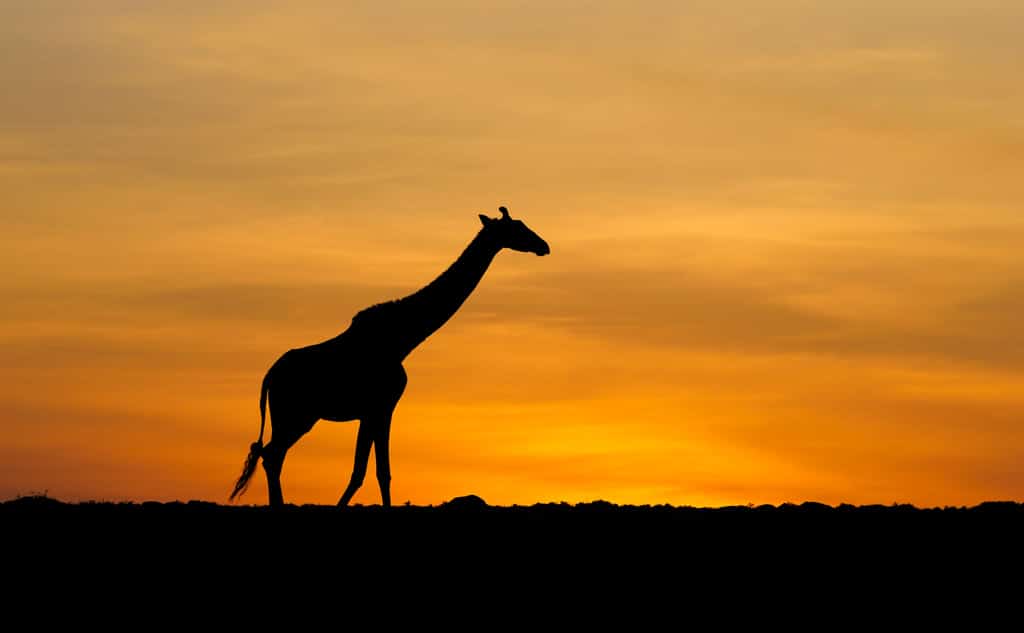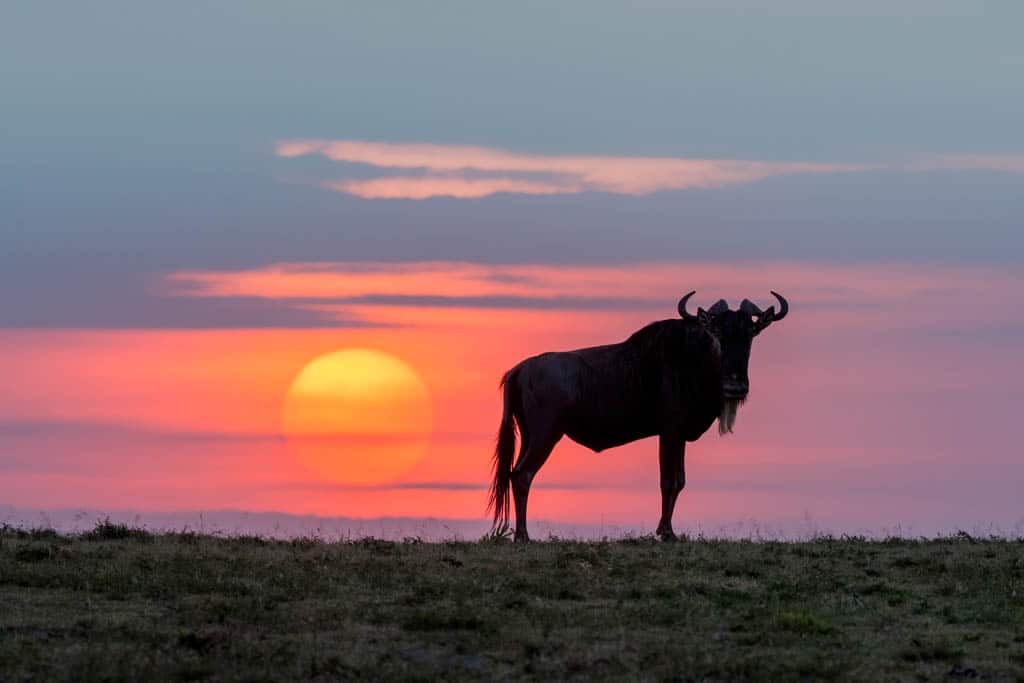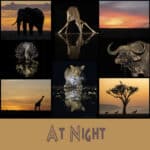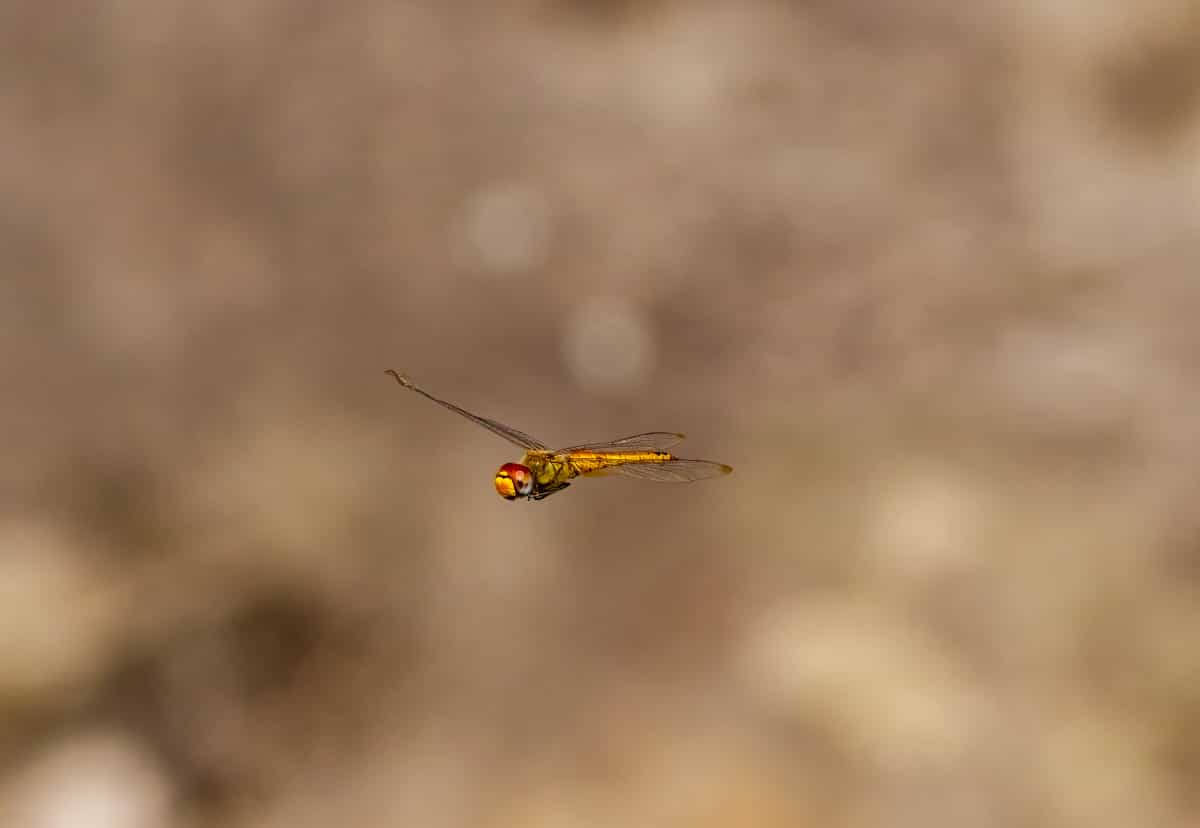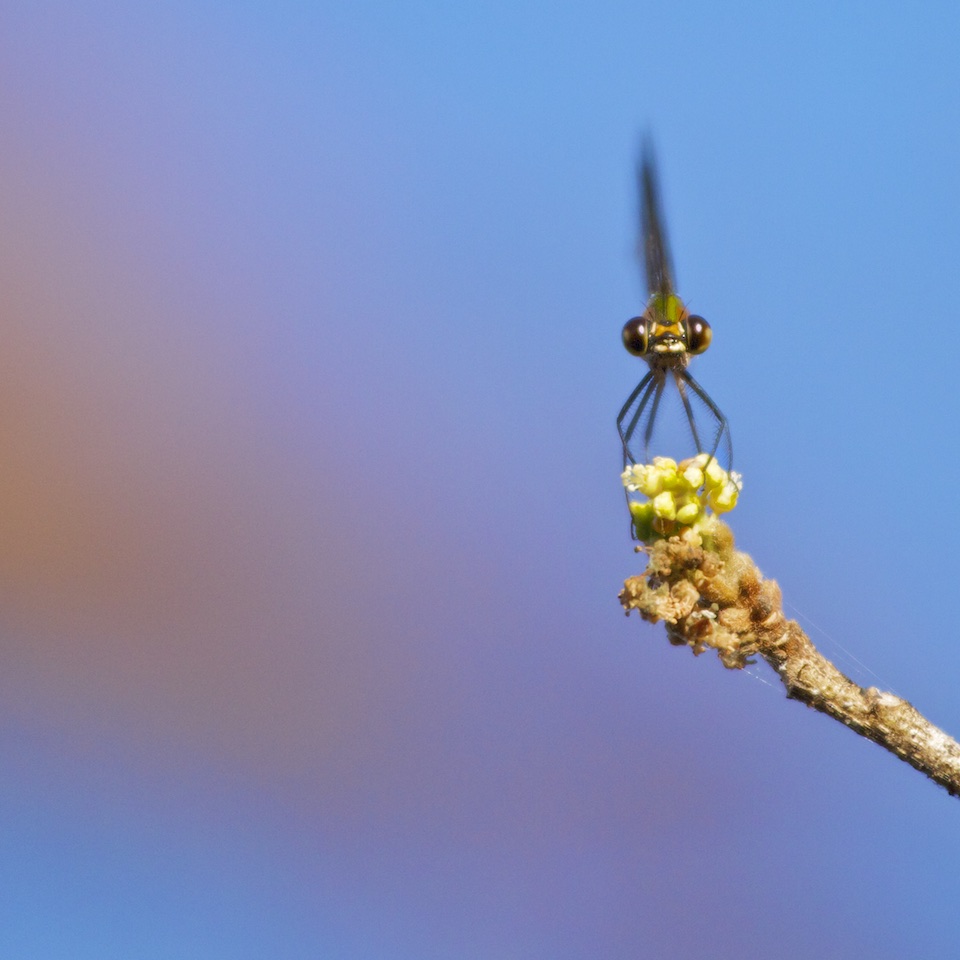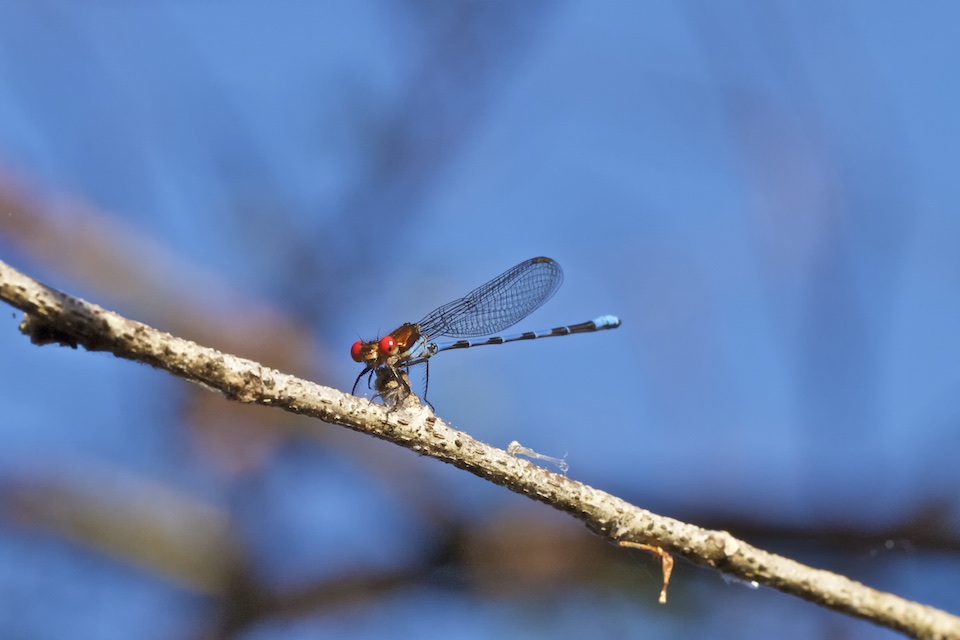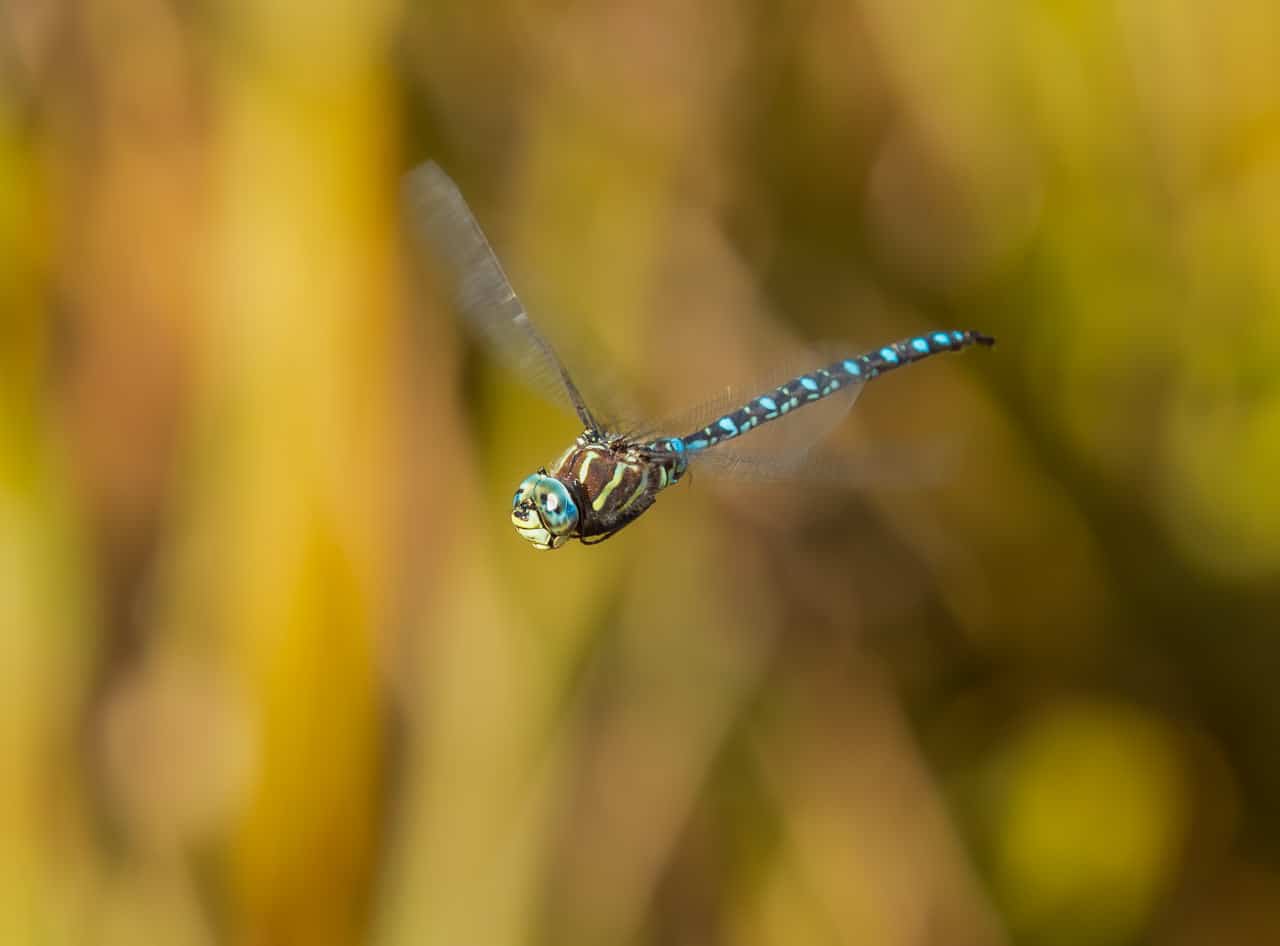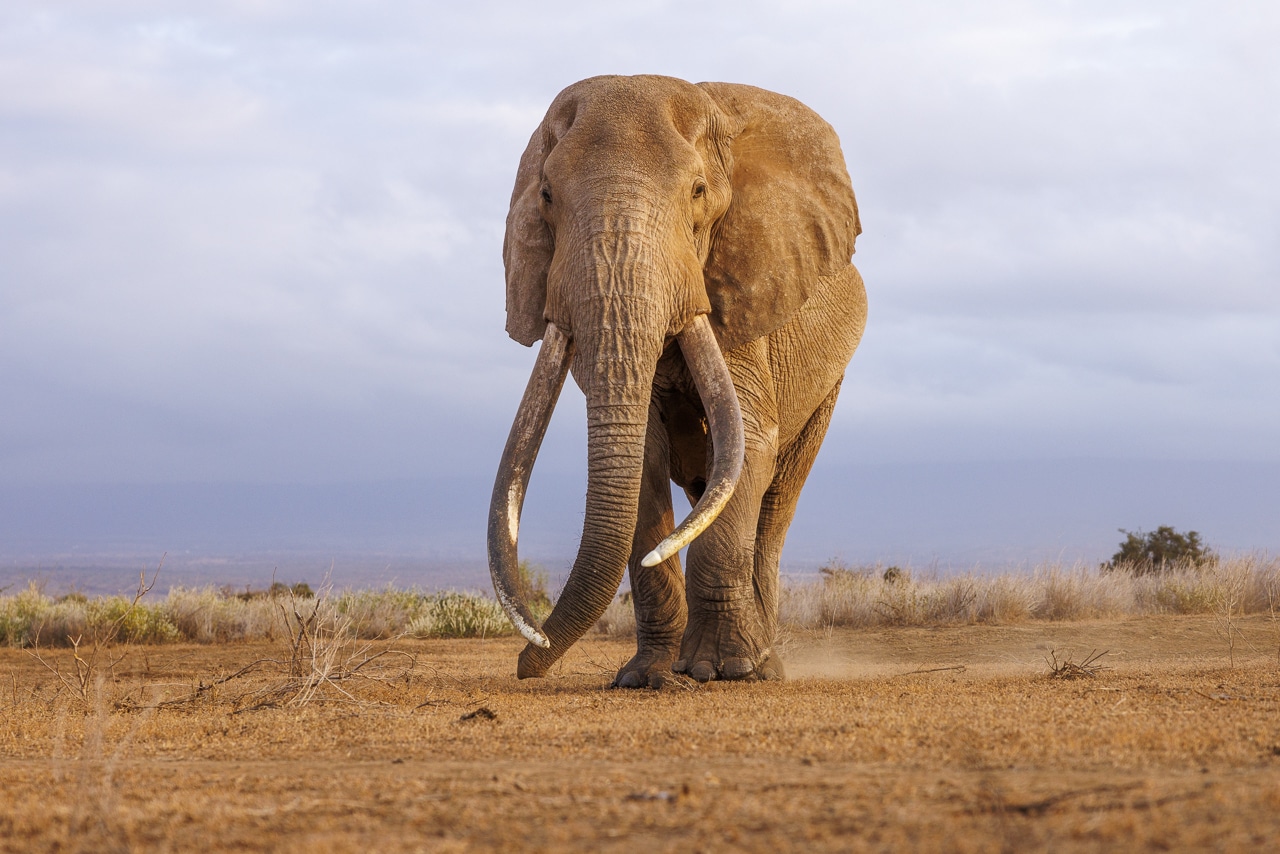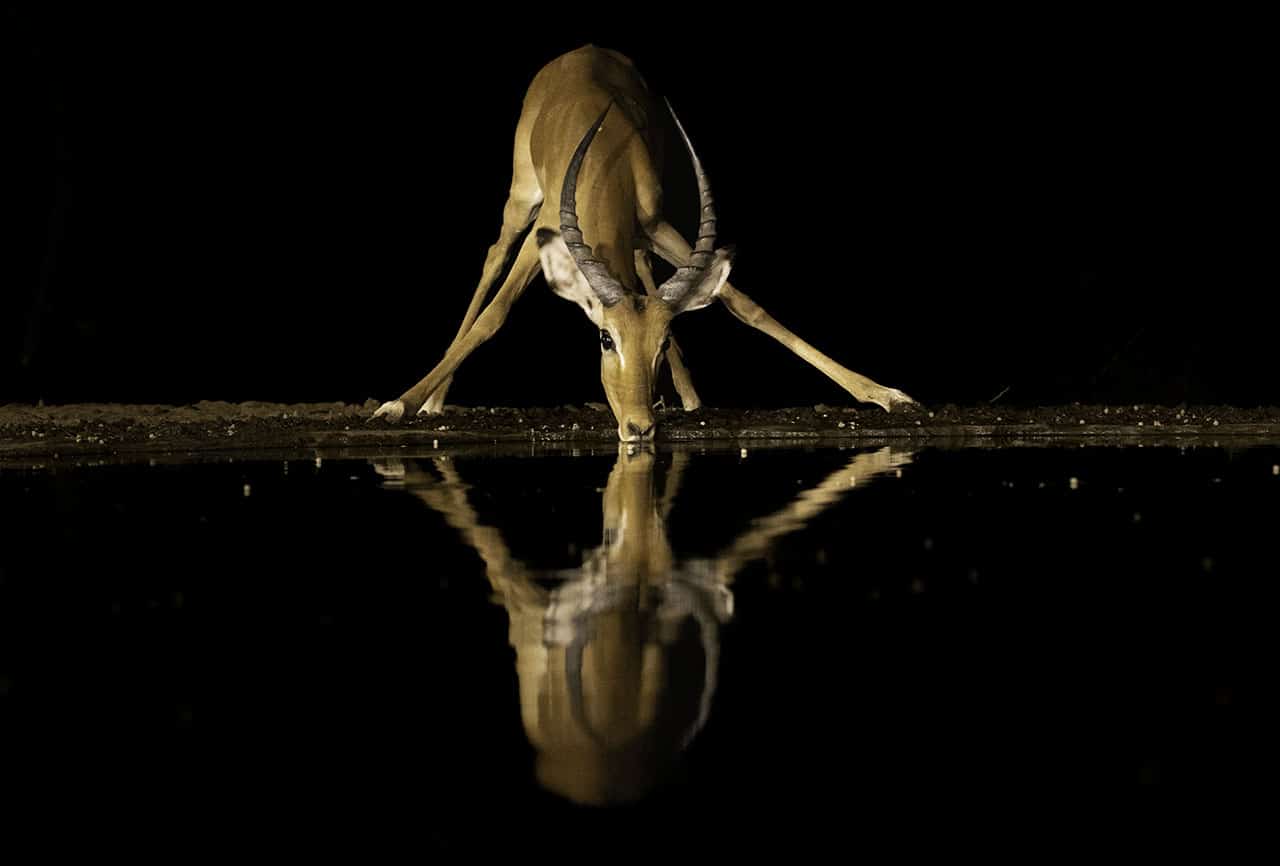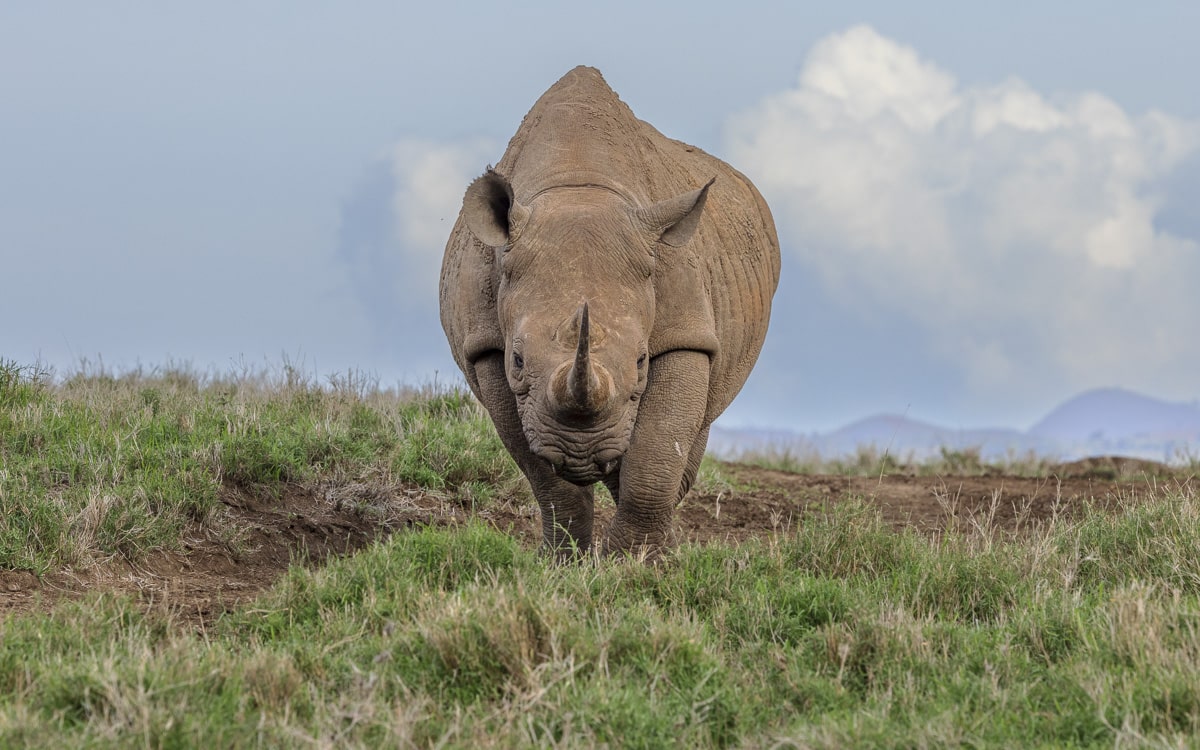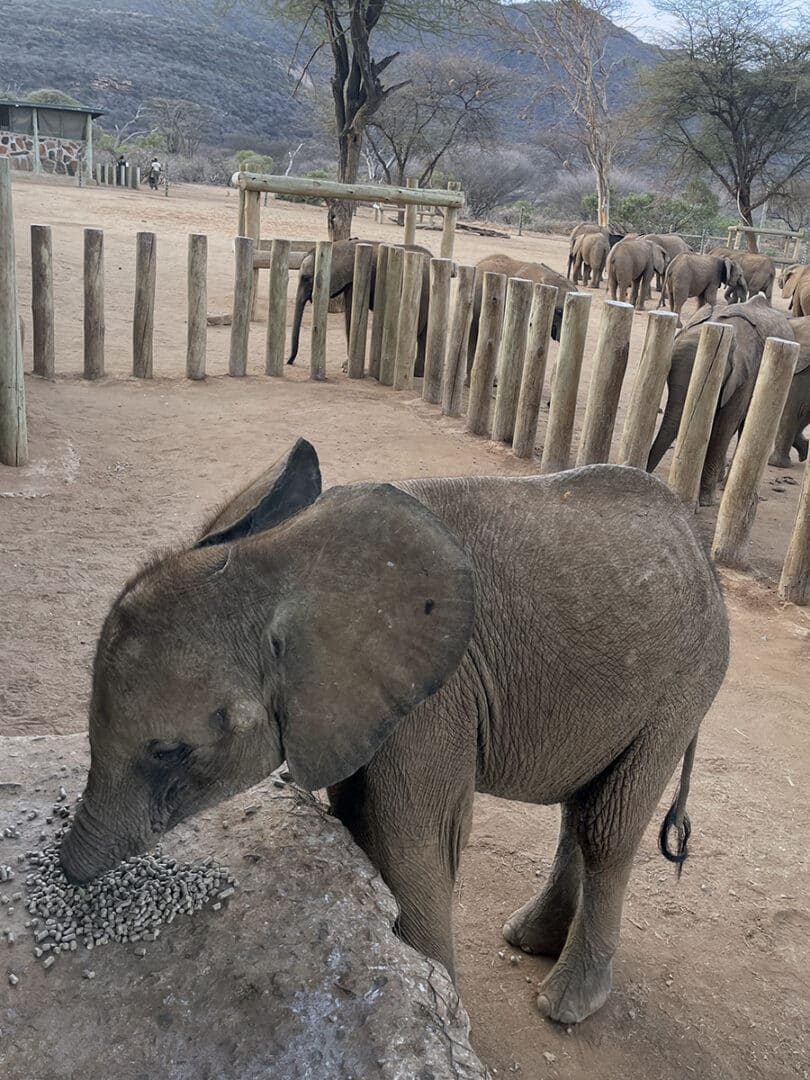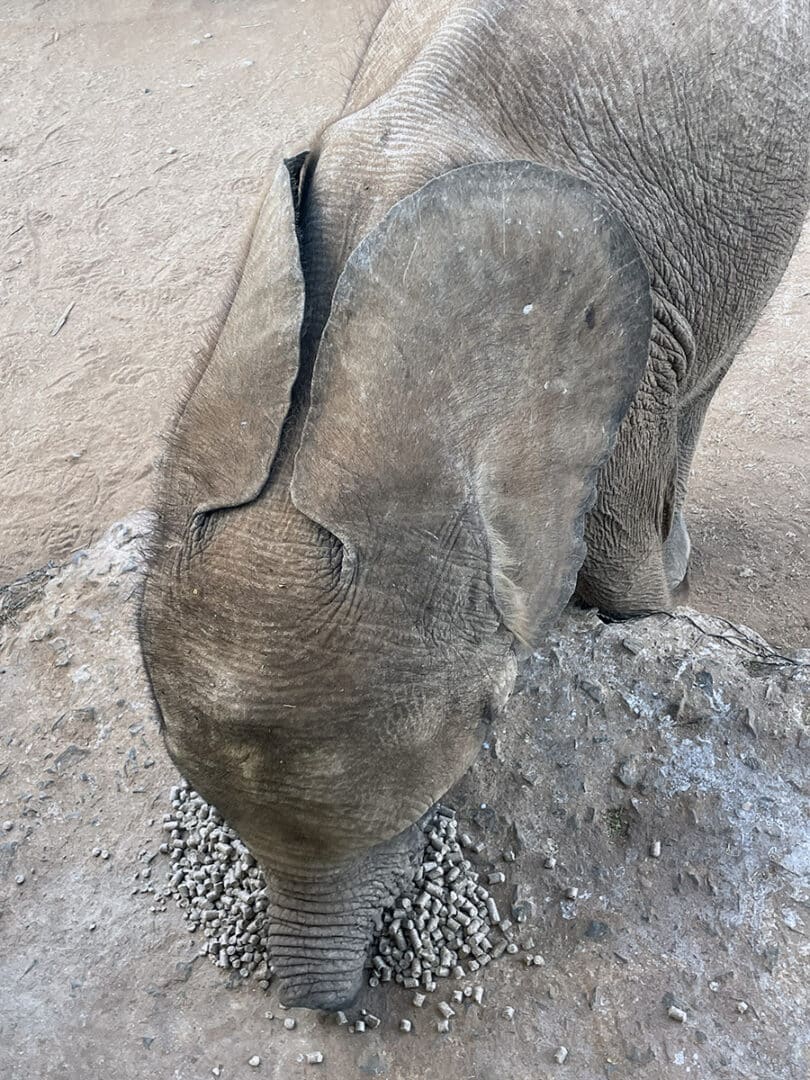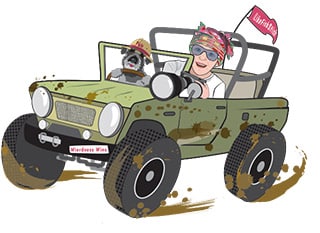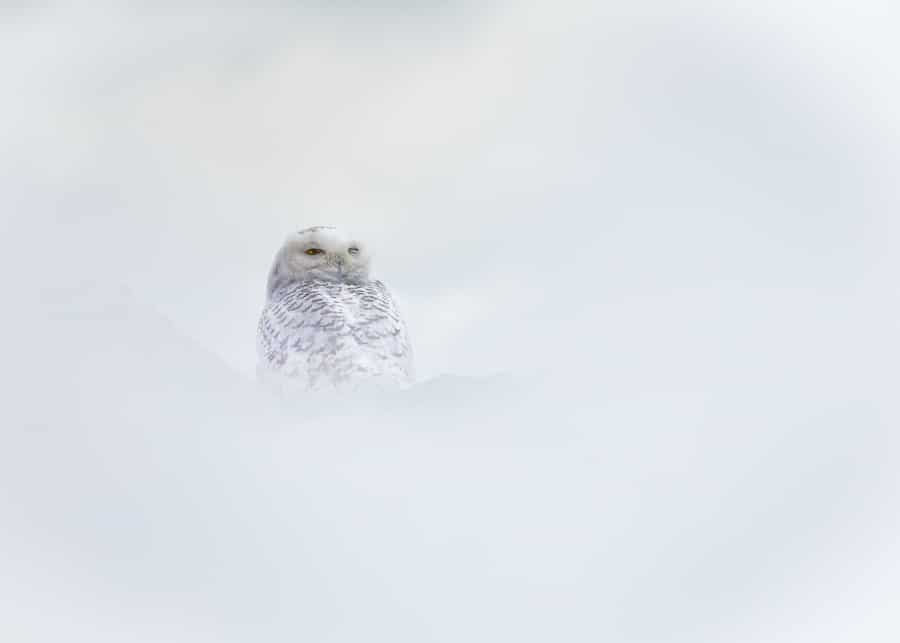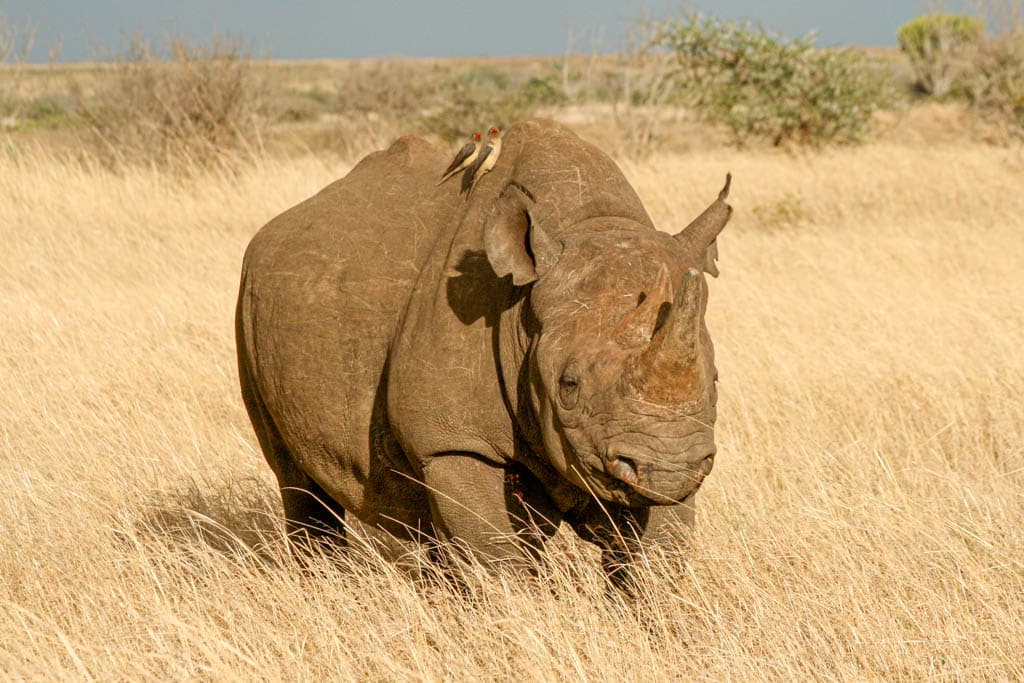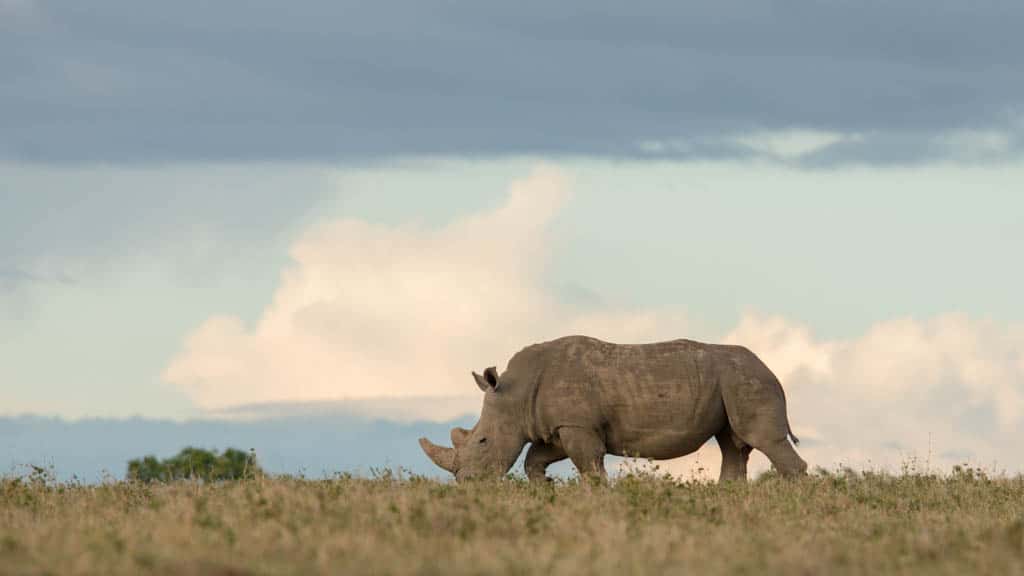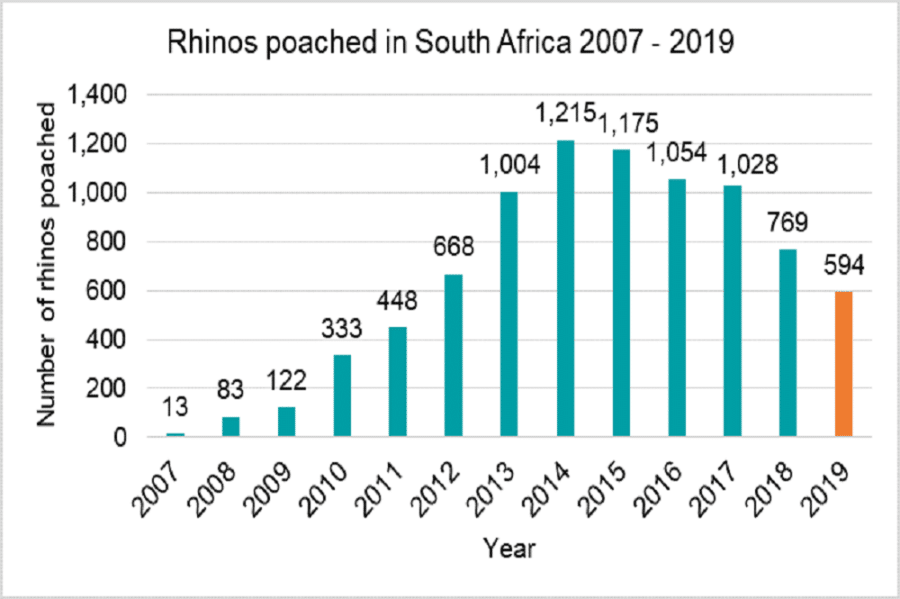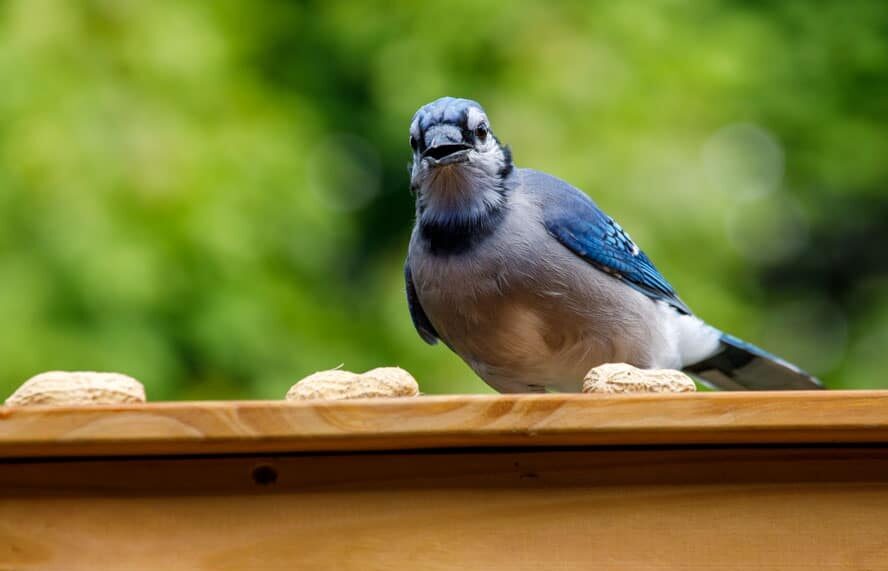Photographing Safari Silhouettes
“Here I am, where I ought to be.” ~Karen Blixen, Out of Africa
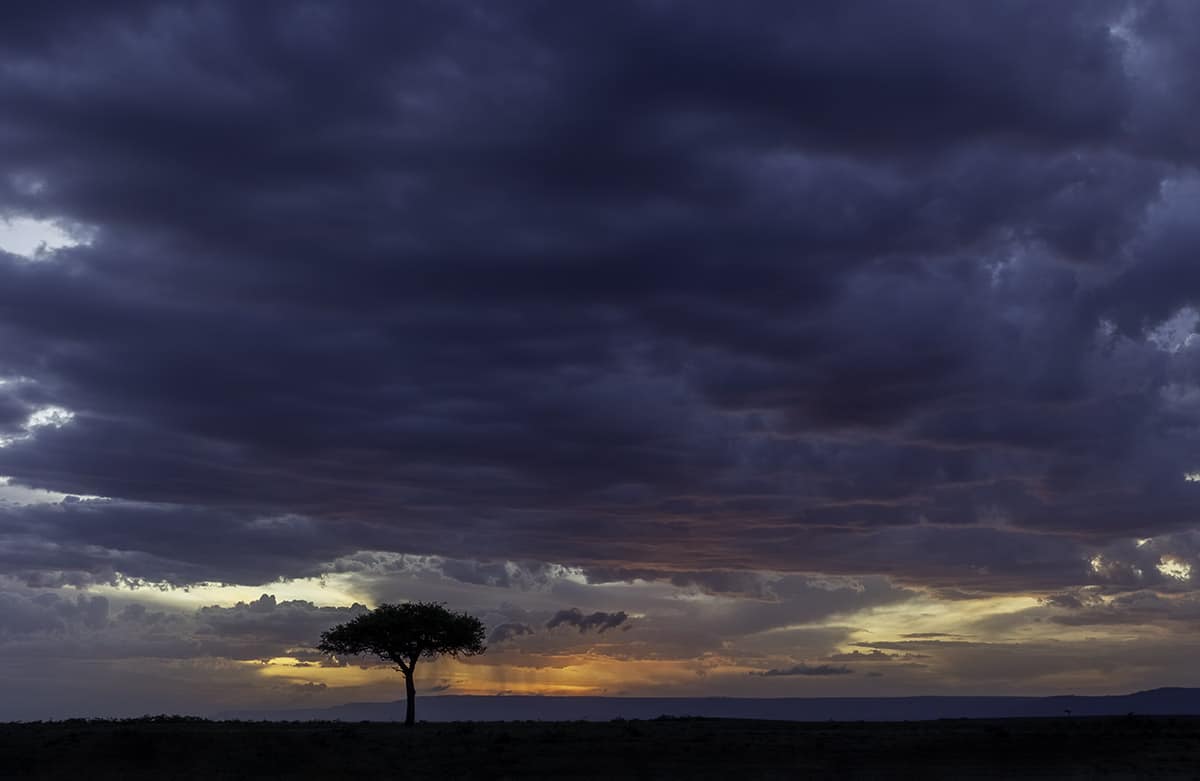
Capturing Iconic Safari Silhouettes
African sunrises and sunsets are very emotional. This magical time of day awakens a deep-rooted desire for peace and tranquility and reminds us of the earth's capacity for unimaginable beauty. There are two very small windows of warm, glowing light in which to photograph safari silhouette–sunrise and sunset.
On my adventures in Kenya I spend most of my time between Kicheche Bush Camp, Valley Camp and Mara North. With the help of outstanding guides, I have had the opportunity to practice photographing wonderful backlit subjects. Capturing safari silhouettes of these iconic African animals, that move with grace through the Mara's dramatic beginning and end of days, is always a great privilege–and a greater challenge!
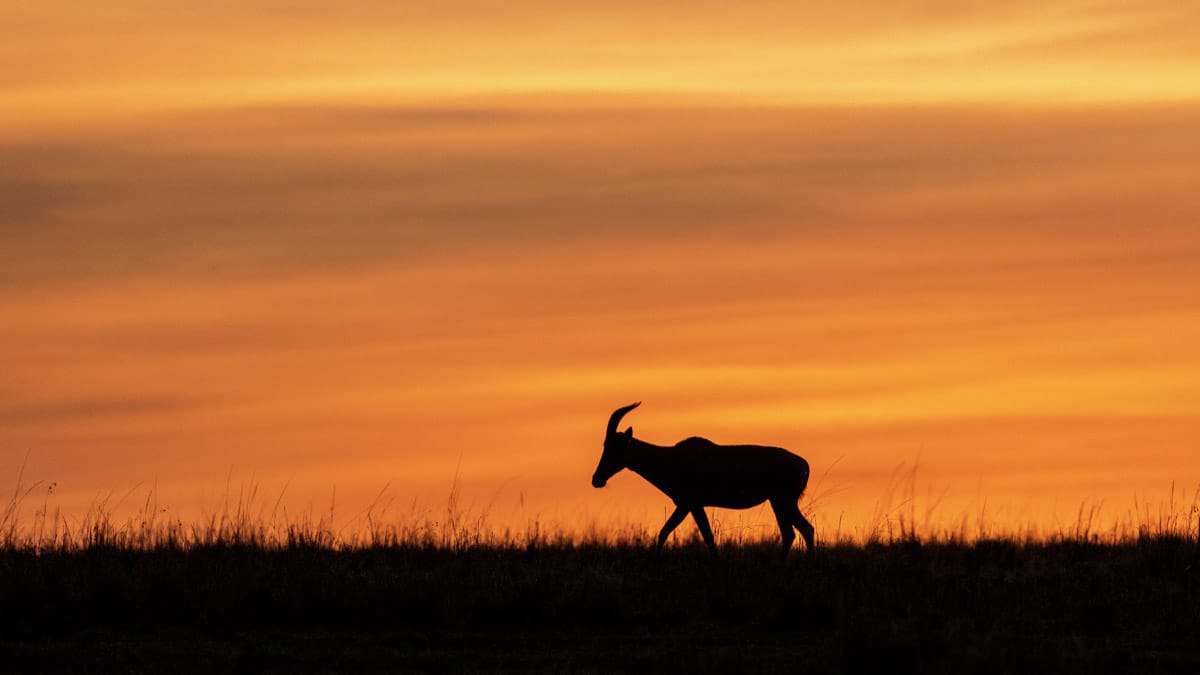
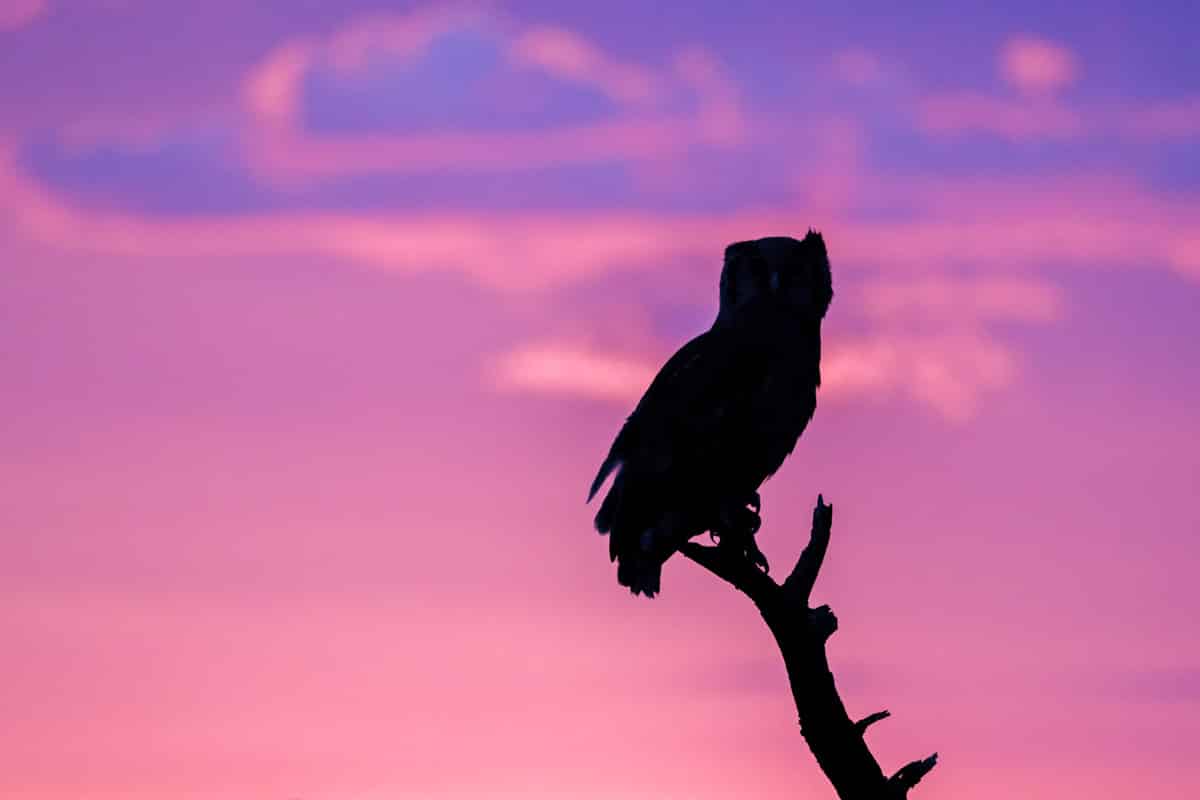 Composing a Safari Silhouette
Composing a Safari Silhouette
One of the key elements of composing backlit silhouette photos is to get as low as possible. You need to create space between the horizon and the shape of the subject. The animal needs to be up high on the horizon with very little foreground. Below, the elephant was not quite high enough or distant enough–but the sheer bulk made for an interesting silhouette shape. Plus-those eyelashes!
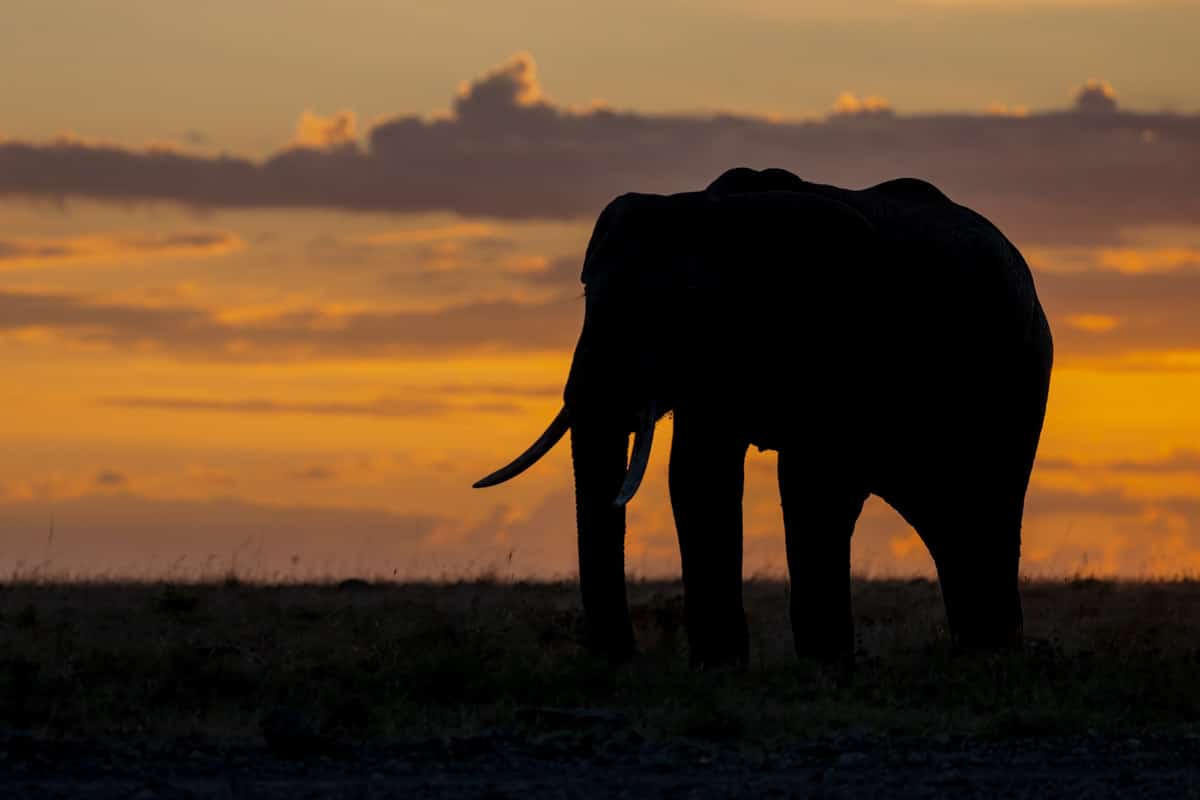
When it is safe, I will often get out of the truck and lie on my stomach in the morning dew-drenched grass to get the maximum elevation of subject. Sometimes it pays off. Sometimes, all I am left with are wet pants and a vivid memory.
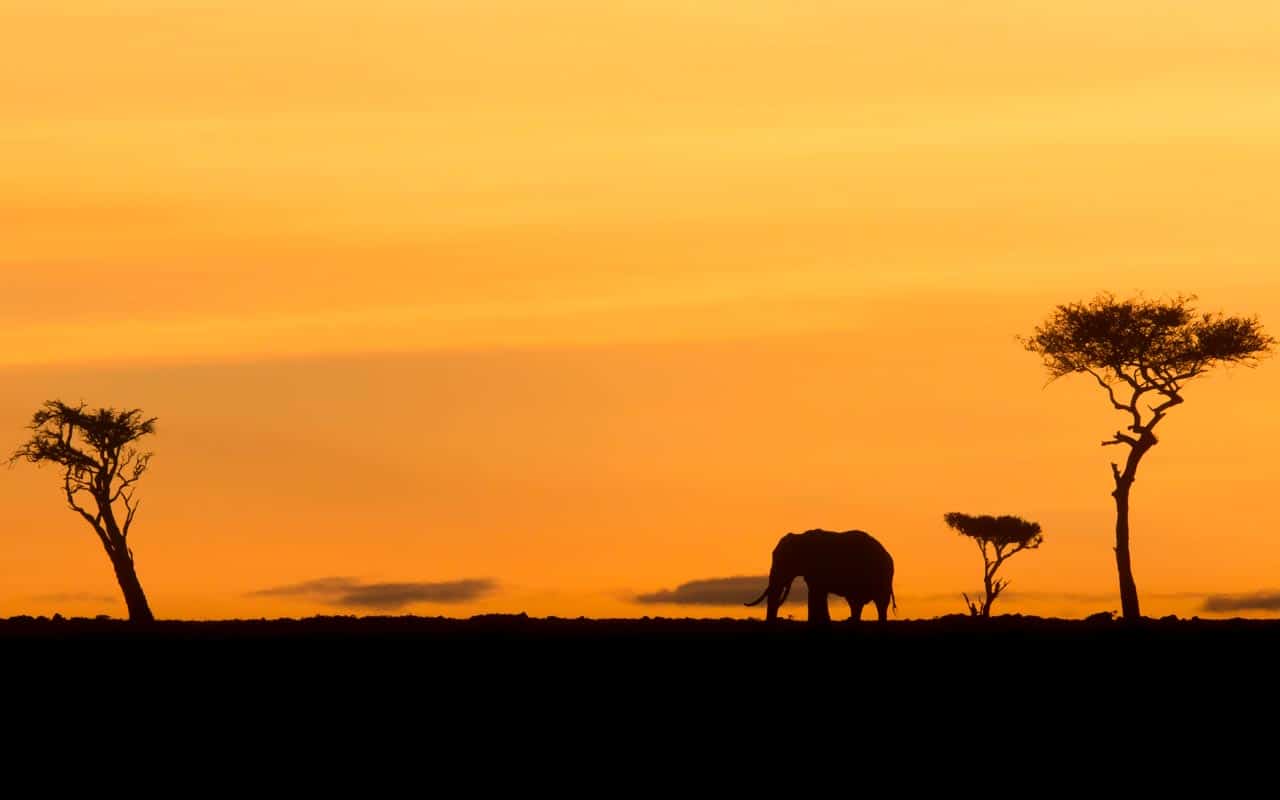
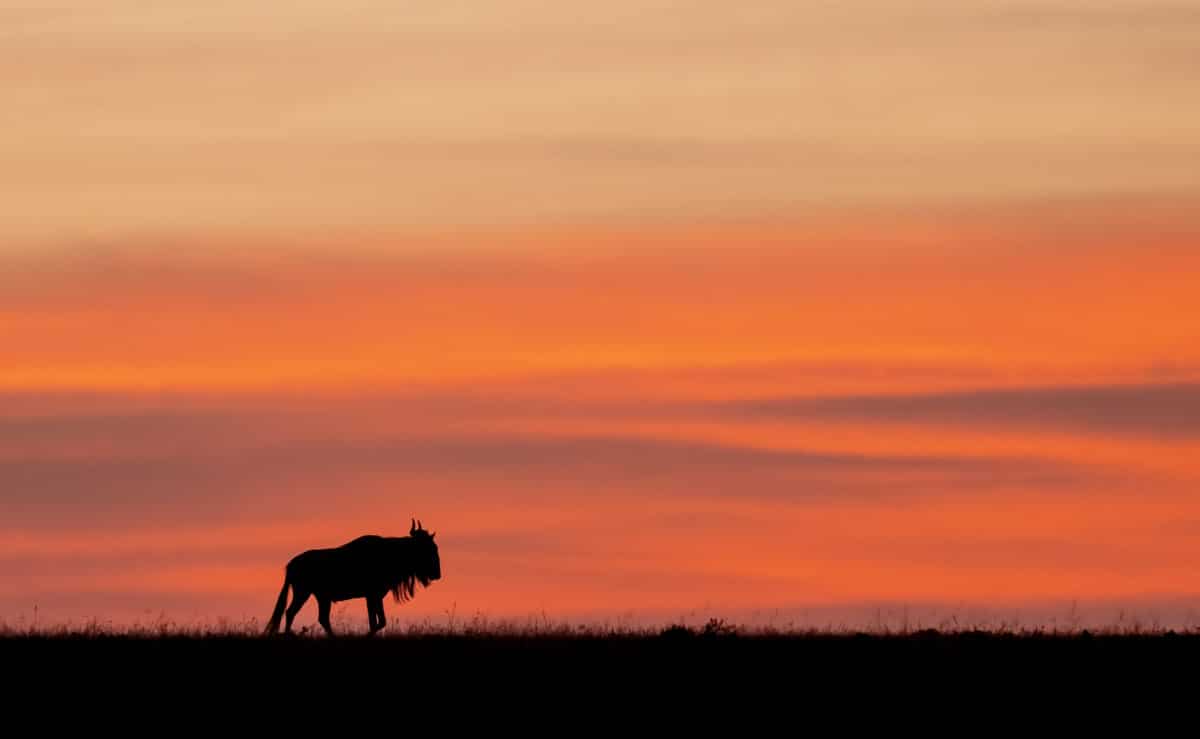
Safari Silhouette: Separating your Photographic Subject
A second challenge is subject separation. While a herd of zebra or wildebeest are amazing to see walking across the horizon, in order to make an impressive capture, the subjects need to be individually separate. They do not always co-operate and you end up with a strangely shaped black mass. Below, the very rare two-headed impala.
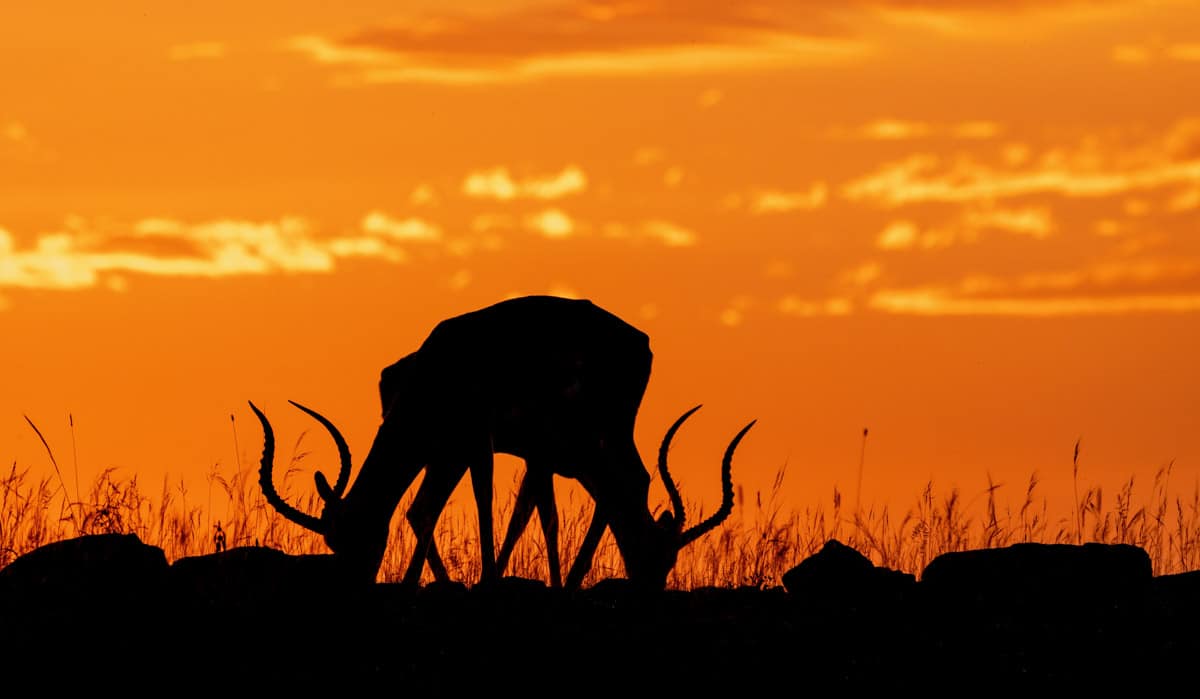
Check out NJ Wight's At Night Wild! Cards!
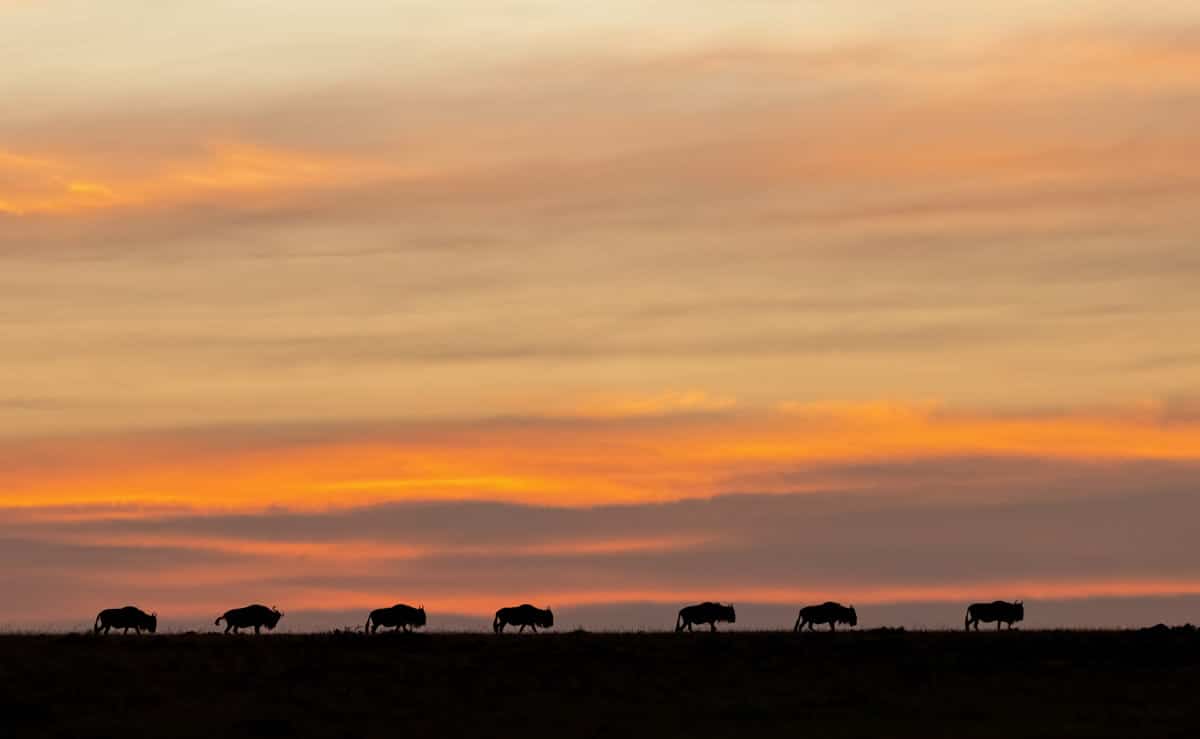
Magical Memories!
Whether I am technically successful or not at taming the exposure and composing the subject, the photos make a memory. They capture those few fleeting moments when one can only marvel at the magical light.
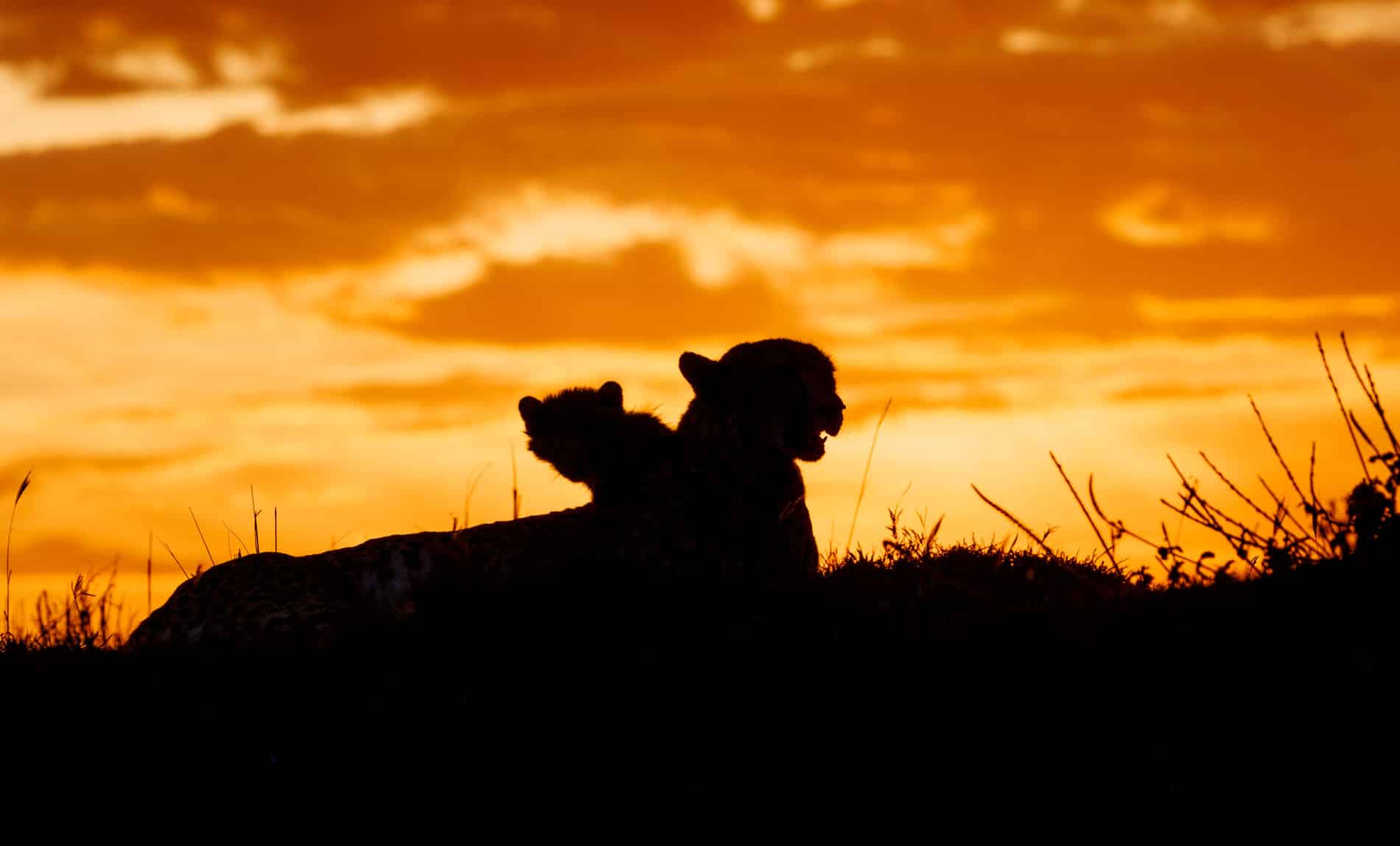
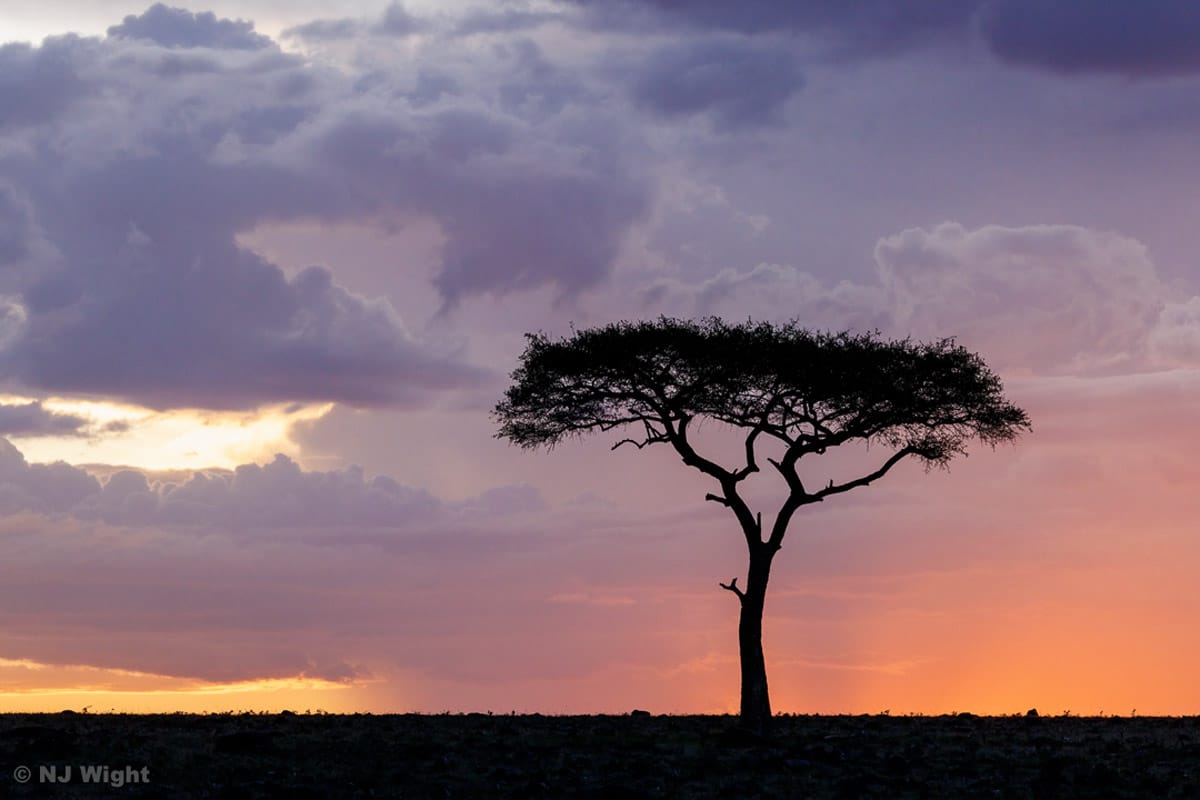
One more thing before you go…
Thank you very much for visiting my website. I support myself as an artist solely with my photography and writing. If you enjoy the content I create and share,, please consider supporting me on KO-FI.COM Becoming a member of the Armchair Wanderers or The Wild Bunch will give you access to exclusive member only content-including behind-the-scene safari shenanigans from my travels. Thank you for your ongoing encouragement and promoting passion.
Cheers!
NJ
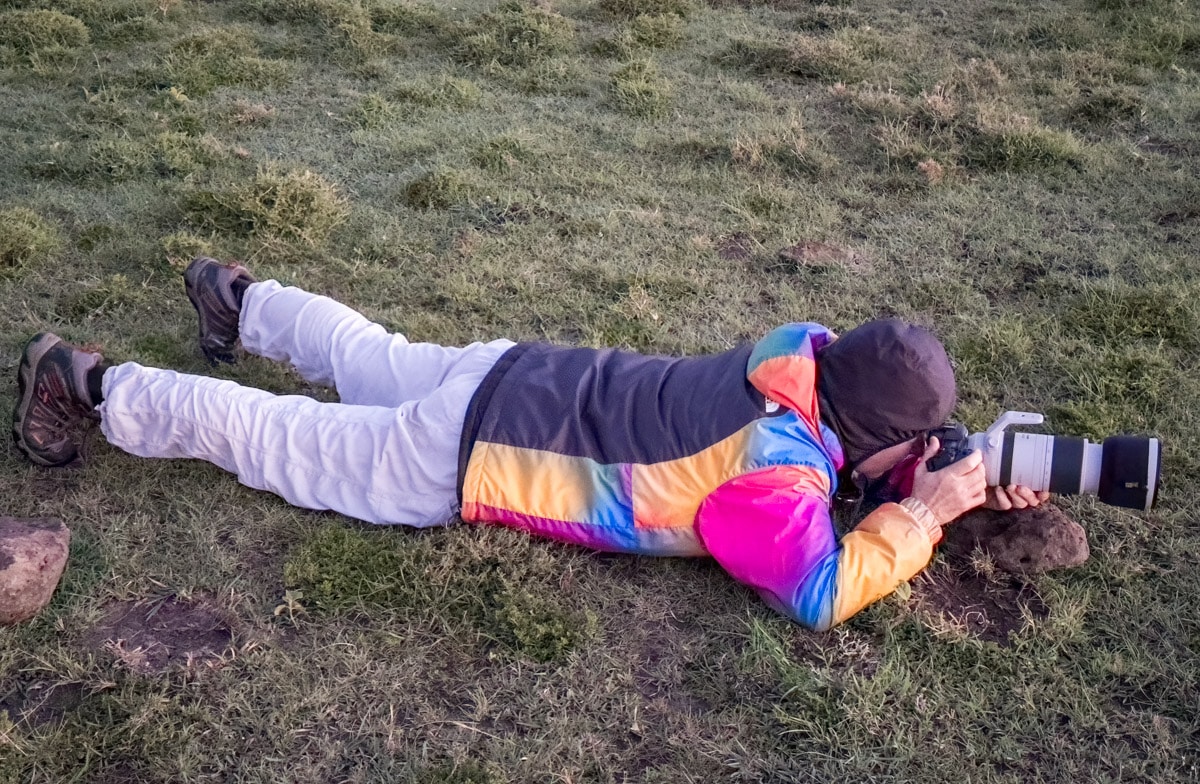
Photographing the Dragonfly in Flight
Dragonflying. The art of photographing the dragonfly in flight. It has taught me patience.
(This post was originally published in 2014 on The Mother Nature Network.)
I have always been intrigued by the elongated shape and erratic movements of the dragonfly. It was only when I started photographing them that I realized how intricate and beautiful they truly were. With their "stained glass window" wings, brightly coloured tails and gigantic eyes, they are a small wonder of nature's design. Part of the odonata order that also includes damselflies, it is believed the dragonfly has been gracing this earth for more than 300 million years.
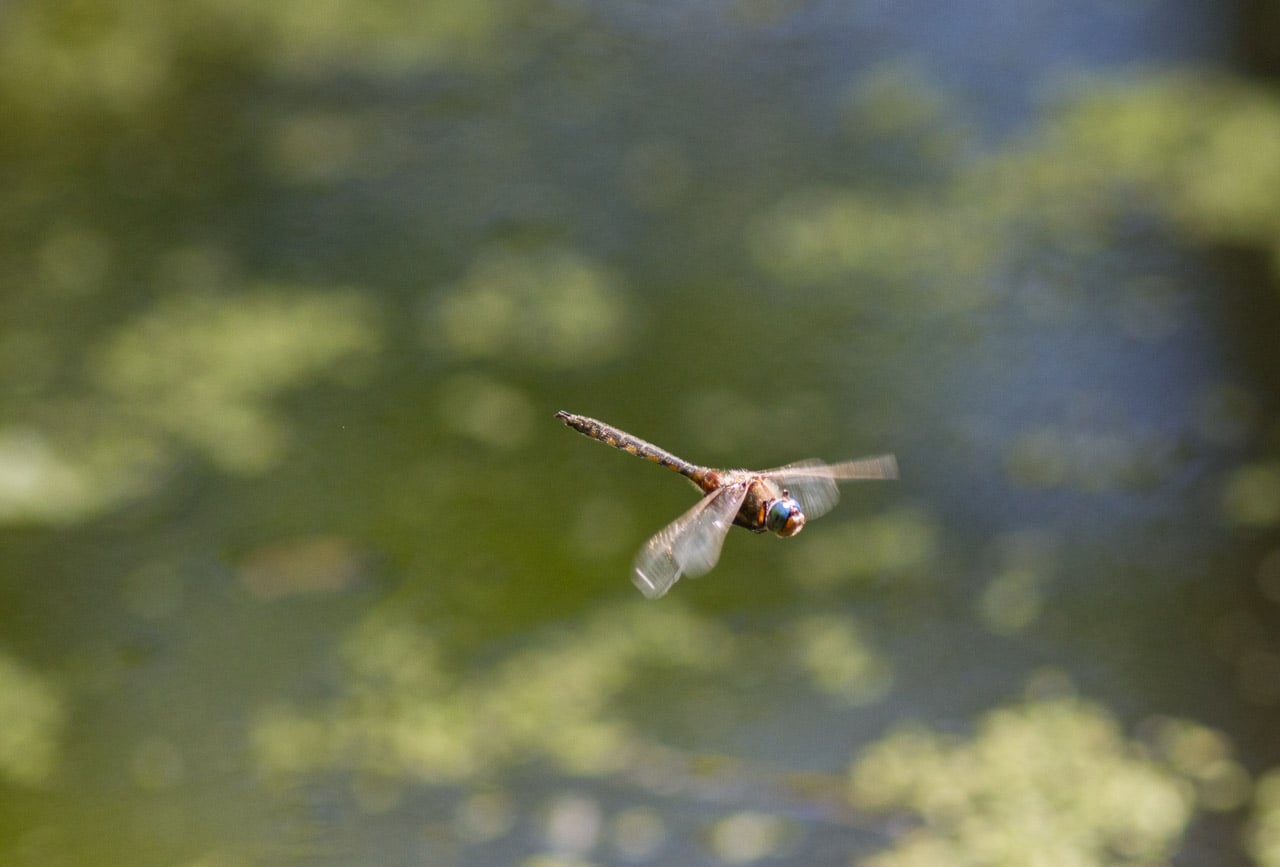 The Dragonfly: A Winged Wonder
The Dragonfly: A Winged Wonder
Unlike other double-winged insects whose wings beat in unison, dragonflies are equipped with two sets of wings that can beat independently. Their front wings can be going up while their back ones are beating down. However, even with two sets they are considered to be slow flappers, so to speak, with an average of 30 wing-beats per second. (Whereas a bumblebee's wings move at about 300 bps.)
The Dragonfly: In Their Eyes
Dragonfly eyes are enormous! While humans have one lens, the dragonfly has many as 30,000 individual lenses. This gives them supreme vision that enables them to respond to stimuli—like an eager photographer—from up to 40 feet away. However, they are often accommodating and often grant you an audience quite close.
They were once referred to as The Devil's Darning Needles and myth would have it that dragonflies would seek out bad children and using their claspers, sew their mouths together while they slept. Sadly, the myth fell apart after rigorous scientific study revealed they had no pockets or handbags in which to cart around needles and thread. In fact, they do no harm to us humans as they neither bite or sting. In fact, they seem intrigued by us and generally come quite close. Frankly, I think they should be more revered as they help control our mosquito population.
The Dragonfly Lifecycle
Dragonflies pass through a fascinating life journey and the time they spend flying around our ponds and lakes is quite a short chapter. They hatch on the surface of the water and can remain in the larva stage for several years. The metamorphosis state brings the growth of wings, at which point, they leave the water and begin their flying lifecycle–the final stage of life. Lasting only a few weeks, this winged-stage is when the dragonfly mates. It is a common sight to see a male and female attached to each other, clinging to a blade of grass, or even mid-flight. Happy times for dragonflies before their precious few weeks of flight-time expire.
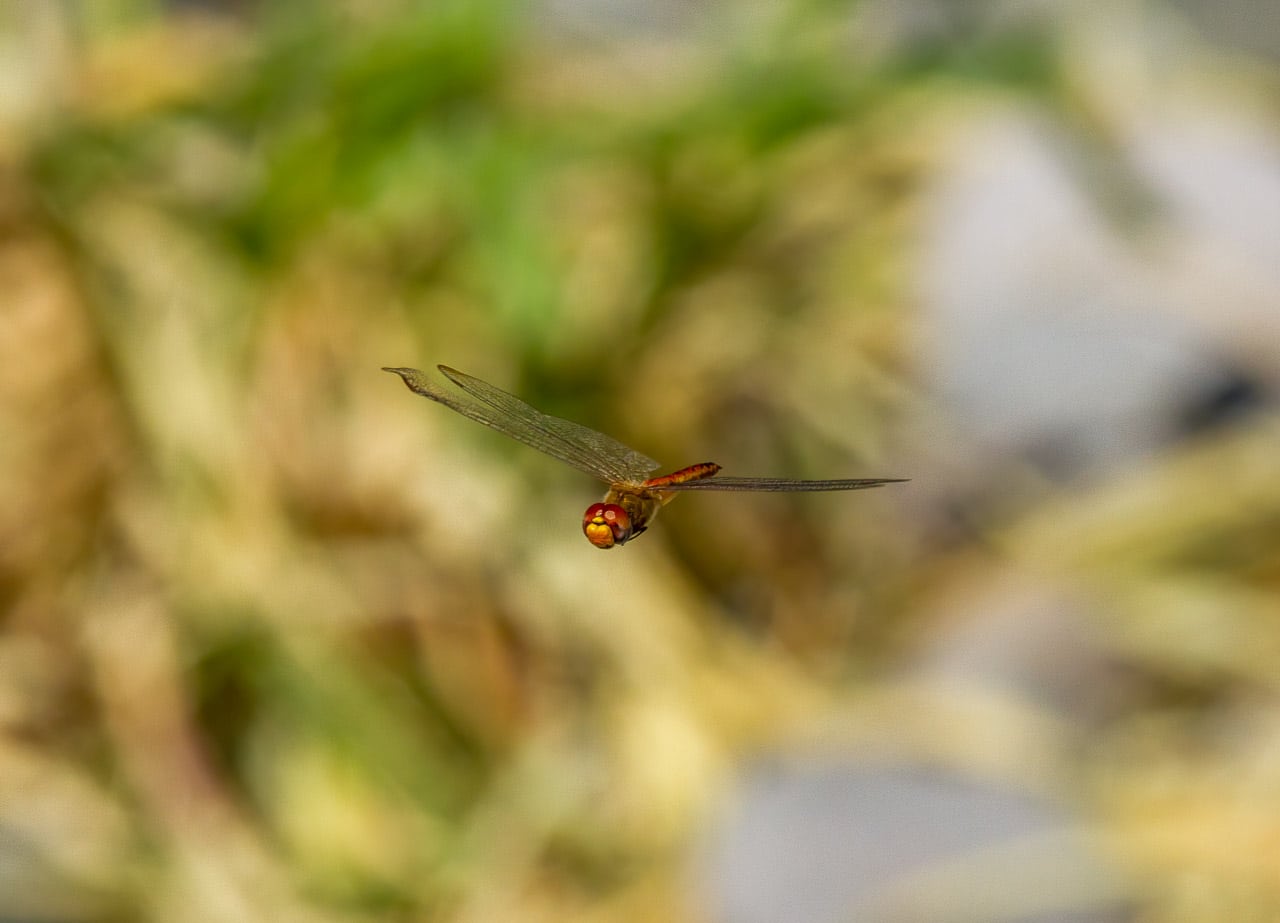
So, the next time you are out on a hike in the woods, kayaking on the lake or relaxing in your garden and you come across a dragonfly, take a moment to watch it dance. Remember, you are privileged to be witnessing the last few days of this graceful creature's life.
The art...and challenge of photographing the dragonfly
I am grateful to the dragonfly as it is teaching me patience. It is a great challenge to capture them in flight. I am generally impatient waiting for microwave popcorn, so, imagine standing in one spot for fifty minutes, trying to focus and track spasmodically flying winged-things? Not exactly in my comfort zone. But I love the challenge! I think of it as a zen meditation — with swearing.
The photographs here were taken with either a Canon 5D Mlll or a 7D. I was using a 70-200 f4 IS L lens, which is fairly fast, and quite light for hand-holding. After a few false starts and focusing trial-and-errors, I would find my rhythm. Coincidentally, it corresponded with finding the dragonfly rhythm. These winged-things are really quite the unreliable, drunken flyers that change direction and altitude very quickly. But–they also hover—and that is the key moment to watch for.
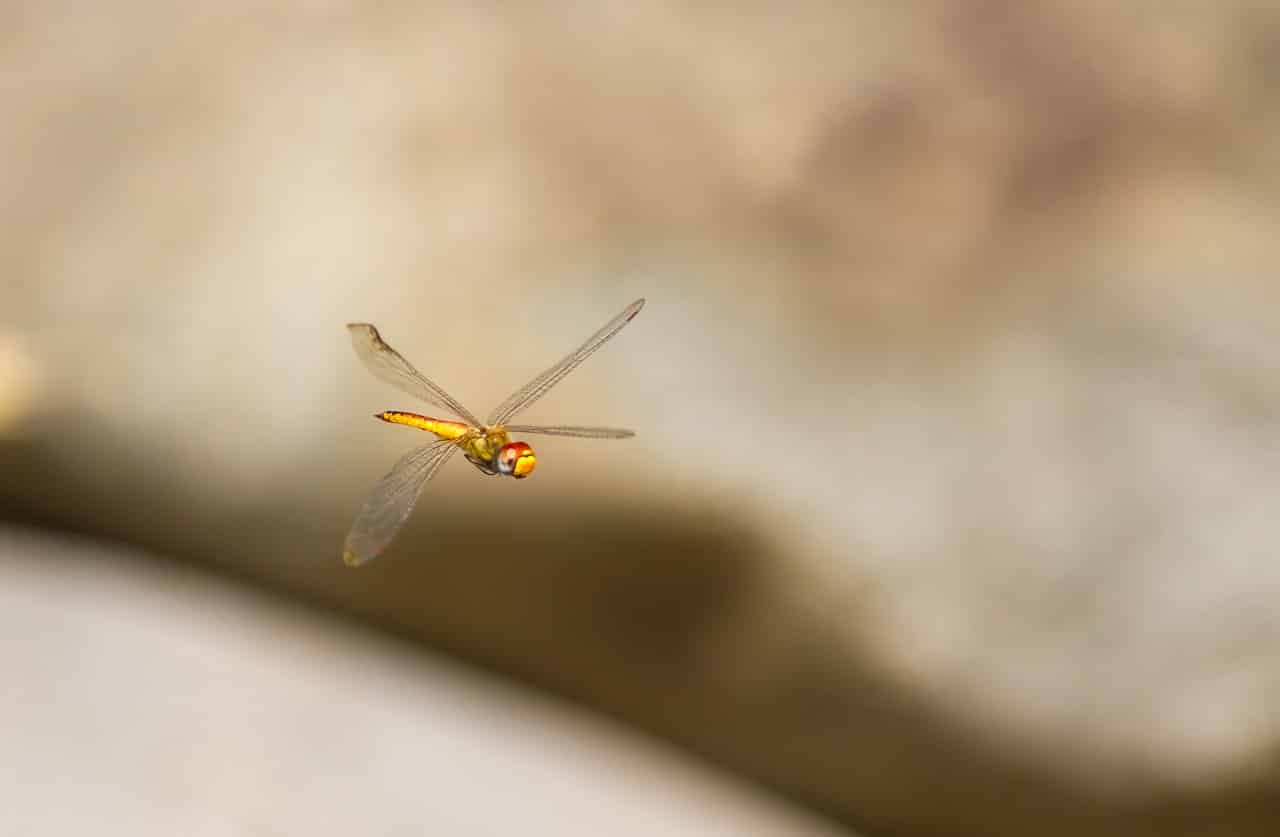 Anticipation!
Anticipation!
I have learned to anticipate and concentrate on that momentary hoover. Once I find my way with tracking and focus, and I seem to have to re-learn this every single time, I am able to concentrate on composition. Luckily, these subjects enjoy flying around bushes and moss-covered water allowing for opportunities to explore creative and contrasting backgrounds with which to create interesting bokeh. (Bokeh is that nice, softly blurred background you sometimes see in photographs) Perhaps a little catch of light dancing off the wings–is that too much to ask for?
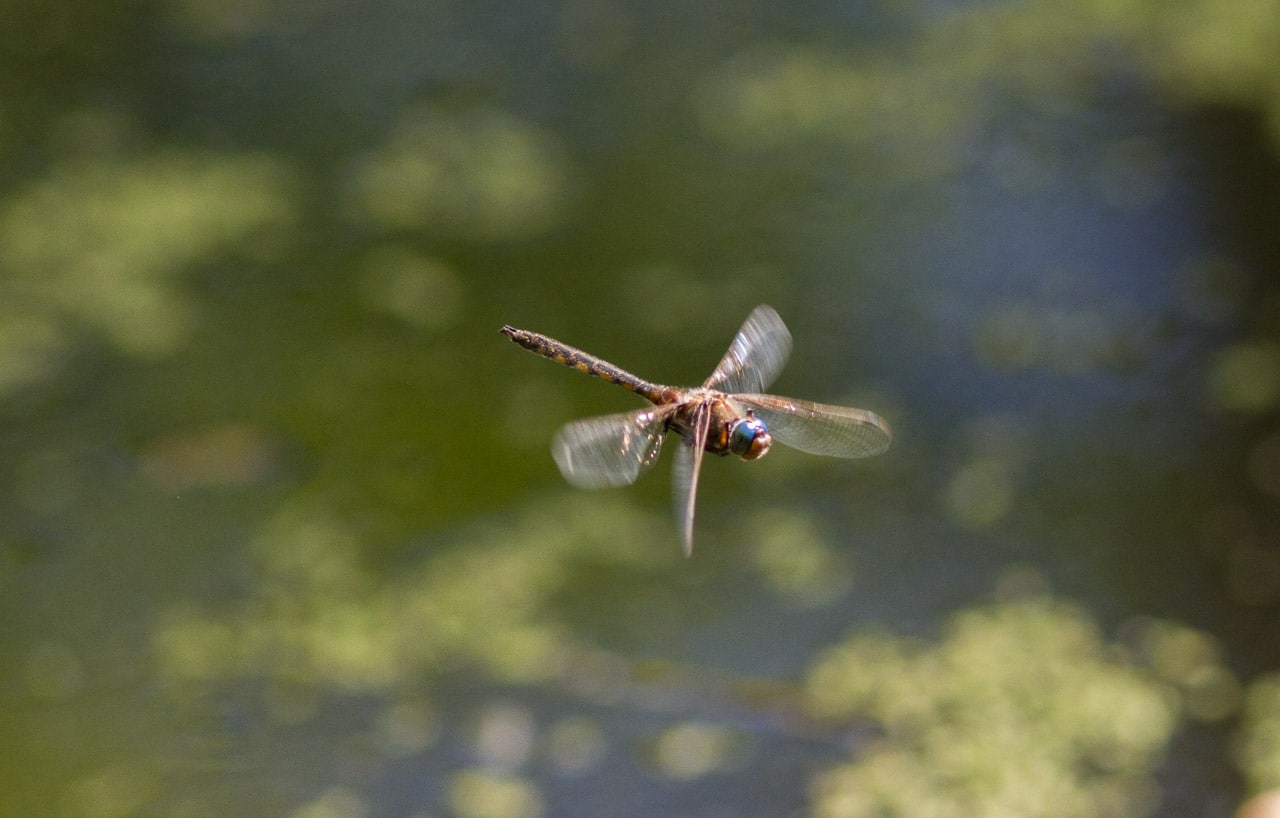
They do not make it easy! Often, when I manage to nail the focus, I have not had a fast enough shutter speed to freeze the wings. Or, I manage the right shutter speed, but just as I take the shot, they sharply turn and there is nothing but tail. No matter what happens, it is always good fun and very good practise!
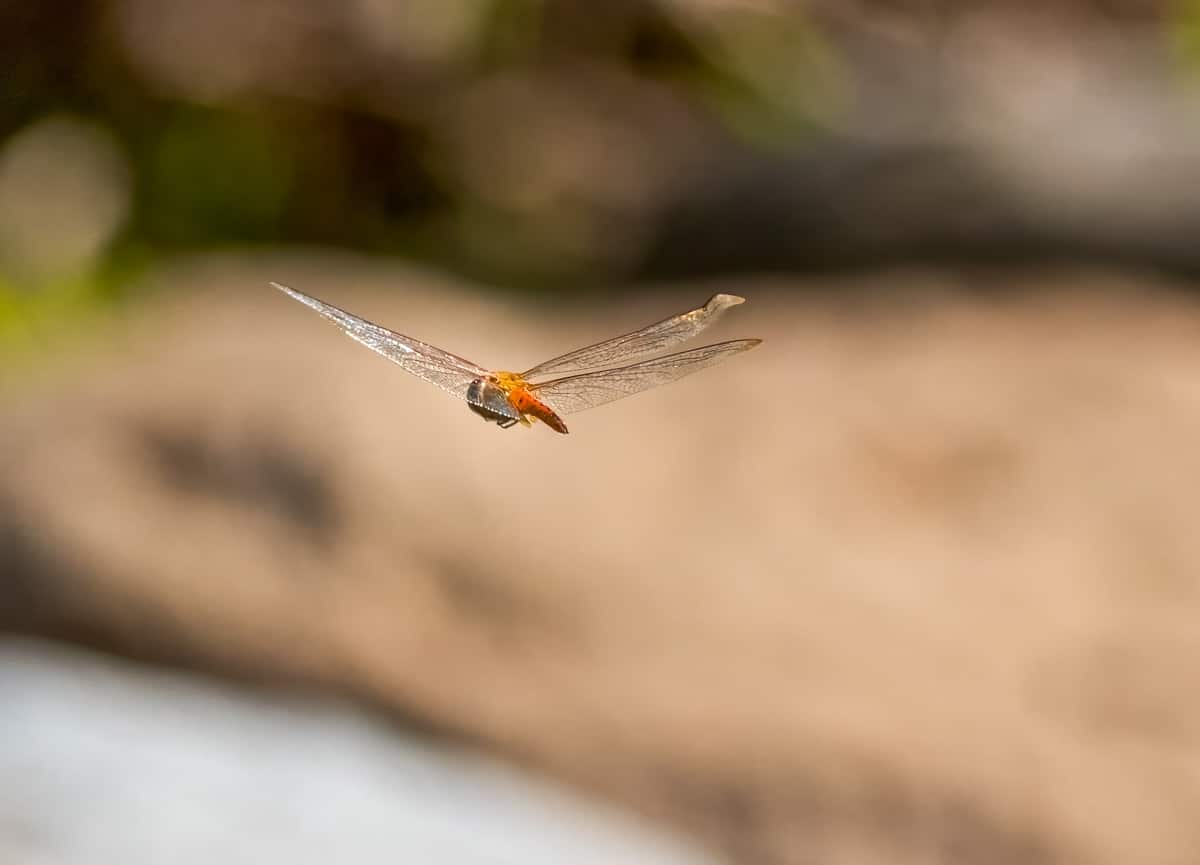 One more thing before you go…
One more thing before you go…
Thank you very much for visiting my blog. I support myself as an artist with my photography and writing. If you enjoy my content and would like more, please consider supporting me on KO-FI.COM Becoming a member of the Armchair Wanderers or one of The Wild Bunch will give you access to exclusive member only content-including behind-the-scene safari shenanigans from my travels. Thank you for your ongoing encouragement and promoting passion.
Cheers,
NJ
Meeting the Legend Craig
This past month I visited Amboseli National Park and I met Craig the tusker–a wildlife legend. It was an absolute privilege and life-long memory. Amboseli is home to one of the largest concentrations of elephants in east Africa. There are probably more than 2000 living in this small park. That’s what you come here for. Amboseli is also home to some of the last “tuskers” remaining in Africa. Tuskers are very large-tusked elephants and there are thought to be about 25 remaining. Craig is Kenya’s largest tusker and is now 51 years old. (You can ask the googles-he is quite famous!) Last week, with the help of David, one of his guardians in the wild, I was able to spend 2 evenings with him and his tusker pal, Pal. Meeting any elephant up close is always an emotional experience and I have been blessed to have had many close and exciting encounters.(Like this one in Zambia.) But coming face-to-face with a huge bull, wielding tusks that weigh in at over 50KG a piece, well, that was EPIC!
Meet Craig the Tusker!
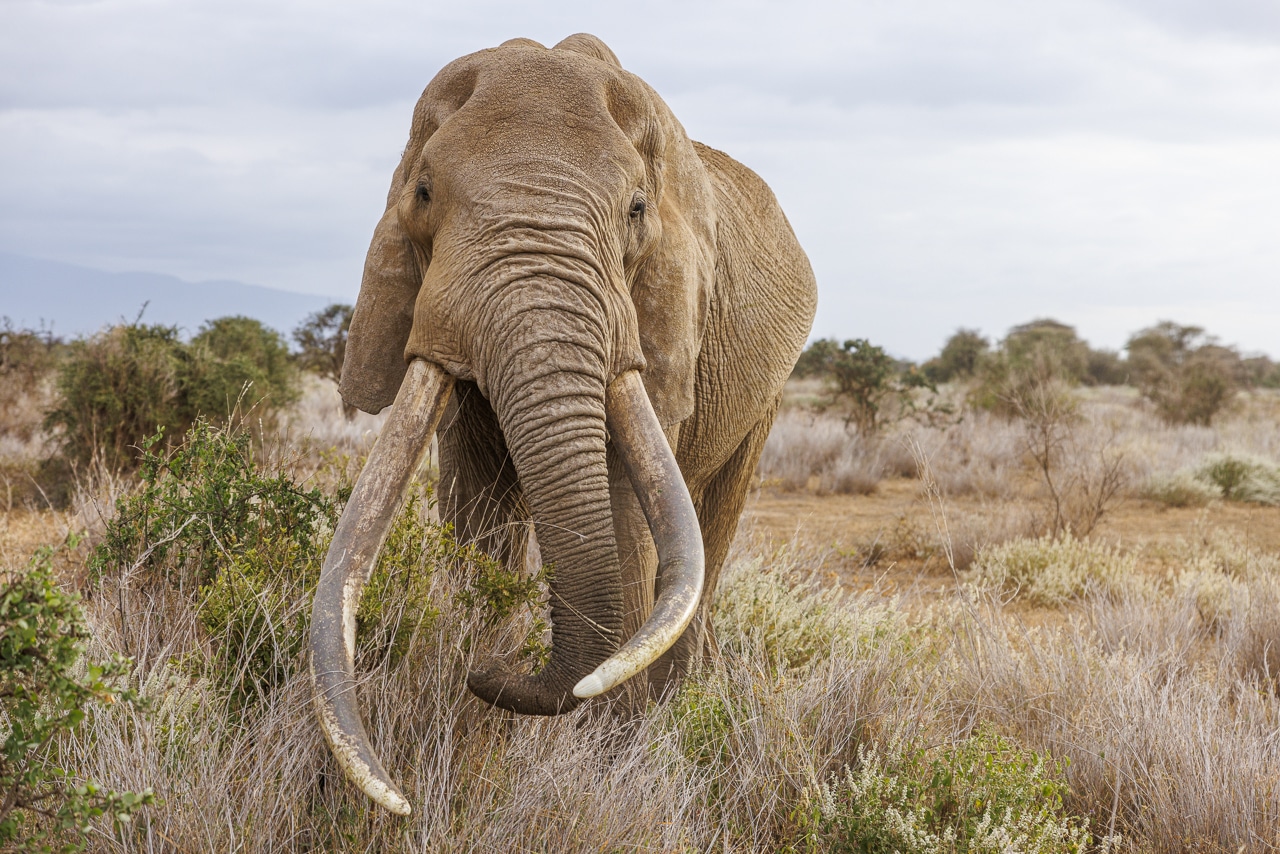
Meeting Craig's Guardian–A Conservation Hero!
David is a Maasai who has been following Craig for years. He is one of the conservation gaurdians trying to keep these magnificent animals from disappearing. Tuskers have a genetic marker that results in their huge tusks. If these boys cannot continue to mate, we will lose them forever. I was in awe of David as much as I was Craig! (Elephant guardian was never mentioned at career counselling in high school…)
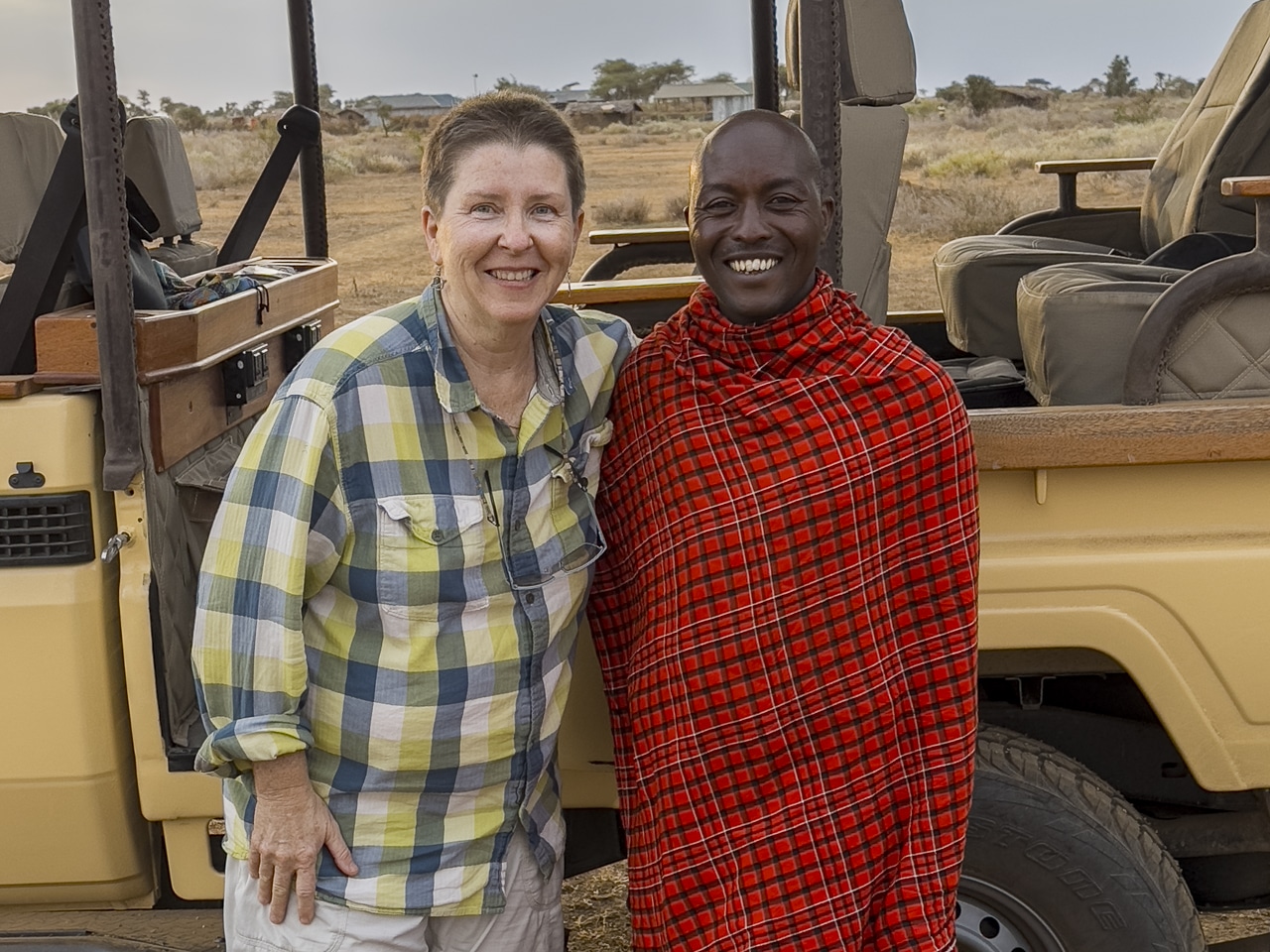
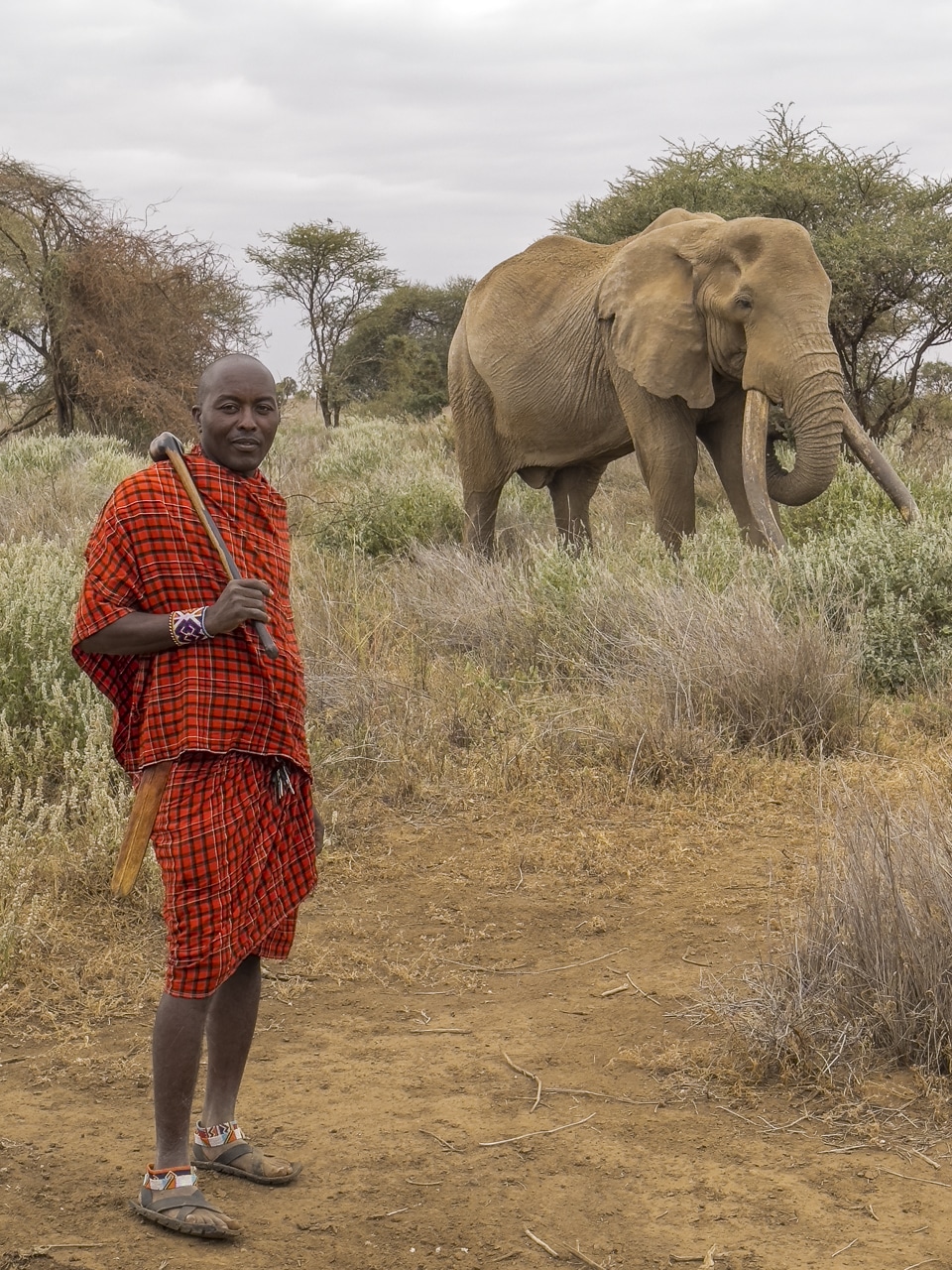
For more than two hours each night we hung out with Craig, watching him snack his away around the bush as the light disappeared. He is a very mellow and relaxed elephant. Pal, on the other hand, was a little more feisty. So, we kept a respectable distance from him. When Pal moved off, I was able to get out of the truck with David to try shooting from ground level. This is not something you get a chance to do often and elephants are the absolute best subject for this kind of perspective, exaggerating further their enormous size! I have not had much practice doing this, plus, I confess to being so mesmerized I forgot to adjust settings on my cameras.
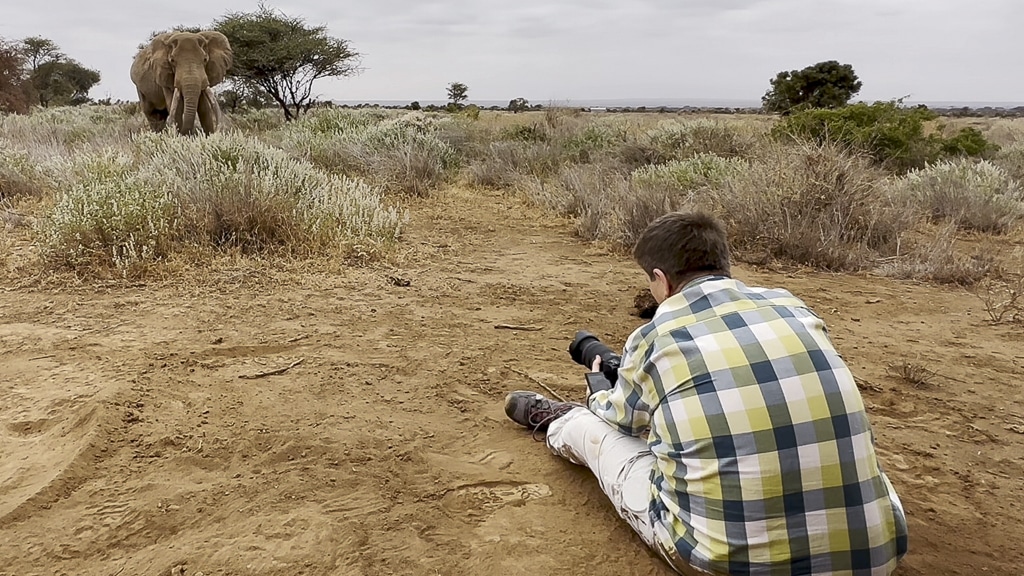
At one point, I was sitting in the dirt with my back against the truck tire and Craig came sauntering by, likely just a couple meters away. He definitely didn’t fit in the viewfinder! My brain was exploding–let's just say the horizon was not the only thing tilting. Thankfully, his “fifth” leg was mostly retracted when he sauntered by. Those are known to swing widely and I was at risk of being slapped. (Shot at 24m)
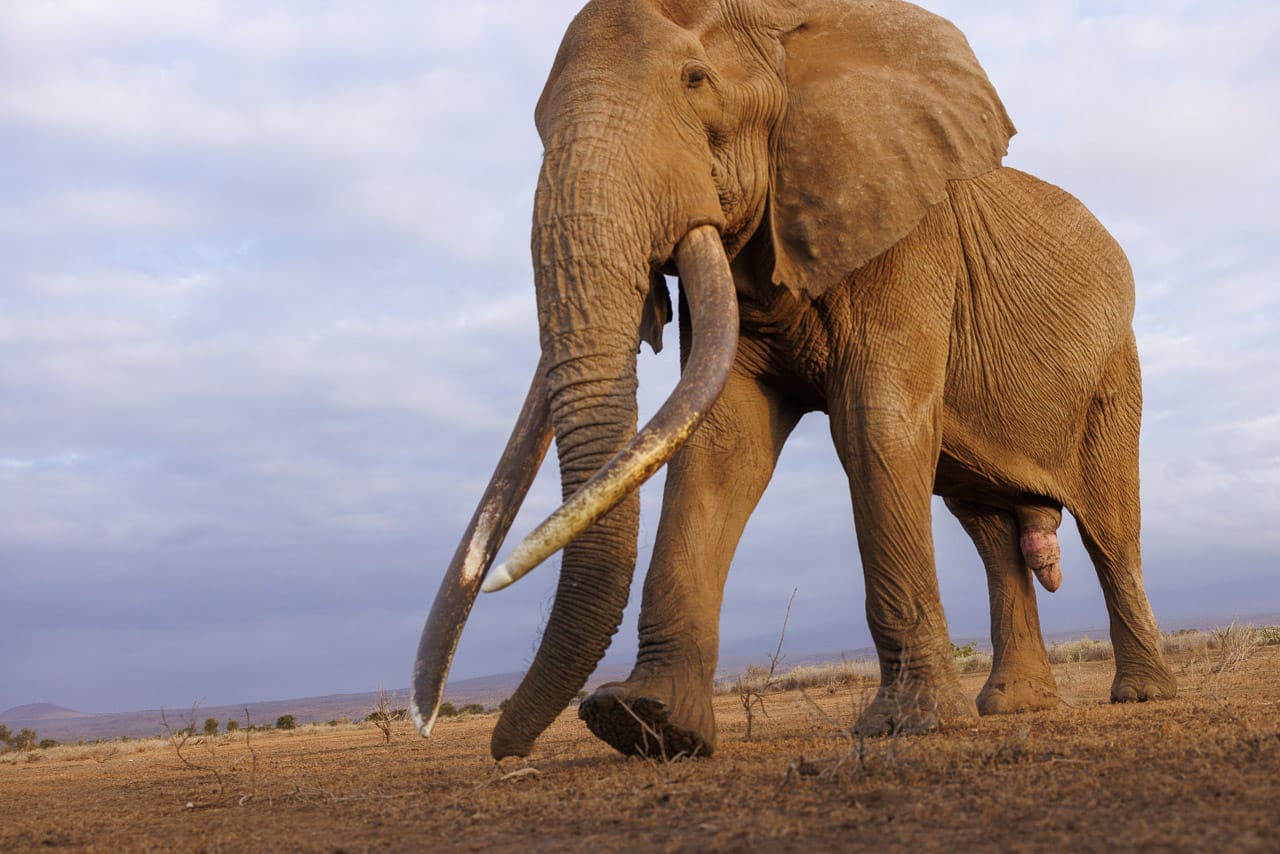
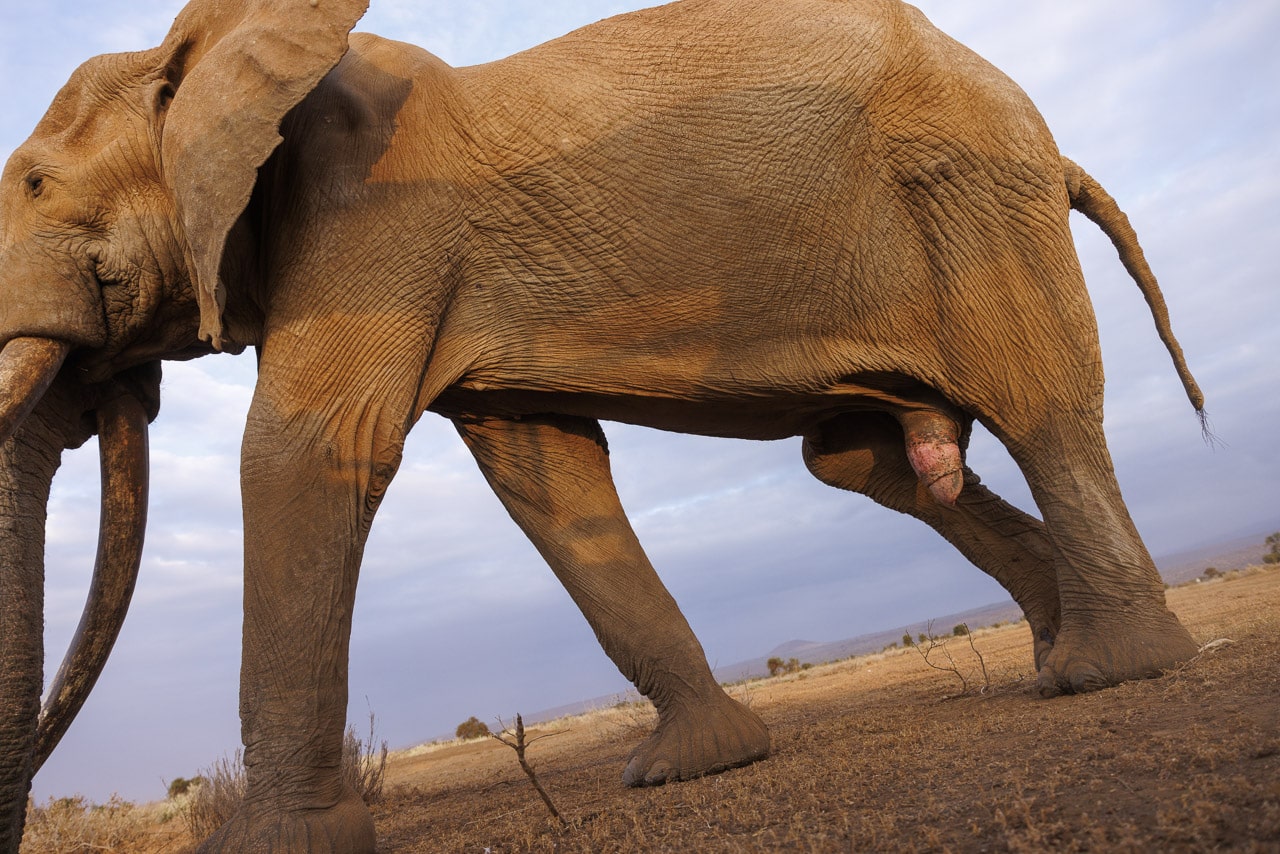
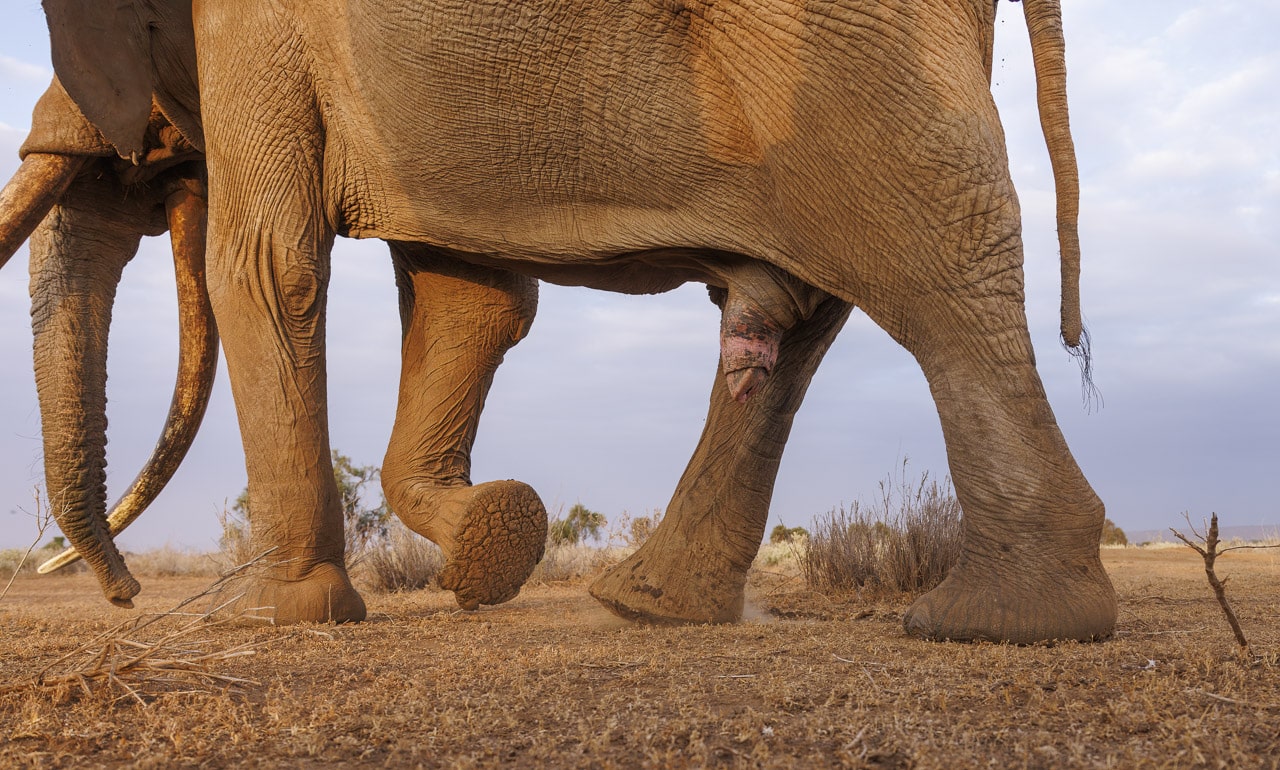 I can’t even describe what these seconds felt like. I am still processing. He moved so slowly and lightly, but I could feel him through the ground. I was star-struck for sure.
I can’t even describe what these seconds felt like. I am still processing. He moved so slowly and lightly, but I could feel him through the ground. I was star-struck for sure.
Craig at Sundown
For most of our time together the light was dull; gray with flat, overcast skies. The worst kind of light for photography. But, as luck would have it, a few moments of sunshine broke through right as the sun was going down. It was wonderful to see him with a splash of golden light!
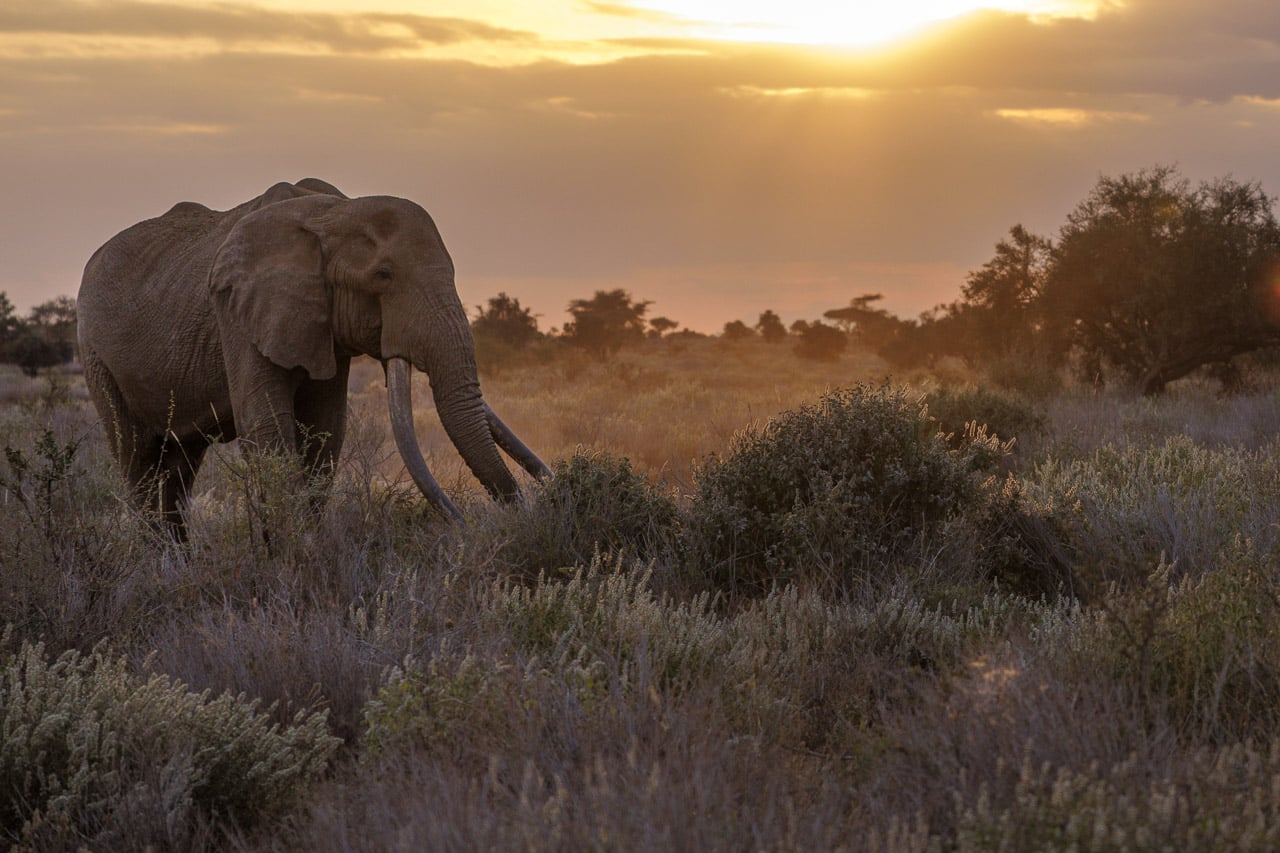 My second evening was very different, but just as magical. This time Craig was hanging out in thicker vegetation, so photographing him was much more challenging. However, just being able to watch him move through his world, in and out of dense foliage, stopping to browse, scratch himself on a fallen tree, or dust himself, was, in a word, delightful.
My second evening was very different, but just as magical. This time Craig was hanging out in thicker vegetation, so photographing him was much more challenging. However, just being able to watch him move through his world, in and out of dense foliage, stopping to browse, scratch himself on a fallen tree, or dust himself, was, in a word, delightful.
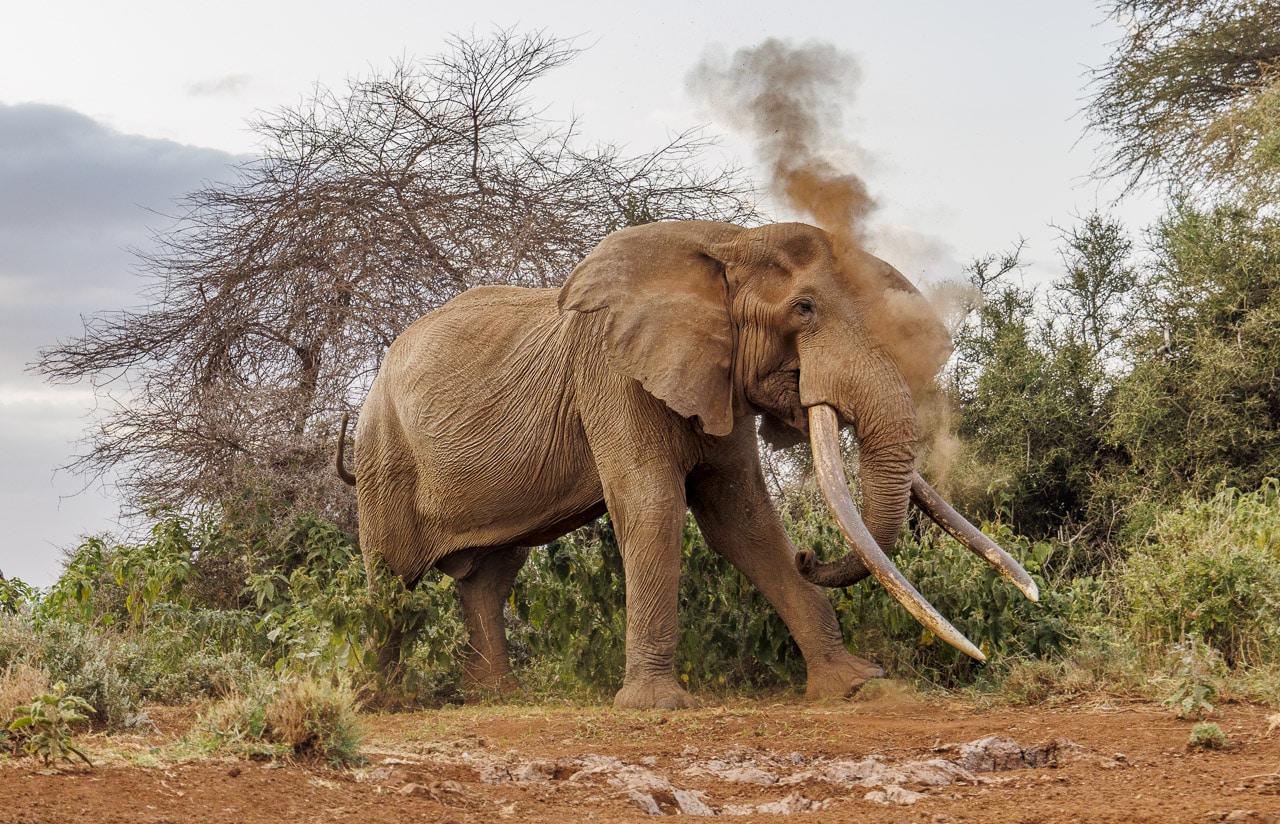
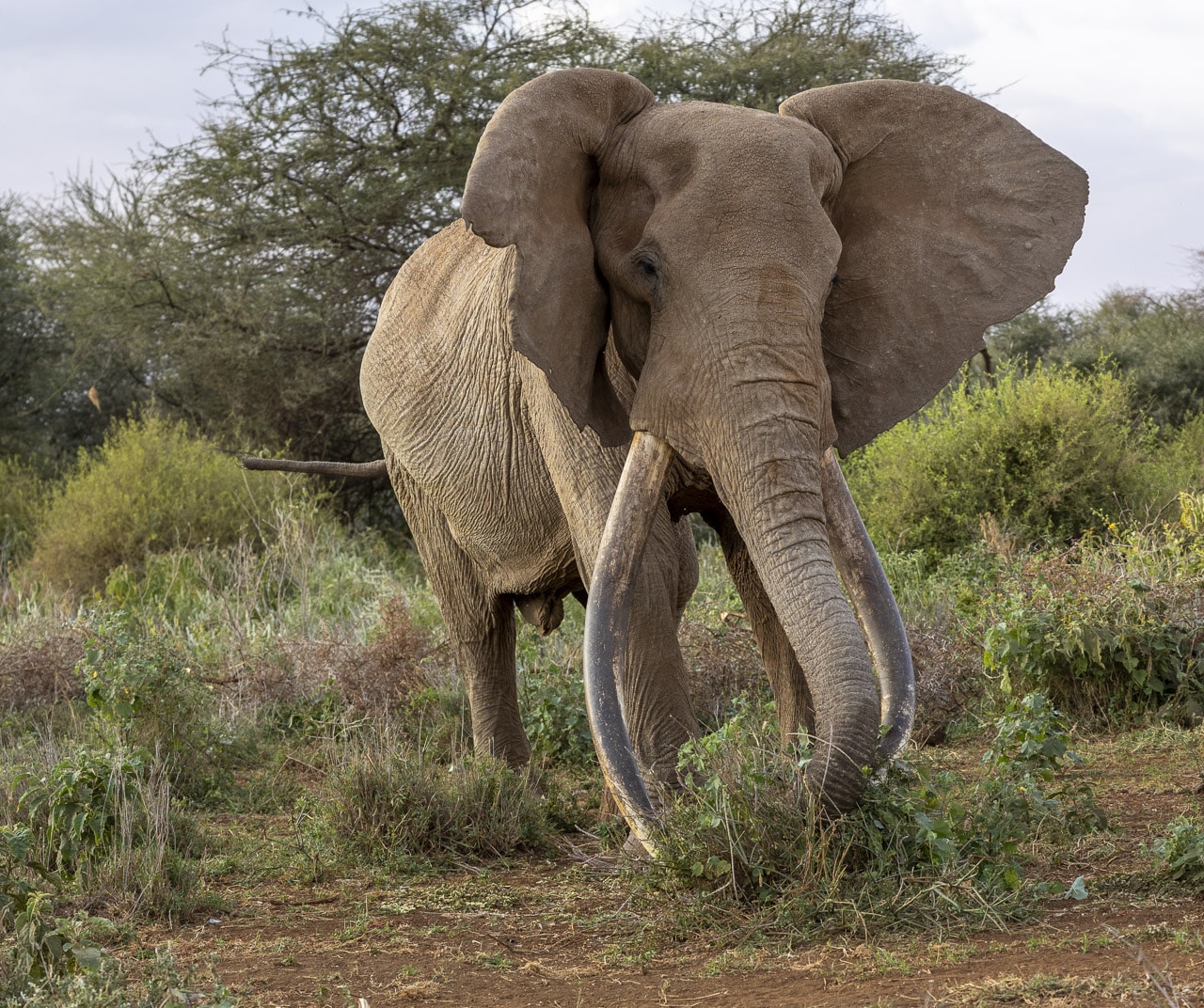 These two evenings with Craig were nothing short of magical! To be in the presence of this magnificent and mellow giant was such an enormous privilege. I have no doubt it will stay with me always.
These two evenings with Craig were nothing short of magical! To be in the presence of this magnificent and mellow giant was such an enormous privilege. I have no doubt it will stay with me always.
Thanks!
Thanks for taking the time to look at my work. I support myself as an artist through my photography and writing. This post originally appeared on KO-FI.COM, a platform that allows people like you to help support artists in some small way. You can make a one time donation for a cup of coffee, or, join one of my memberships and have access to exclusive content-including members only live updates while I am on safari and a private Facebook page. Please check out my memberships here on Ko‑fi and consider joining. I would greatly appreciate your support.
Cheers,
NJ
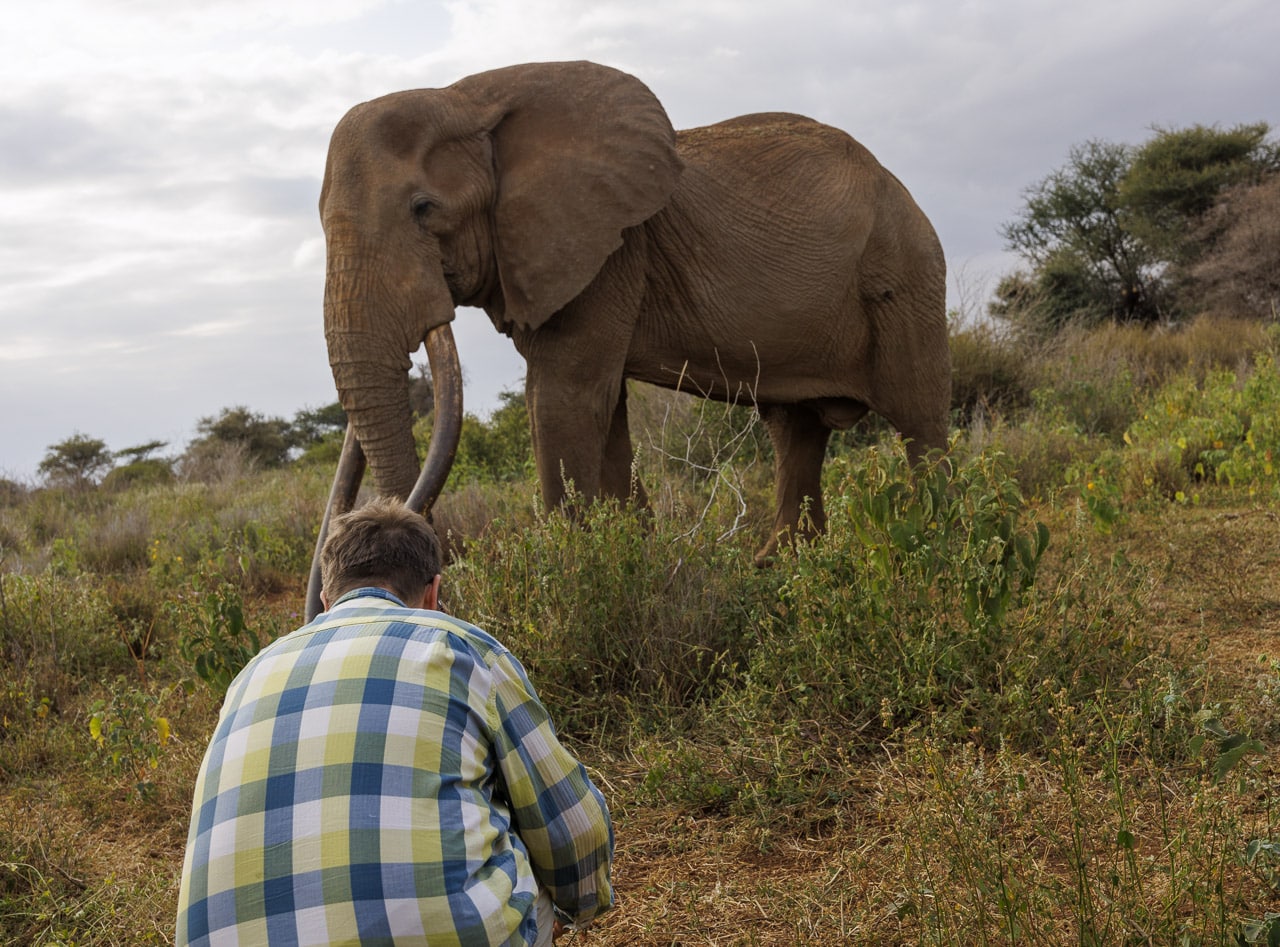
A View from the Hide
(This post about my time in a photography hide was previously published on my Ko‑fi page with some image changes.)
A Visit to a Photography Hide
This past week I spent four nights working in a waterhole photography hide at Lentorre Lodge in Kenya’s southern Great Rift Valley. A “hide” (also referred to as a blind) is a camouflaged “space” allowing you to approach birds or wildlife without them knowing you are there. There are all kinds of hides and blinds available—one person, portable blinds, floating hides or permanent hides. The photography hide I spent time in is a physical structure built into the ground with viewing windows that look out at eye level on a watering hole.
Life at the Waterhole
My objective for this adventure was to photograph nocturnal wildlife activity at a waterhole. Conditions in many parts of Kenya right now are extremely dry. The Olkirimatian Conservancy where I was visiting was no exception. It was parched and daytime temperatures hit highs of 43 Celsius. Lentorre Lodge, my home for four nights, constructed its hide in front of a permanent waterhole they built and continually fill. As other water sources dry up in summer, this waterhole becomes very popular–and much needed!
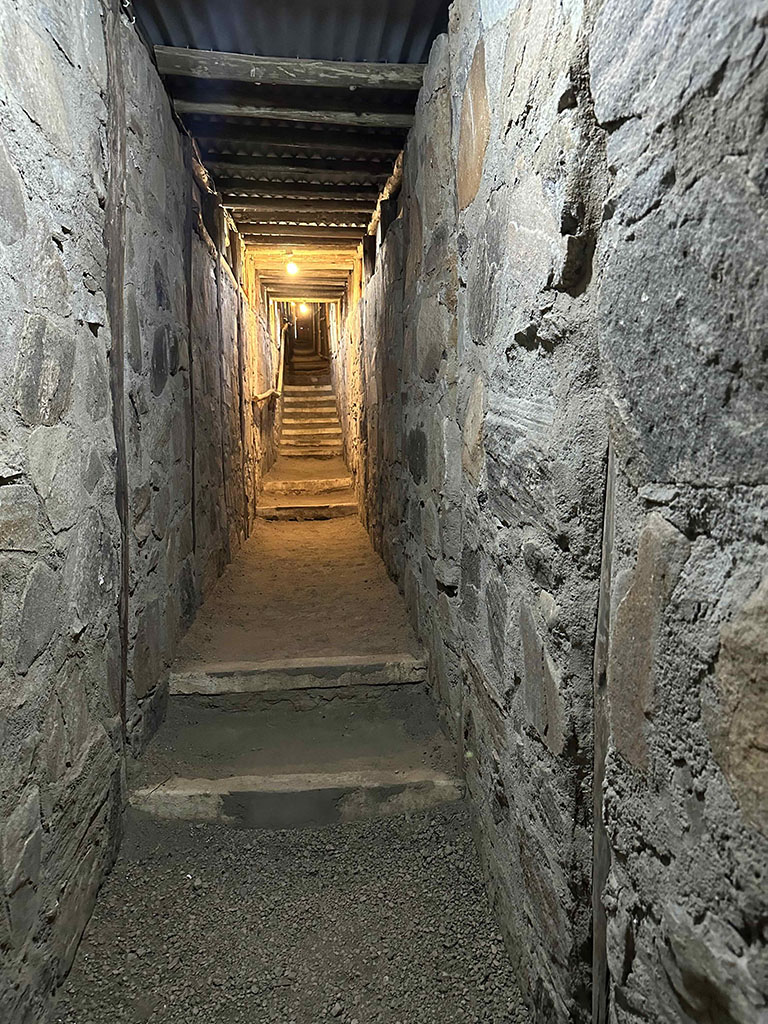
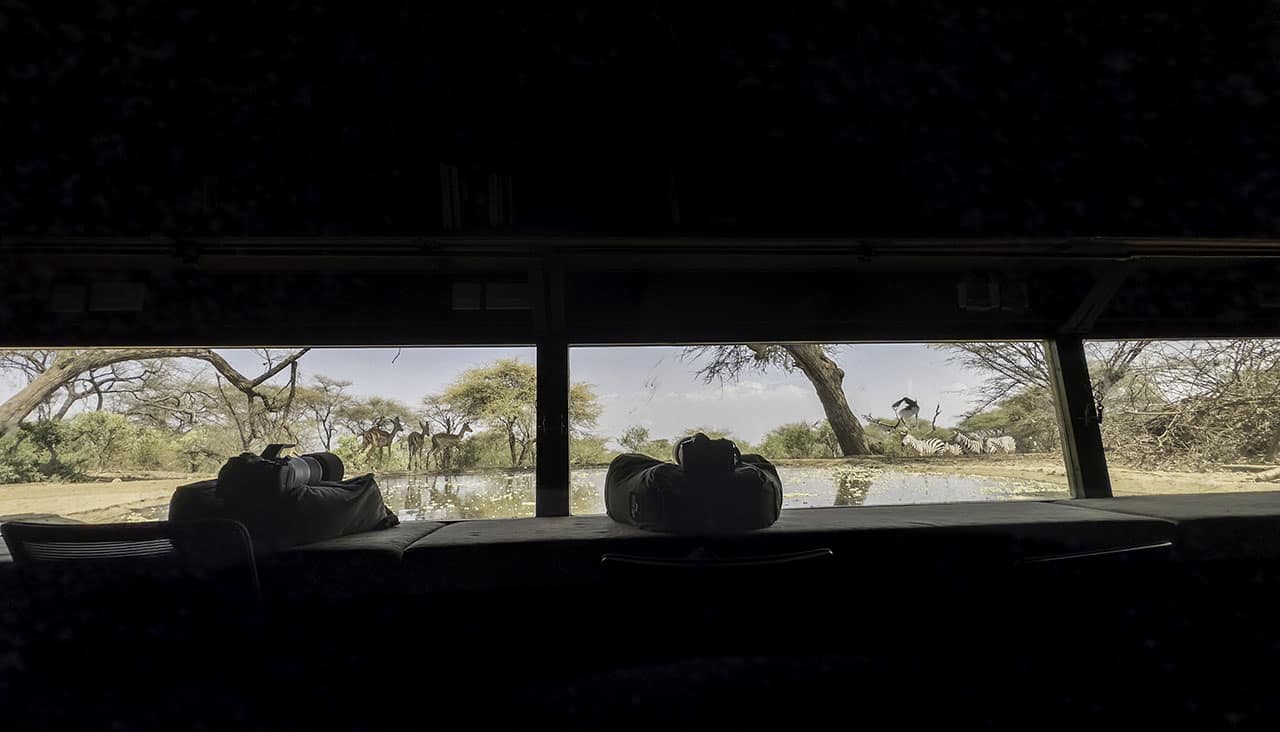
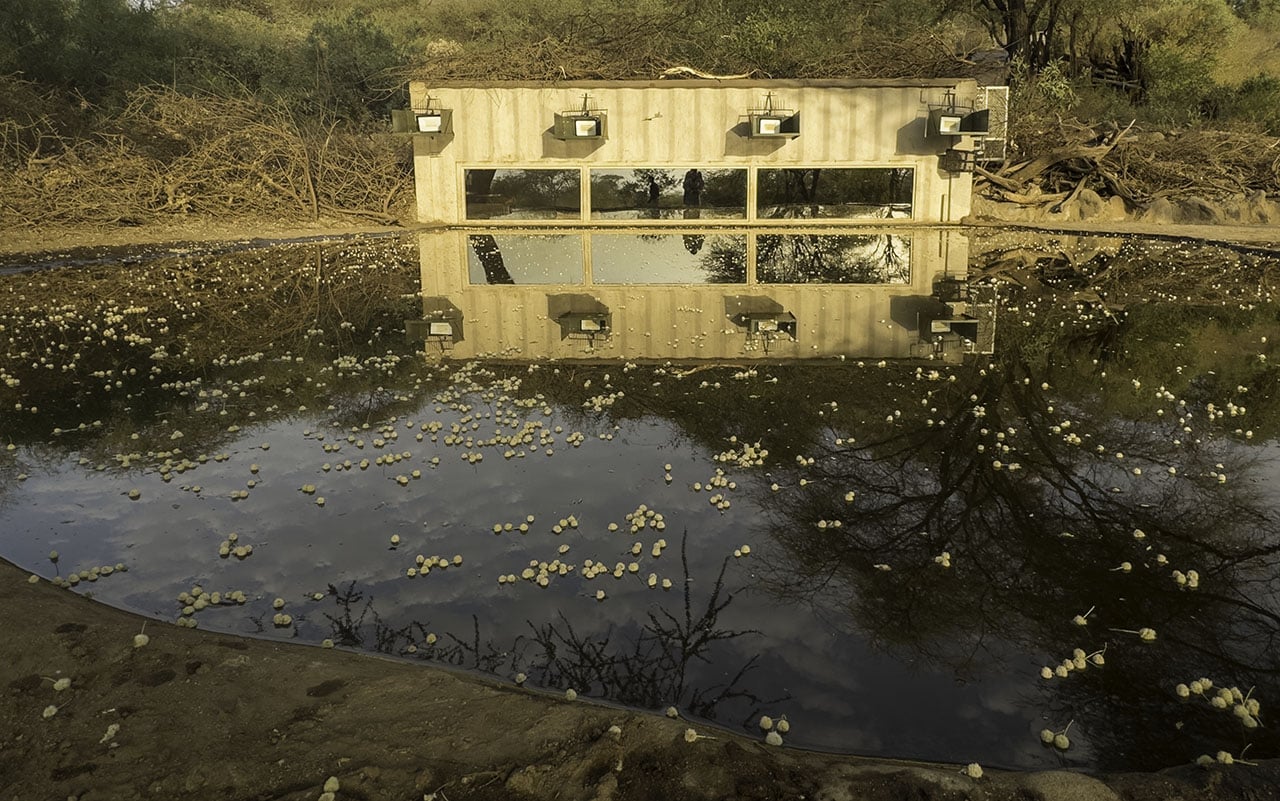
Twenty-four Hour Action at the Photography Hide!
There is activity throughout the day. Birds galore, baboons, zebras, impala, waterbuck, buffalo, giraffe and dik-dik all made regular appearances-day or night-or both. One cheetah, who had not been seen in many months, and a large bull elephant also stopped by for a drink. The nocturnal animals only came to drink in the very dark of night. Leopard, porcupine, hyena, genets and sivets.
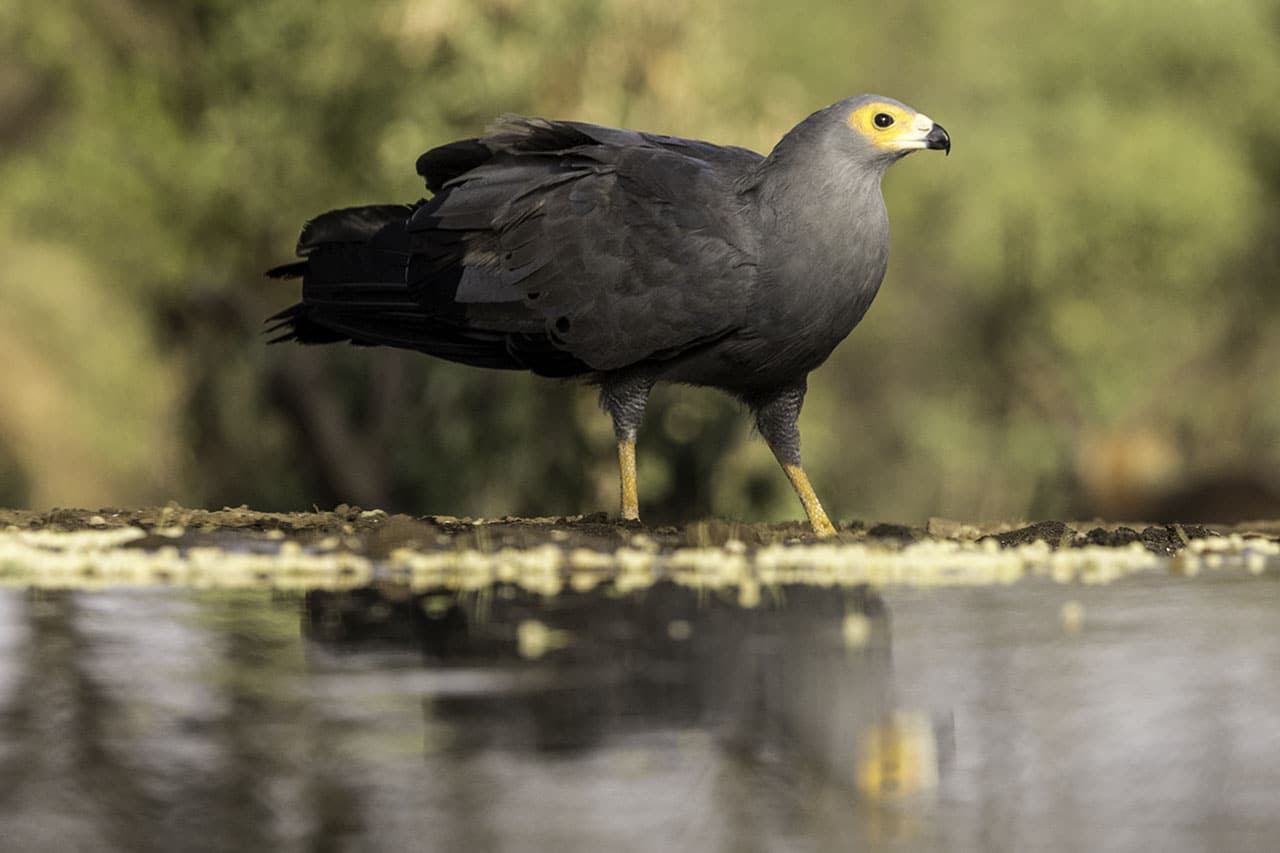
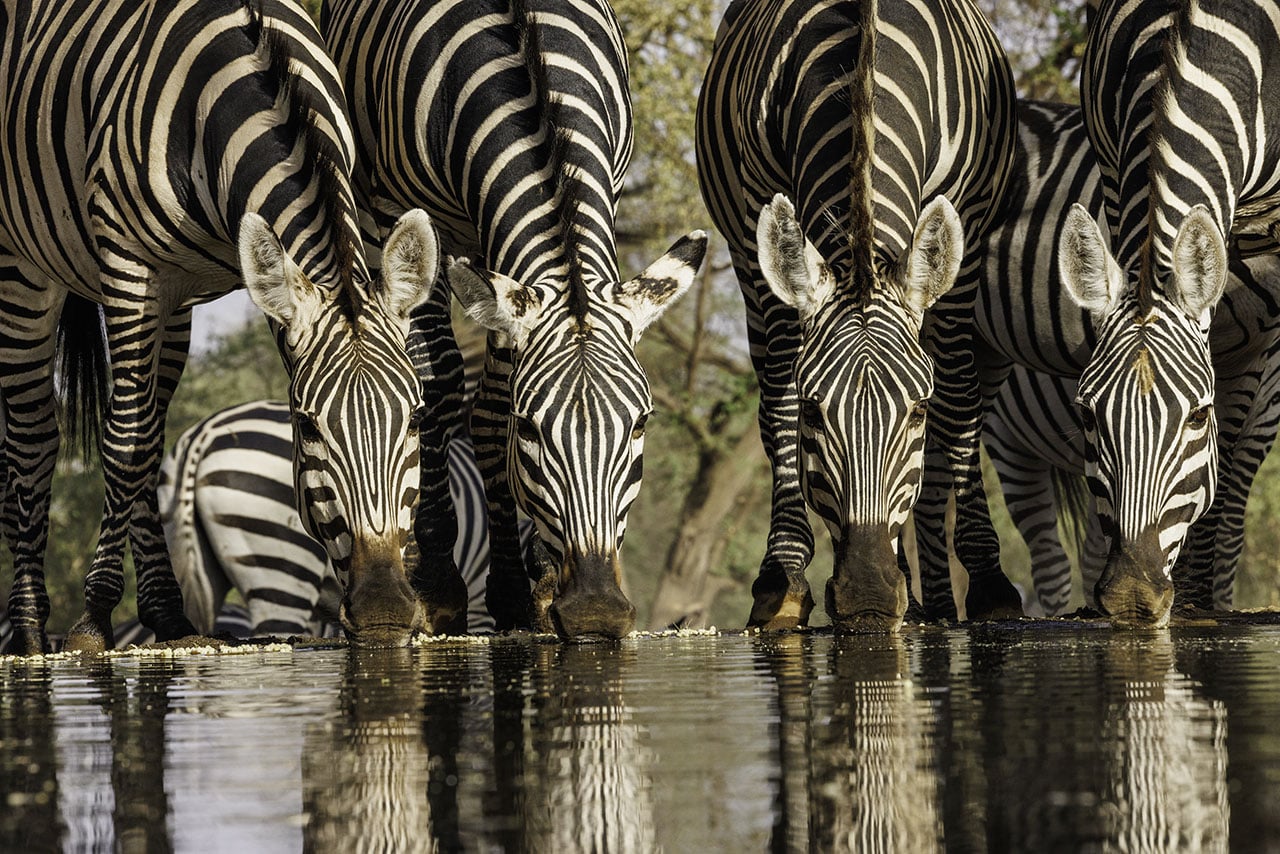
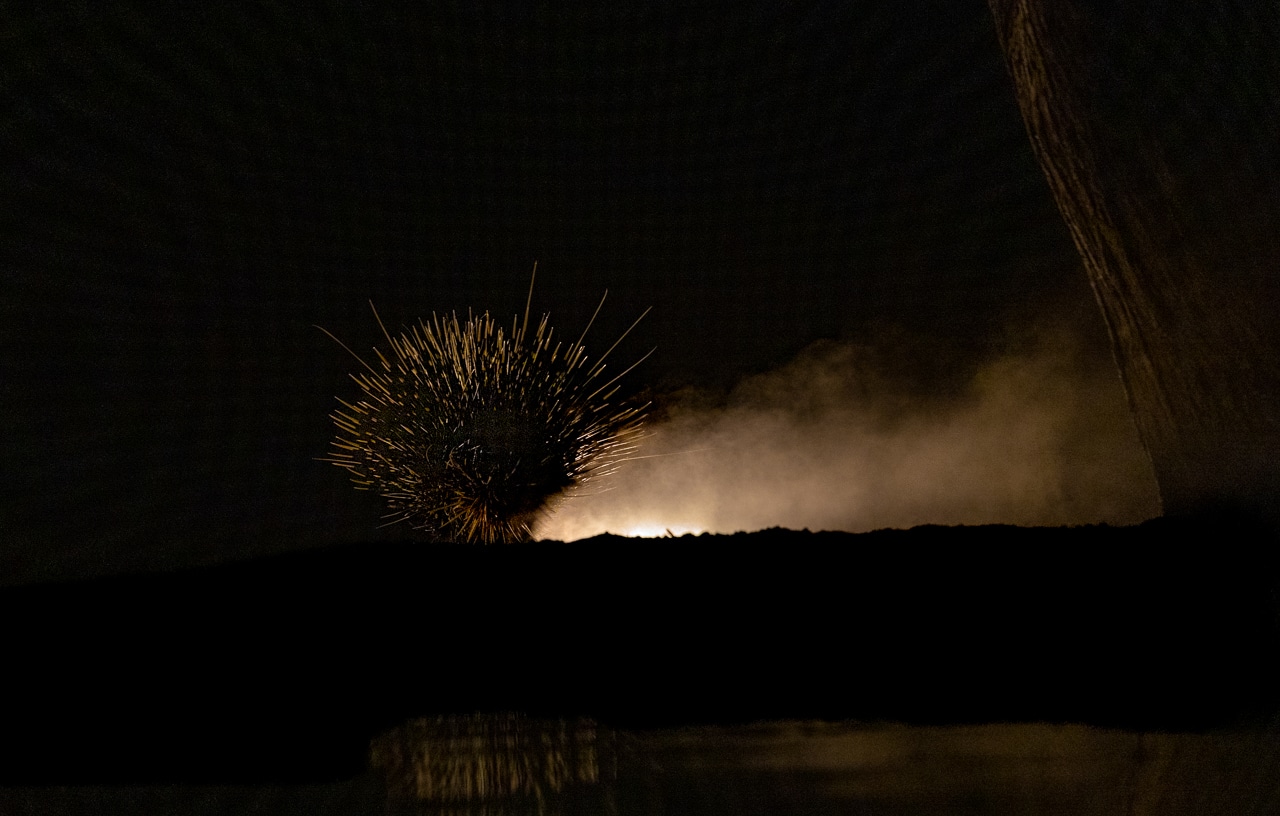
Precarious Posture
The waterhole is a very precarious and dangerous place for most animals. The darkness of night–when most of the predators come out to hunt–is already a threat. To drink, they have to turn their backs on potential predators, and some, like the giraffe, require adopting very vulnerable postures to enable them to drink. A giraffe needs to bend over ten feet to quench its thirst, putting itself in a very dangerous position. Because they get most of their water from vegetation, it is only necessary for them to drink every 2-3 days and they can last almost three weeks without water. Once they do get themselves down to the water, they can drink over 50 litres!
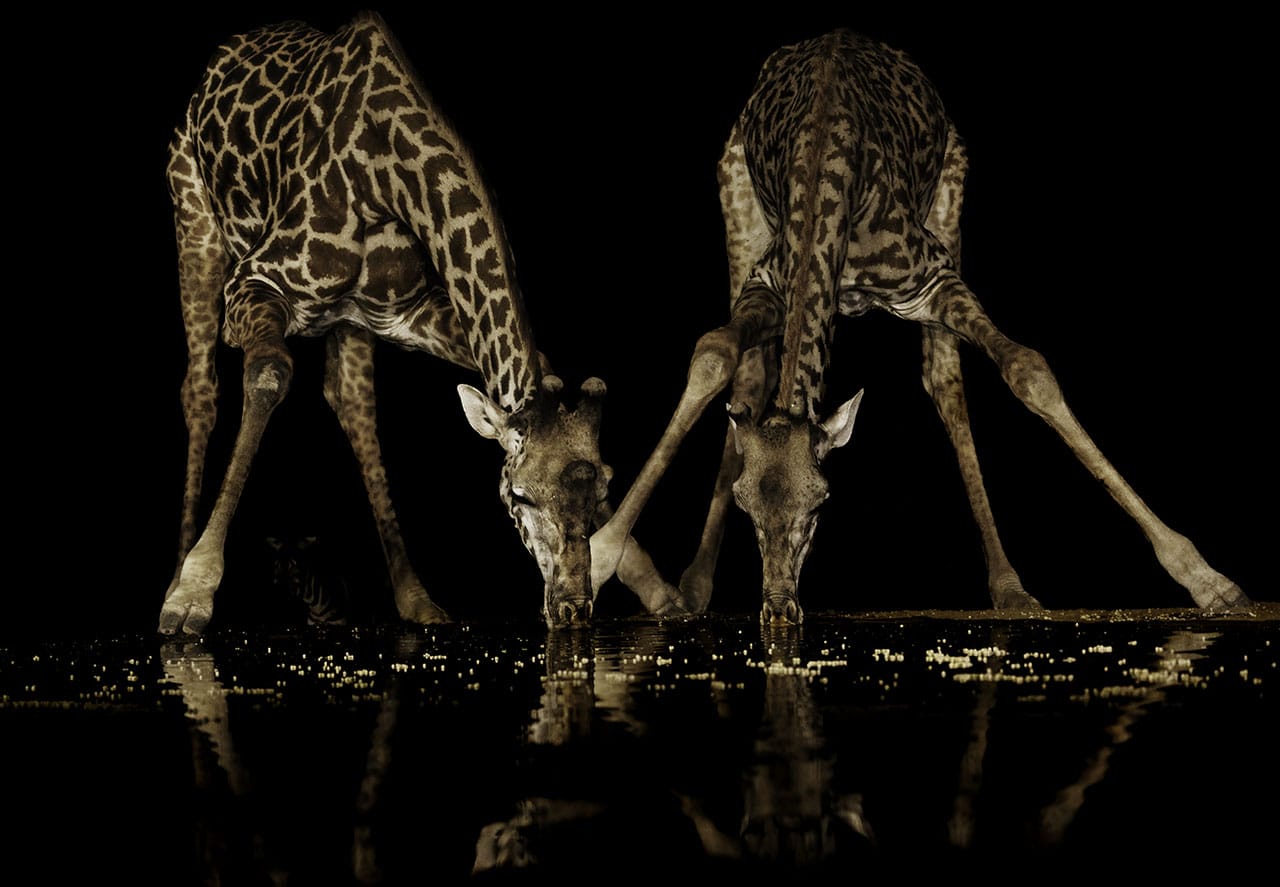
The individuals I watched remained skittish and on very high alert. It was fascinating to observe this behaviour from the photography hide. In one instance, it took more than forty minutes for two giraffes to chance a drink. Prior to approaching, they spent time looking in every direction. They would come close, stand still for a very long time, move away and come back. The small herds of zebras and impala would come close, get spooked and run off. Even while drinking, if one individual was spooked, they all jumped back. They know their predators are out at night—but thirst is a mighty motivator during a drought. So they tentatively approach.
A Typical Day in the Photography Hide
My routine most days was to go down to the hide in late afternoon when the bird activity was hopping and the light less harsh. It was wonderful to watch zebras, baboons and antelope coming and going in the warm, end-of-day light. I would take a break for dinner around 6 PM and then return to the hide at 7 PM. Exhausted from jetlag and the heat–when I left Canada it was -24C–I never made it through a full night, but I was there until anywhere from 2 AM to 3:30 AM. Some nights there was a constant flow of wild life dropping by the animal bar; other nights were less busy.
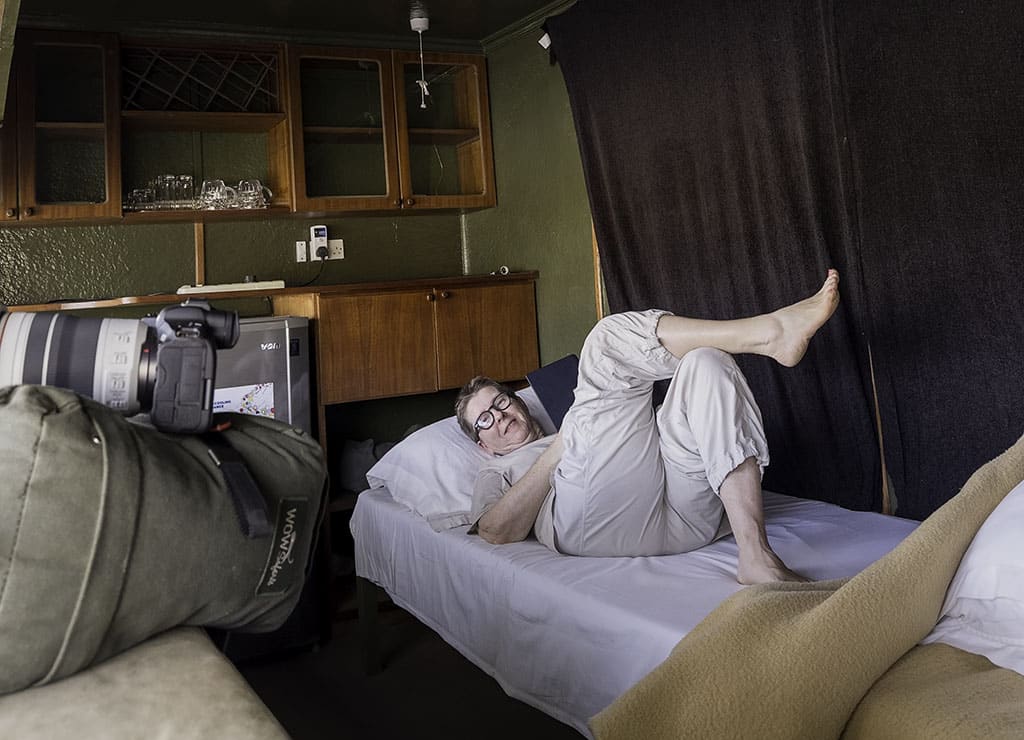
The Highlight of the Hide
On my last night I was alone in the hide and it was exceptionally quiet. I was getting antsy by 11 PM, but my patience was rewarded when the animal on the top of my wish list suddenly turned up! After three nights of waiting I was giving up hope, but on night four the gorgeous striped hyena made an appearance! In 15 years I have only had one or two partial glimpses of the striped hyena at night. They are solitary, very shy and elusive—quite different from their bigger, rowdy, spotted cousins. I have visited areas where they are known to live, but sightings never materialized. To find myself sitting about 35 feet away, looking directly into its eyes, was quite a thrill!
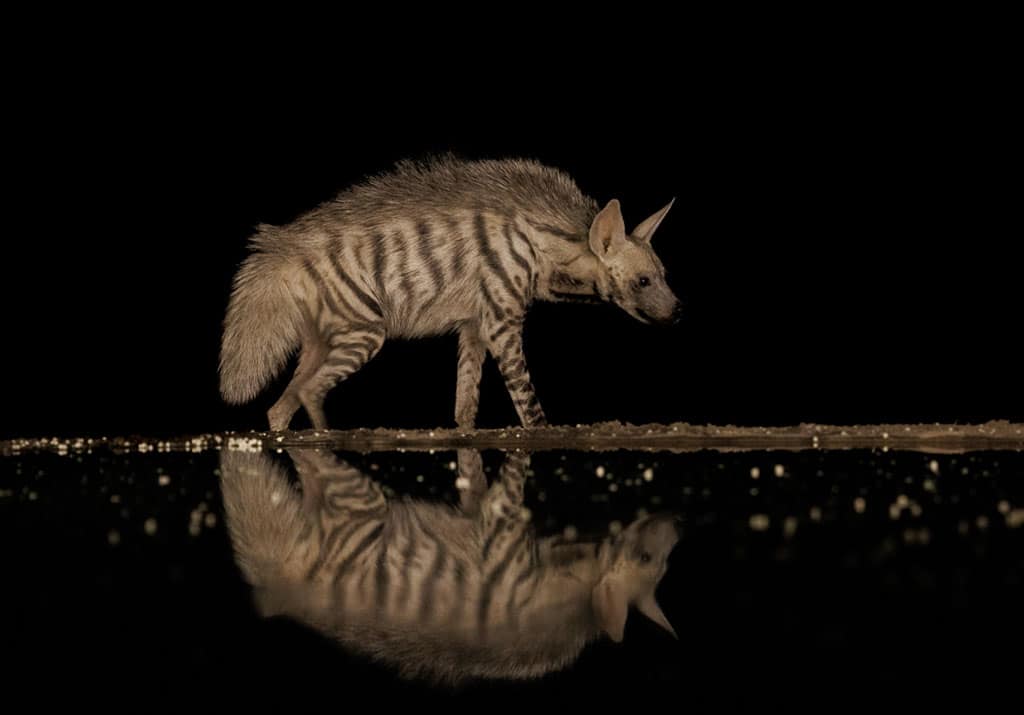
That same evening at around midnight, I was lucky to photograph an African wild cat. I last saw one of these beauties in Namibia in 2008. Even though it took four nights of endless hours sitting and waiting, it was very special to photograph two such beautiful animals for the first time!
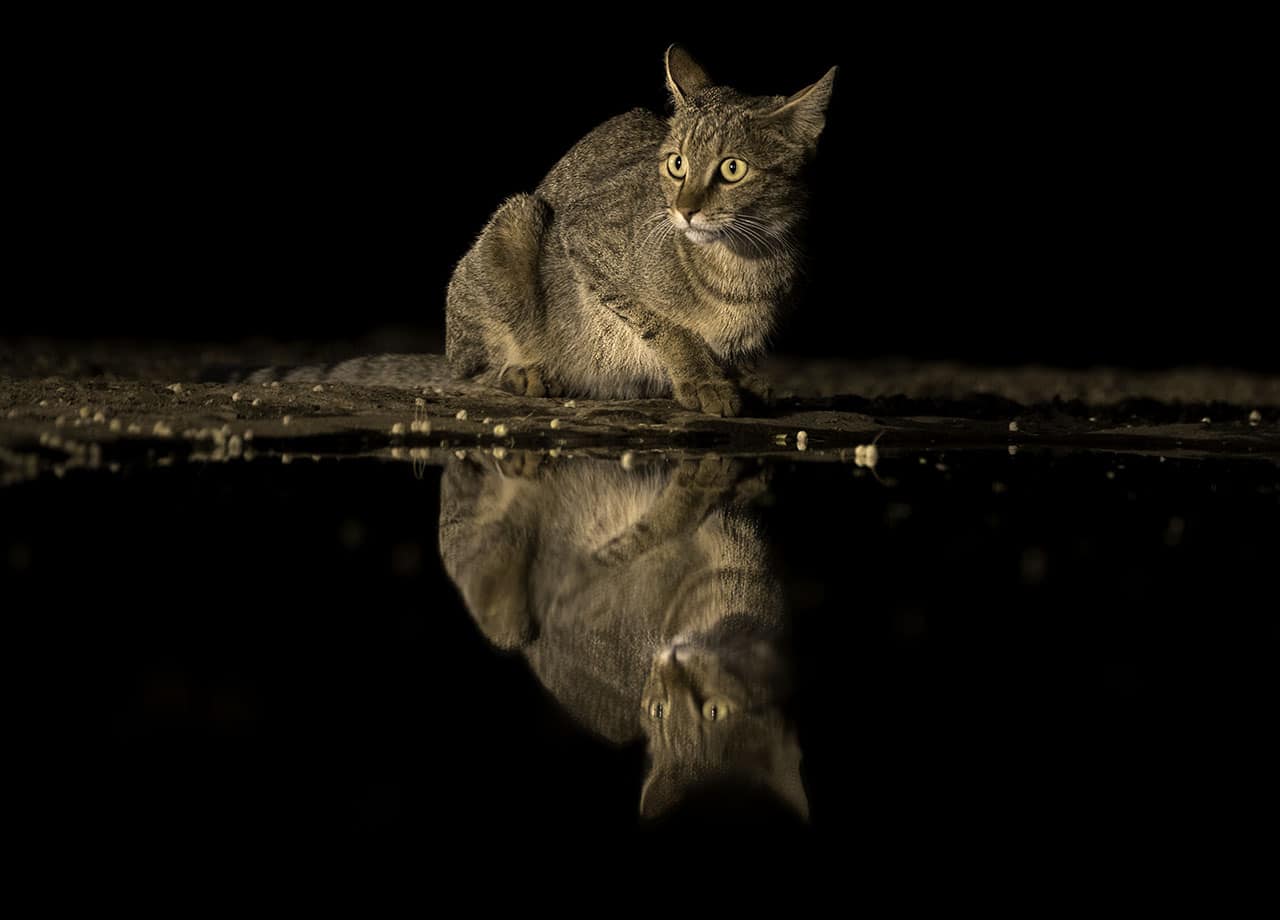
After four days it was time to move on to the Maasai Mara, where the daytime temperatures drop to a slightly more tolerable 32C! I am looking forward to seeing some old feline friends.
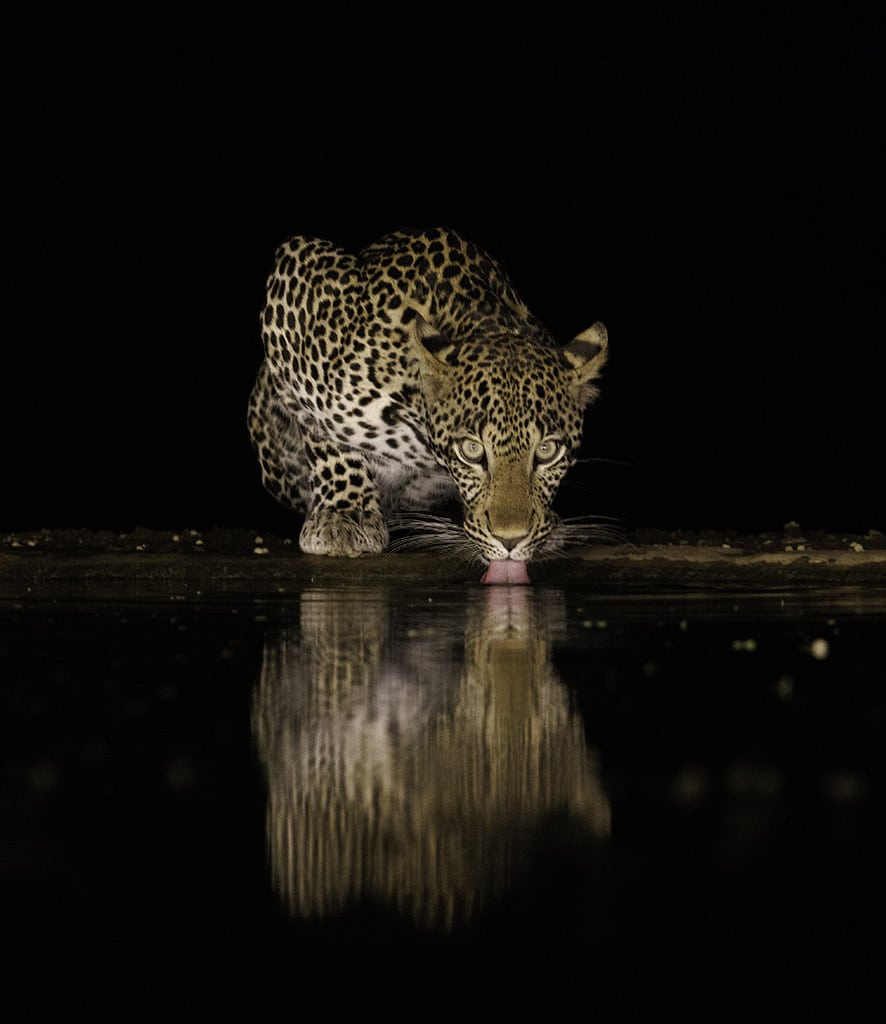
One more thing...
Thank you very much for visiting my blog. I support myself as an artist with my photography and writing. If you enjoy my content and would like more, please consider supporting me on KO-FI.COM Becoming a member of the Armchair Wanderers or one of The Wild Bunch will give you access to exclusive member only content-including behind-the-scene safari updates from my travels. Thank you for your ongoing encouragement and promoting my passion.
A Black Rhino Named Elvis
I recently visited the Lewa Wildlife Conservancy where I was lucky to meet a special black rhino named Elvis. Lewa is a safe refuge for the critically endangered black rhino as well as the endangered Grévy’s zebra. Lewa is renowned for world class anti-poaching operations, built on forging strong relationships with neighbouring conservancies. As well, engaging local communities in the philosophy of wildlife conservation. It has proven to be a successful model, and while there are still challenges, the wildlife is flourishing.
In the 1960's, Kenya was home to over 20,000 black rhinos. By 1980 there were less than 300 black rhinos remaining. Thanks to dedicated anti-poaching teams, education programs, and habitat protection, the numbers are rising. Today, Keyna is estimated to have more than 900 black rhinos, and 255 of those live under protection in Lewa.
On my recent visit I was delighted to see strong numbers of both white and black rhinos. The highlight, however, was meeting a resident black rhino named Elvis. My encounter with Elvis was highly unusual. Black rhinos are not known to be laid back and so, when Elvis dropped by to have a scratch on our bumper, it was indeed a surprise! But Elvis has a very special background and his casual approach to the truck was friendly and relaxed–albeit, a little itchy!
Meet Elvis!
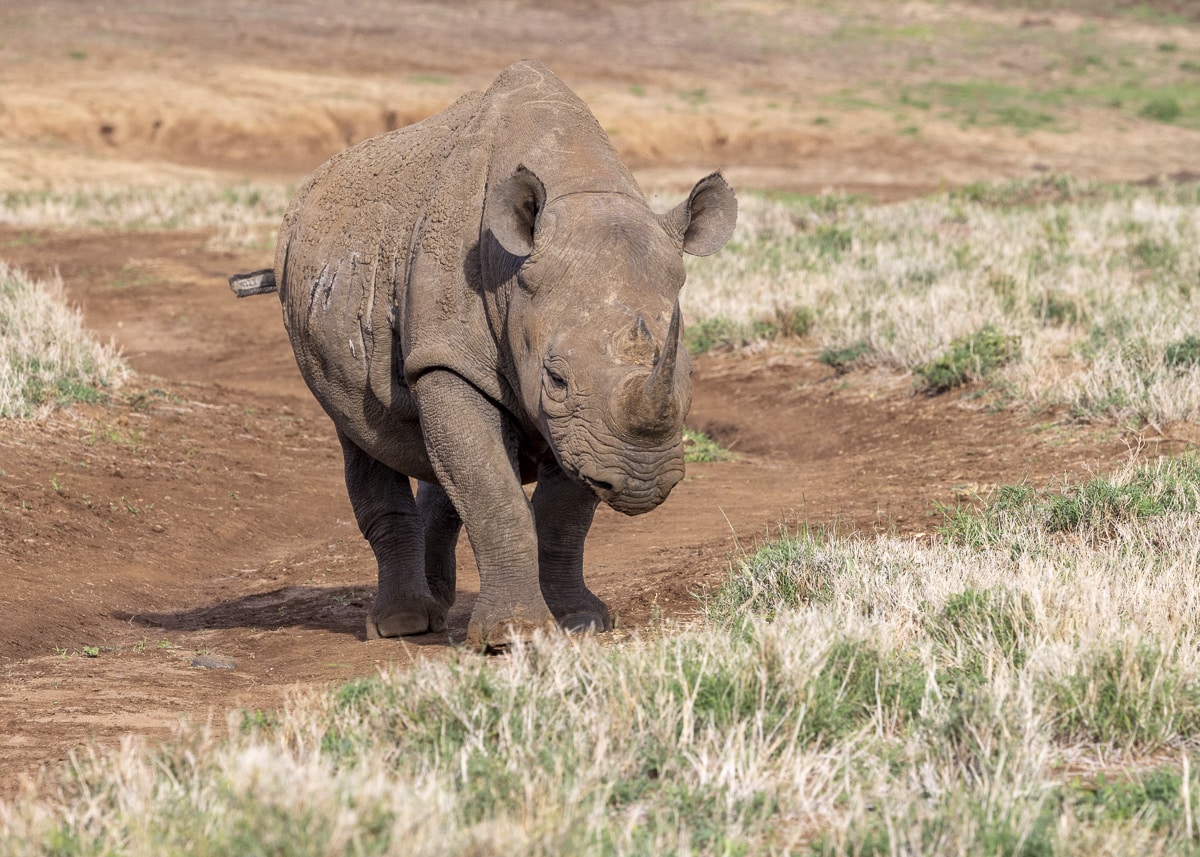
Elvis was the third or fourth calf born to Mawinga (translated: Cloud) in the Lewa Conservancy. Sadly, Malingwa was blind and unable to defend her claves, she lost them to predation from lions and leopard. With rhino numbers under such pressure, losing calves was tragic for all involved. So, when Mawingu gave birth again, the park rangers removed her calf and raised him by hand to ensure his safety. They went on to raise another 4 or 5 of Mawinga's calves over the next decade, until she passed away.
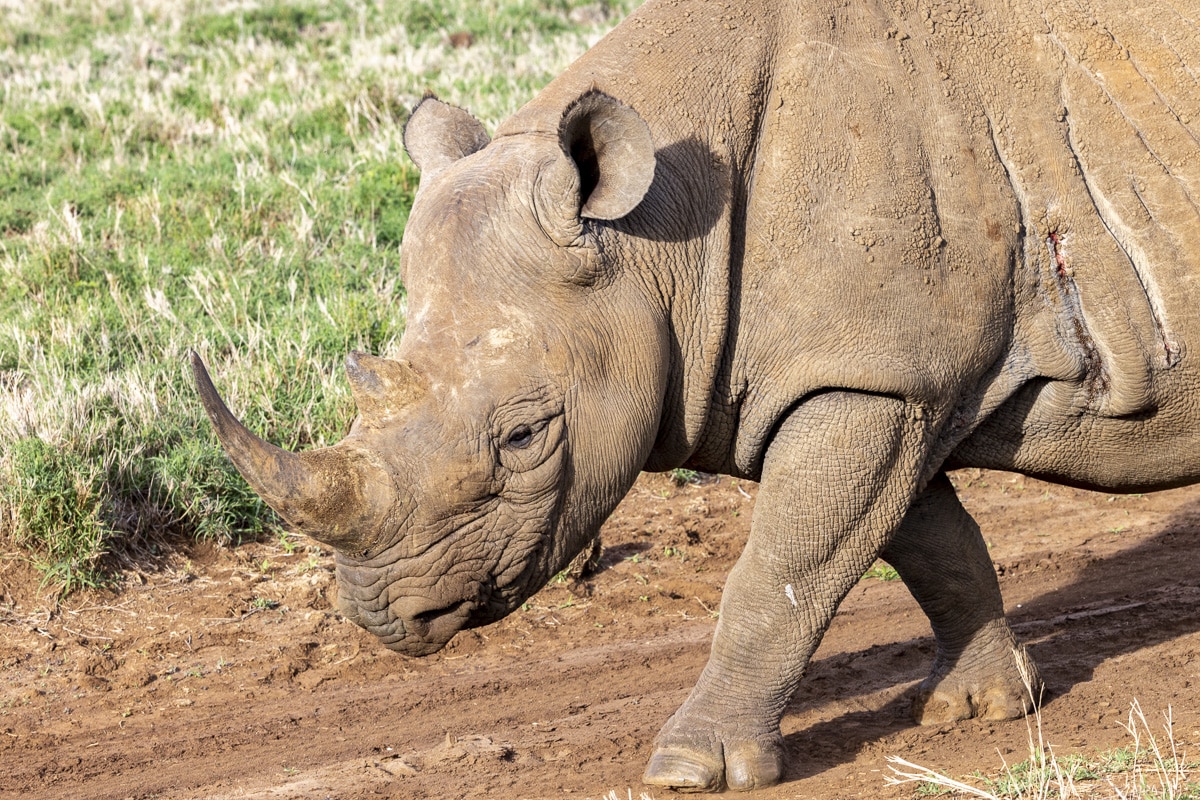 The Early Years for Elvis
The Early Years for Elvis
Elvis (and his subsequent siblings) was well cared for, but he was not treated as a pet. His caregivers took him for daily walks in his future territory. They made regular visits the dung sites of the resident wild rhinos–the ultimate communication hub! Think of these piles of poop as the social media network of the wild rhino population. The chemicals in dung and urine communicates important information to other rhinos. Here, Elvis would sniff through the droppings, familiarize himself with the community comings and goings, rub his feet through the dung heap and leave his scent to introduce himself to his wild cousins. Ensuring scent is circulated is a very necessary part of preparing a rhino to return to a wild community.
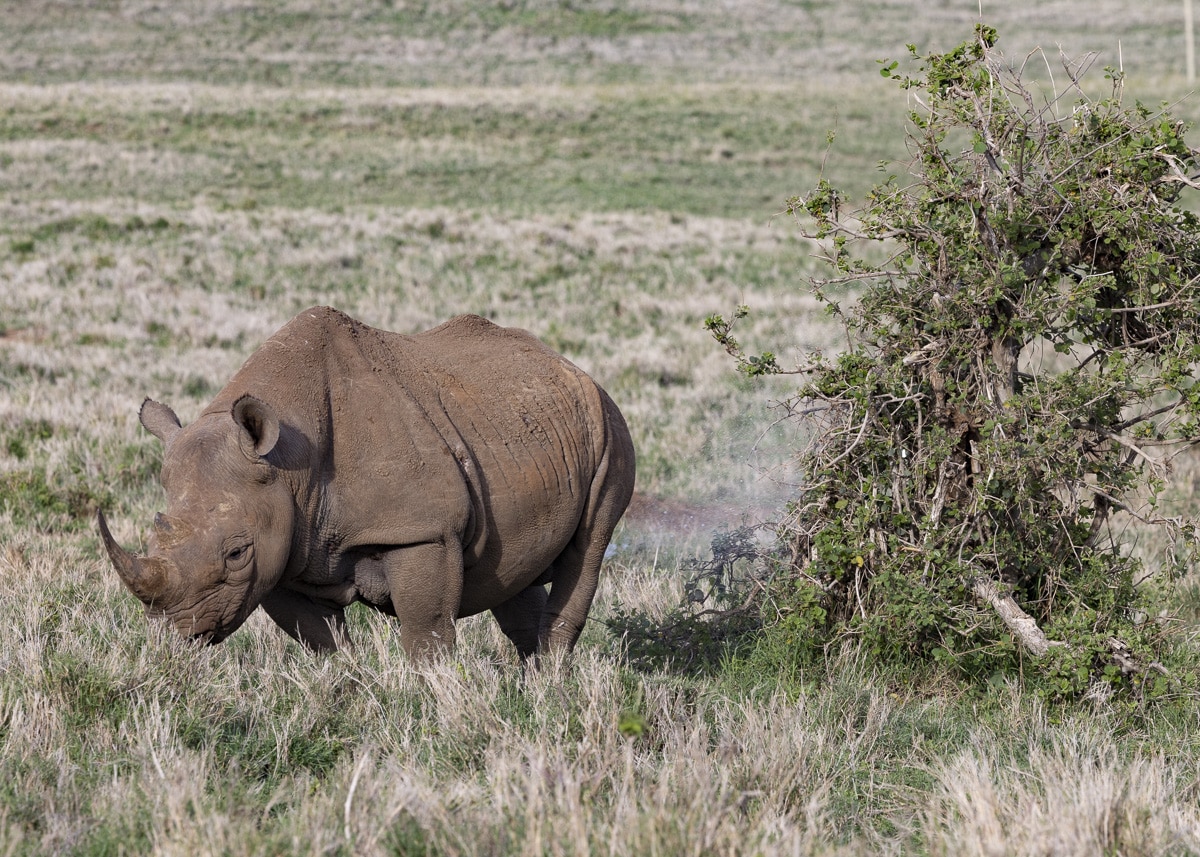
At about the age of four, Elvis was successfully re-introduced to the wild and began his life as a young male black rhino. But for several years after he would return to see is Ranger friends, wandering right through the home of Ian and Jane Craig, the founders of the conservancy. On one special occasion he made an attempt crawl right into bed! To hear Jane tell the story, the bed collapsed under his weight and Elvis just lay there, moved the blankets around with his horn and created a little nest to enjoy a nap. Apparently, it has been years since he has returned. As the dominate male in his territory, he is quite busy marking his scent and keeping track of his females.
An Itchy Elvis
We had stoped to watch Elvis walk along the worn path seemingly heading down to the waterhole. But he decided to take a small detour for some self-cares! Clearly unconcerned about our truck and recognizing our ranger, he approached the back end to take care of a little dry skin that was bothering him. For the next minute or two he very casually began to run his horn and forehead over the back bumber! For a rhino, his movements seemed quite gentle. But when an animal that can weigh up to 1400 KG gives himself a little scratch, well, it does put the suspension to the test!
While seeing our familiar ranger and truck posed no threat to him, he casually approached to give himself a scratch! But as is always good practise, no matter how relaxed or familiar a wild animal might seem, it is best to move our of their way. In our case, we did to want to startle him by jerking into gear and abruptly ending his massage, so we just slowly rolled a little froward. This proved to be just enough to divert Elvis to the other side where he could continue to wander the path down for a drink and a nice rub in the mud!
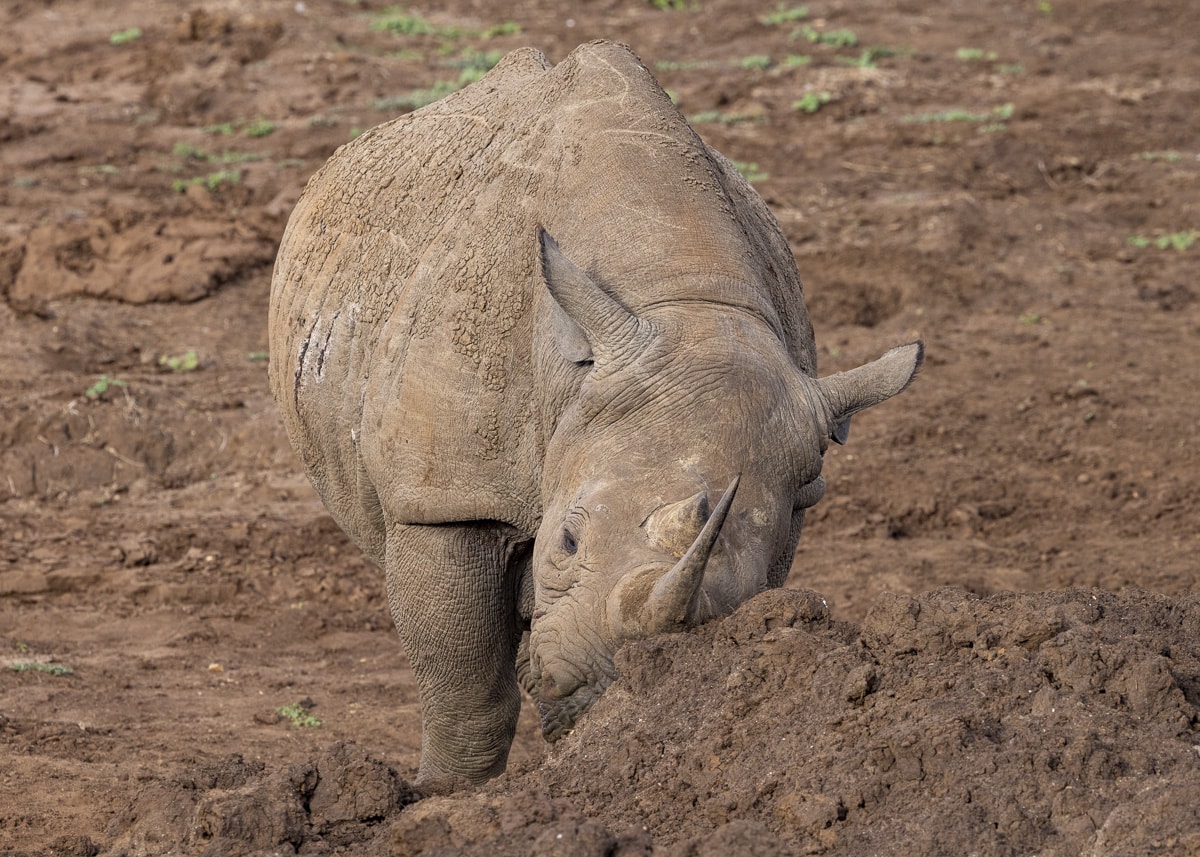
We continued to spend time with him for an other 20 minutes as he drank, scratched and surveyed his kingdom! This was definitely a rhino encounter I will long remember. Thank you Elvis–long live the King of Lewa.
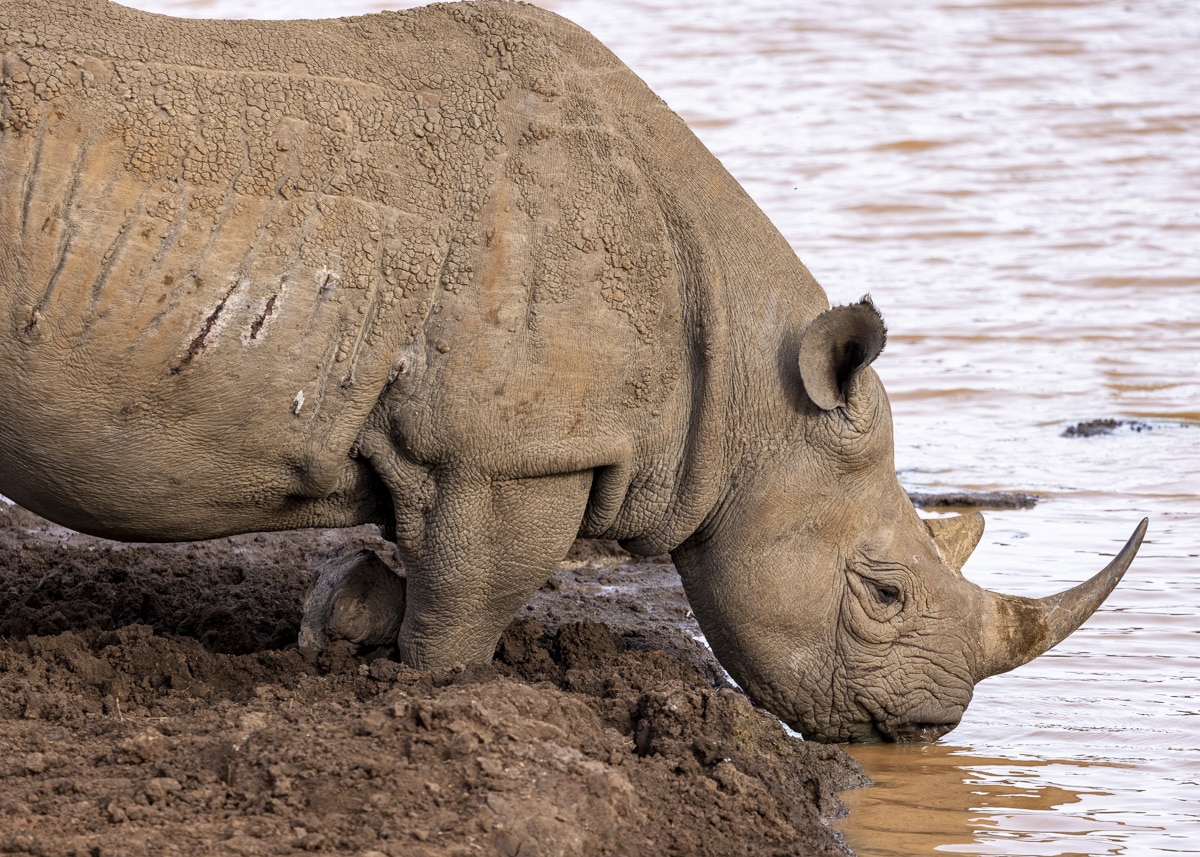
One more thing...
Thank you very much for visiting my blog. I support myself as an artist with my photography and writing. If you enjoy my content and would like more, please consider supporting me on KO-FI.COM Becoming a member of the Armchair Wanderers or one of The Wild Bunch will give you access to exclusive member only content-including behind-the-scene safari updates from my travels. Thank you for your ongoing encouragement and promoting my passion.
The Reteti Elephant Sanctuary
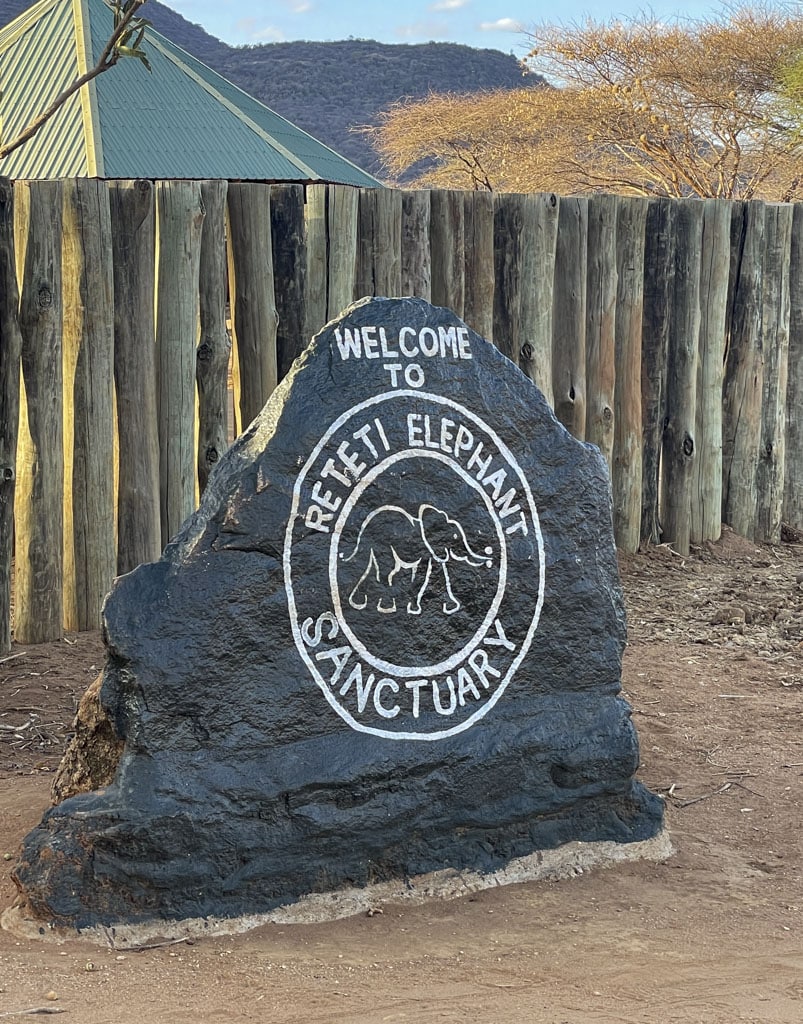
This past September I was fortunate to travel to northern Kenya and thrilled to have a long-awaited visit to the Reteti Elephant Sanctuary. Situated in the Namunyak Wildlife Conservancy in Samburu County, the Reteti Elephant Sanctuary was established in 2016. This safe haven for orphaned elephants is the first community owned elephant sanctuary in Kenya. (As I was more focused on learning and watching the elephants, I did not carry may camera. So, what follows are some shots I grabbed with my iPhone.)
Elephants are highly sociable and their emotional well-being is dependent on them having a family unit they can interact with and count on. The baby elephants that are rescued by Reteti become part of a larger orphaned elephant family. They are cared for 24 hours a day by their dedicated keepers. Healthcare and nutrition are paramount at Reteti. Nutritionists at the sanctuary have successfully created a goat milk formula that is highly digestible and rich in protein–perfect for their energetic residents! The formula is enhanced with additional supplements based on the individual needs of each elephant. This formula also provides necessary resources for the local Samburu farming community who supply the goat milk.
Community and Conservation
On my recent visit I was fortunate to spend time with Katie Rowe, the co-founder of the Reteti Elephant Sanctuary. Katie shared Namunyak’s grassroots and community-focused conservation mandate of preserving the natural resources of the conservancy, while also providing employment and revenue to the local Samburu people. It is a model that works and one that gave rise to the creation of the sanctuary. Reteti’s overarching objective is to rescue orphaned or abandoned elephants and then return them to the community land they were born on.
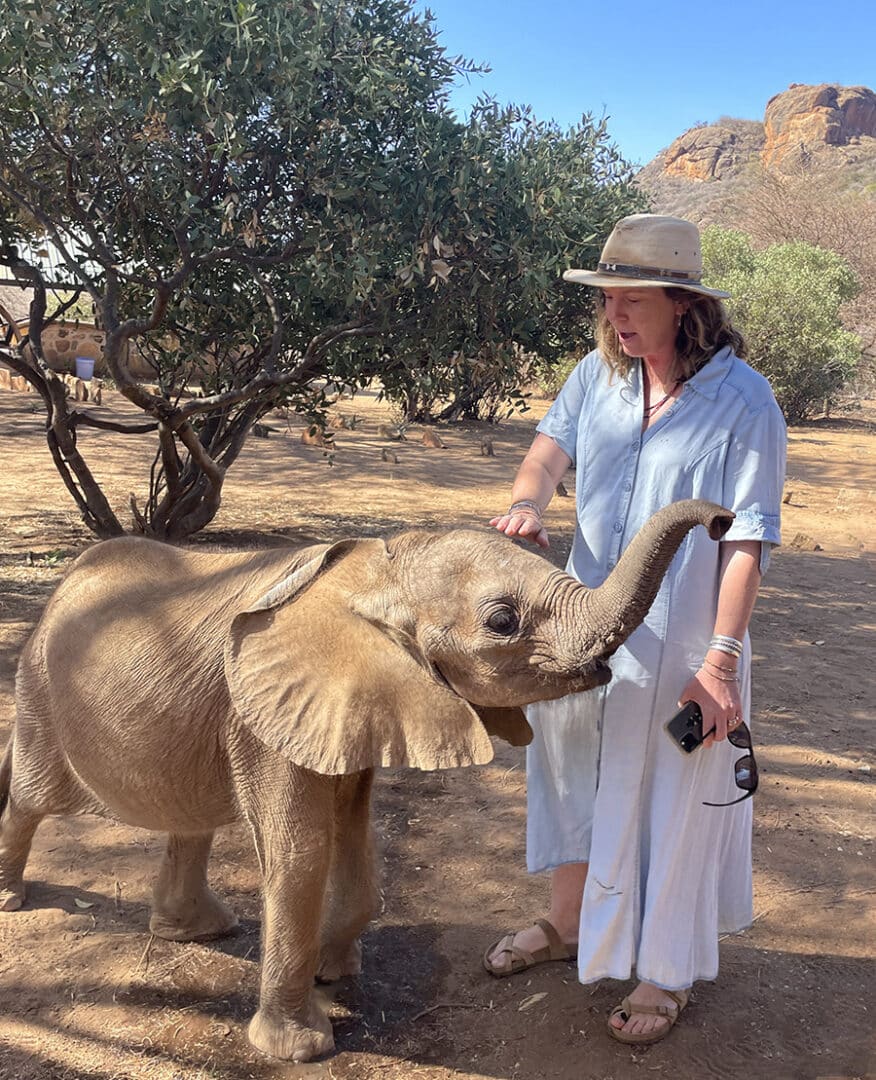
Katie also explained the financial challenges of running the orphanage. Feeding and providing healthcare for 40+ elephants is a monumental undertaking! It has been made more challenging by the current drought that has seriously impacted this area of Kenya. The elephants drink close to 10,000 bottles of milk a month! That comes at a cost of almost $100,000. The financial commitment required to offer the best possible care relies heavily on the generosity of private donors.
An Introduction by a Mutual Friend
During my conversation with Katie I was gobsmacked (there is no other word) to find out she recognized me. It turns out she was a fan of my dog Pluto and a member of the Plutoverse! It was quite an emotional moment for me to realize that Pluto had connected me to this remarkable woman–on the other side of the world–who was dedicated to saving elephants. For those of you reading this who discovered my photography through Pluto, I do not think I have to tell you how profound, and yet, not at all surprising it was to me, that my buddy orchestrated this very special meeting. She had a plan…
Long’uro and his New Normals
I thoroughly enjoyed watching and learning about the Reteti elephants. It was also fun to meet the resident giraffes that are being cared for at the sanctuary and having a 2-week old Gerenuk seek me out and give me a kiss on the cheek! I was particularly impressed with the tour of the kitchen. My gratitude goes out to the caregivers and staff who generously took the time to explain their work. I left hopeful for the future–and determined to help.
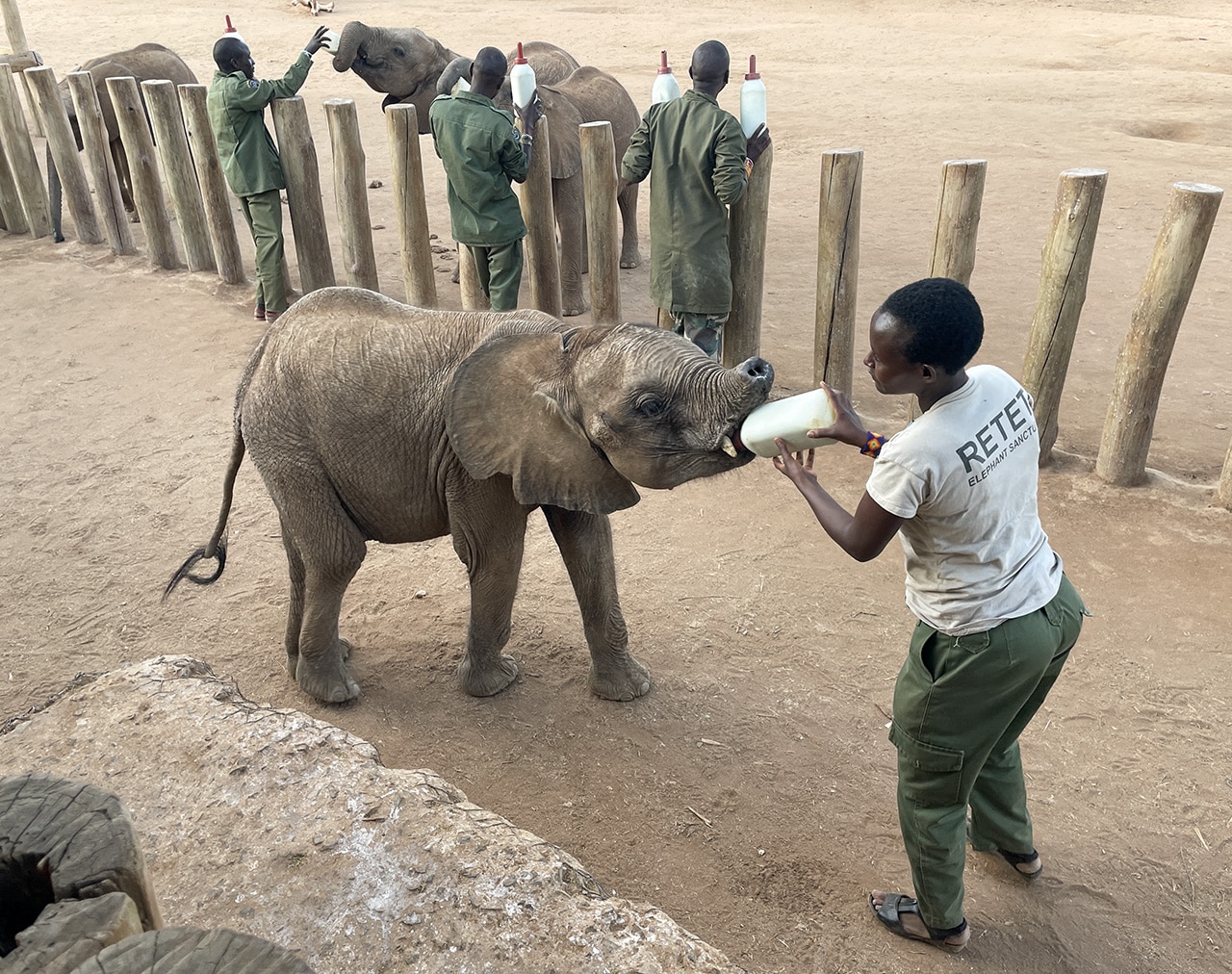
It was meeting a very spunky and courageous orphan named Long’uro, that I came to believe Pluto may have had a spiritual paw in guiding me to the Reteti Elephant Sanctuary. In the Samburu language, Long’uro means “something that has been cut.” In the case of this feisty young elephant, it refers to his little trunk. Long’uro was rescued after falling into a well. He was one month old. While he struggled to keep himself alive, a passing hyena bit off two-thirds of his trunk. While his story might have ended there, it did not! Against all odds, but thanks to the determination of the Reteti team to give him every chance, Long’uro survived! He will soon be three years old.
Some say Long’uro is a “special needs” elephant. When I met this determined little fellow, he was having his bottle. Once he had chugged that back, he moved on to his pellets. (Because he cannot yet use his truck to forage, the pellets are a supplement to his diet.) He used his trunk to maneuver his treats, arranging them so it was easier to push them in his mouth. Watching his determination–and success–at eating his snack, it occurred to me that Long’uro was adapting to his “new normals” and living his best life! I could not stop smiling at this enthusiastic young elephant with his ears flapping and his abbreviated trunk, enjoying his food. I do believe there was a certain little spirit with me on my shoulder, cheering him on!
Collective Compassion for Reteti
If you followed me, or Pluto, during these past couple of years, you are likely aware of the various fundraising initiatives that she rallied her friends to help with. She was a champion of collective compassion and believed in the power of her Plutoverse peeps. Pluto and I shared a love of elephants–she spoke about them on more than one occasion. I knew when I met Long’uro he was a kindred spirit to Pluto. She would have compared his trunk to her own wobbly legs–nothing more than one of life’s new normals to adapt to. She would have said; “Mom, he has a great supportive family to help him keep living his best life!” And, WHOA–she most certainly would have been impressed with his snacking technique!
I know there are many of you reading this who will help make a difference in the life of Long’uro and his extended elephant family! This dedicated and essential sanctuary relies heavily on donations from people like us. People who care about wildlife and want to be part of making a difference. There are many ways you can help. You can buy them milk. Or, adopt one of the Reteti elephants? Every donation, large and small, will help continue to provide a safe and nurturing home for these elephants. If you are not in a financial position to donate, you can be an ambassador for the elephants, sharing their stories and encouraging others to help.
Tell Them Pluto Sent You!
These past two years I have witnessed first-hand the incredible difference a small community can make through collective compassion. I hope you will join me and support Long’uro and his family at the Reteti Elephant Sanctuary! Help them all live their very best lives. They are our future.
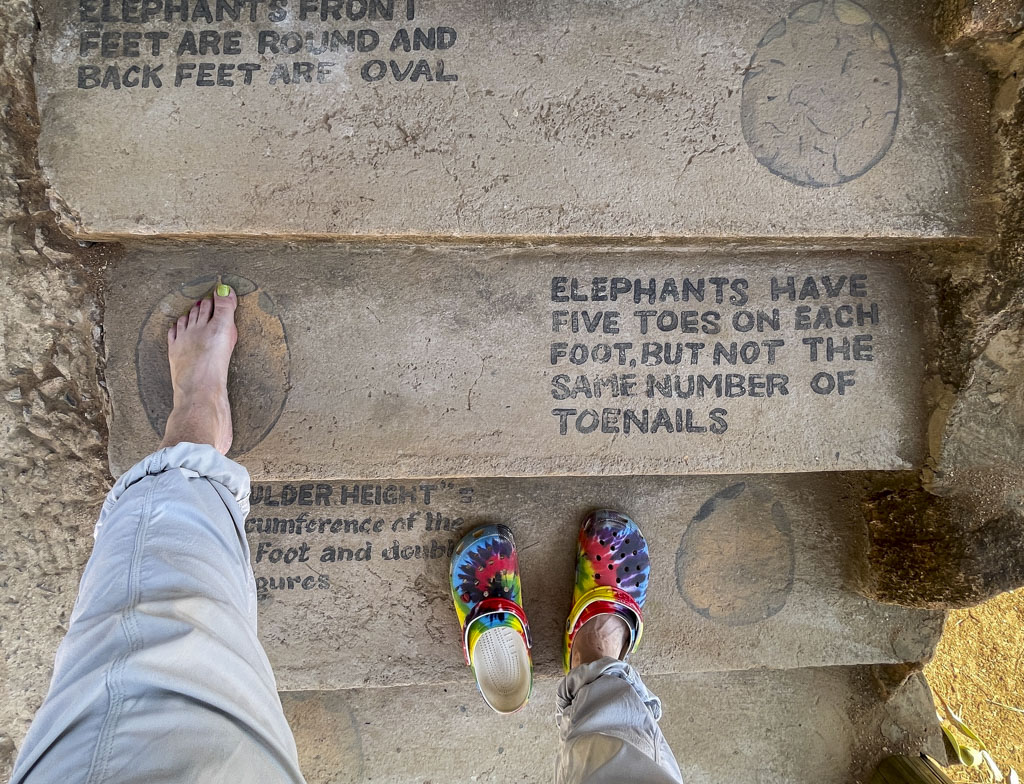
Join NJ Wight on Safari
Wild! Adventure: A 10-Day Kenya Safari with NJ Wight
Join me for a fabulous small group, 10-night safari in wild Kenya! I have spent over 300 nights across seven countries in Africa — all of them remarkable. But there are very good reasons I have returned to Kenya multiple times. To me, it is the Africa of the imagination. (Make sure to read Masai Mara Musings for more.) Everything I imagined an African safari could be, I have found in Kenya. Wild and wide-open spaces, gorgeous light, big skies, a blanket of stars, friendly people and more wildlife than I have seen anywhere else. It is my happy place and I cannot wait to show it to you! We are going to have a Wild! time.
Visit Kenya’s Best Wildlife Parks and Conservancies!
We will spend our time looking for and watching the varied wildlife and bird populations in various National Parks and private conservancies, including the exceptional Mara Conservancies. (Not all trips visit the same areas.) Tourism in the conservancies is limited in to a small number of camps. The very low ratio of game viewing vehicles to land area is aimed at ensuring the best possible experience of wildlife viewing while minimizing environmental impact. In addition, the communities living in the conservancies financially benefit from your stay. If an African safari is on your bucket-list–now is the time!
NJ Wight Private Safari
I also accommodate private group trips. If you are looking for an exclusive safari for a special occasion, interested in exploring with your family or you have a special group of friends and would like me to organize and guide you on your trip of a lifetime, please get in touch and we can start planning!
If you are interested in further details about travel, please contact me for additional information.
If you are unable to travel on safari, but would like to join me virtually, consider my ko-fi.com/njwight memberships!
Safari Dates
2025
January 15 - 25th – SOLD OUT
June 29 - July 9th - SOLD OUT
July 11 - 20th - SOLD OUT
Oct 28 - Nov. 7th - SOLD OUT
2024
January 27 - February 6th – SOLD OUT
February 7 - 18 – PRIVATE
June 19th - 29th – SOLD OUT
September 13th - 22nd – SOLD OUT
2023
February 25 - March 6th - SOLD OUT
July 8th - July 17th – SOLD OUT
October 12 - October 21 - SOLD OUT
October 23 - November 1 – SOLD OUT
(Please note: I am currently accepting names for a cancellation list for 2024 and 2025. Please contact me for additional information.)
Read comments from former Guests
From Margaret P, guest in February 2023
All my life I had dreamed of Africa and all the wildlife that seemed to be too beautiful to be true. Finally, on my 70th birthday I decided to go on a safari. I contacted NJ Wight knowing that she was an amazing wildlife photographer and conservationist. NJ Wight proved to be a great Safari guide - everything from selecting the camps to making sure we all had an awesome camp experience. We spent eight nights in two different camps in the Maasai Mara, in Kenya. The tents were luxurious with top quality beds and indoor plumbing with hot water. The food was first class, crafted by a talented chef and his assistants. And the animals! Oh the animals! From the very first to the very last game drive I was awe struck by the vast variety and abundance of animals in the Mara. The experienced drivers were like magicians - able to spot animals where all I could see were a few bushes. We saw and photographed the all big and small game, and they're young, of my childhood imagination. It was a trip of a lifetime - and every night I go to sleep thinking of wonderful Kenya. My dream did come true!”
From Mary Beth M, guest in February 2023
A safari with NJ Wight means you will learn so much about the animals and the people of the area. The trips are highly organized and fun with impeccable choice of camps. I want to go back again......and again.
From Sheryl Berwick, repeat guest in October 2022
Traveling on safari is a bucket list destination that is guaranteed to impress... When planning your trip of a lifetime, put your faith in Nancie. An award-winning wildlife photographer with dozens of excursions, hundreds of game drives and countless nights under the stars throughout the African bush, you will be well served to take advantage of Nancie's experience and trust her to leverage both her familiarity with different regions and network of local contacts to ensure that every detail is considered with the goal of making your trip an absolute success.
From Kevin M, repeat guest in October 2022
While a return trip anywhere provides lofty expectations to meet the fond memories of previous journeys, our second adventure to Kenya under Nancie's experienced guidance not only satisfied these expectations, but exceeded them.Our accommodations in the conservancies balanced comfort with an authenticity you would expect from being in the heart of the Maasai Mara wilderness. Food and beverages were wonderful and catered to every dietary requirement. The wildlife sightings were abundant and we enjoyed all manner of behavior… the majestic presence of elephants, the playful whimsy of lion cubs, the drama of a leopard protecting its kill… and countless times the camera was put aside in favour of the cell phone for photography, as the animals were too close for the zoom lens! Bottom line, whether you choose to go with family, friends, your partner... or alone... you must simply go
From Lynn F, repeat guest in October 2019
“I have now experienced two safari trips hosted by NJ Wight and perhaps the greatest endorsement I can offer is that I am already planning for my third Kenya safari with Nancie! From the moment we decided to go on this amazing adventure, Nancie guided us all the way, starting with helpful hints on what/how to pack, ideal tourist destinations in Nairobi, and photography tips. Because she has been to Africa numerous times, we trusted Nancie’s experience and leadership as to how the trip should unfold. Nancie was our guide on the ground and, with her warm, welcoming (and fun!) manner, we could not have had a better host!
The experience of being in the bush, with the animals so close, was unbelievable. Our guides seemed to know exactly where to find a den of lions and herds of elephants, and they always did their best to accommodate what we wanted to see, i.e. an exciting cheetah chase or lions "making love!" I am proud of the fact that, on both trips, I saw the “Big Five” – which is highly unusual! Most important is the fact that I always felt safe, even when a leopard walked directly under our jeep and an elephant tried to engage us all in a staring contest (hint: the elephant should always win!). People call it “the trip of a lifetime” but the reality is, once you have experienced Africa, you will want to return! And having Nancie as your guide is the perfect way to travel!”
From Angie D, guest in March 2018
“NJ Wight was an amazing safari guide — very knowledgeable about all the varied wildlife we saw (and we saw so many animals!), and she curated the BEST camps and areas to visit on this Kenya safari. Also, having a smaller/more intimate group was very comfortable, the lodging was beautiful and the vehicles were roomy. It had been years since I had taken photographs and I had bought a new mirrorless digital camera for my safari, and NJ has great photography tips to get gorgeous shots!”
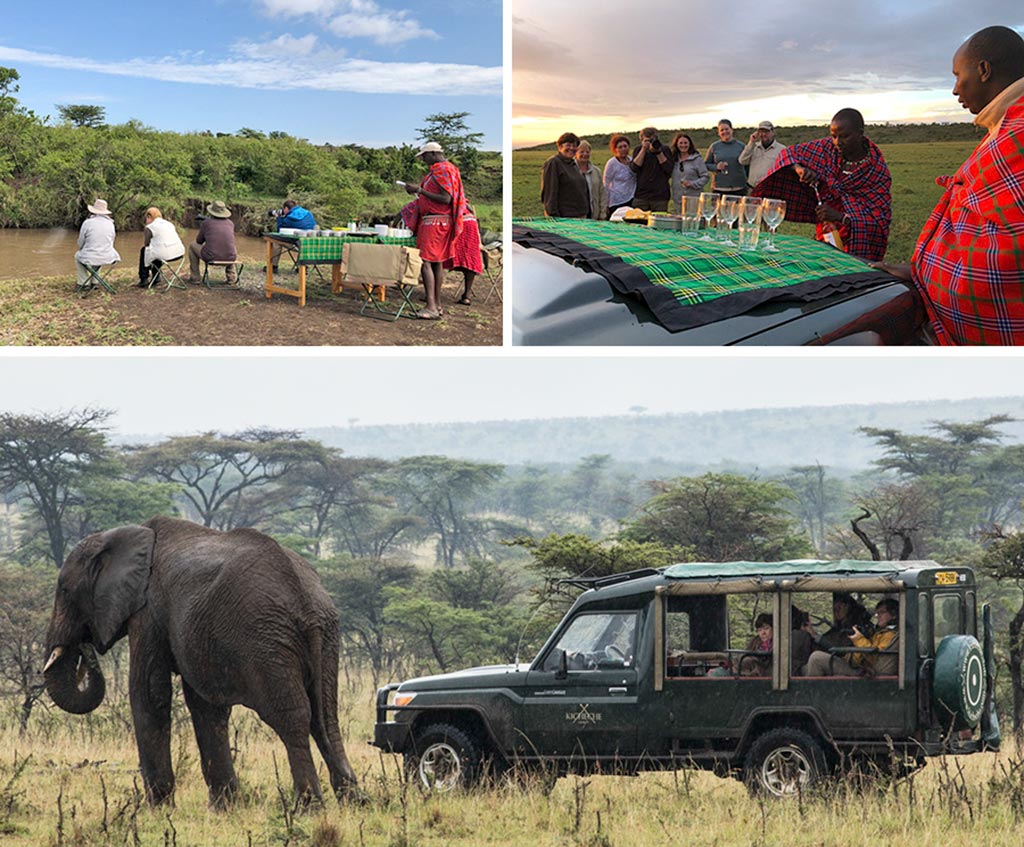
Take a Ride in the Land Rover
Wondering what it is like to riding in a Land Rover out on safari? Well, it is hard to put into words, but occasionally I take my hand off my Canon 5D MIV and grab my iPhone to capture some shaky safari snippets. Watch the video at the top of this page for a compilation of moments from my happy place.
Snow Ghost: Photographing the Snowy Owl
As winter rolls along, I am wondering what is in store for my work as I hunker-down at home in Montreal. I have not ventured out with my camera in months! The winter of 2019-20 was memorable as it was the year I met my first snowy owl! While this truly magnificent owl is the official bird of my home province of Québec, I had never actually seen one in the wild. Last winter changed all that.
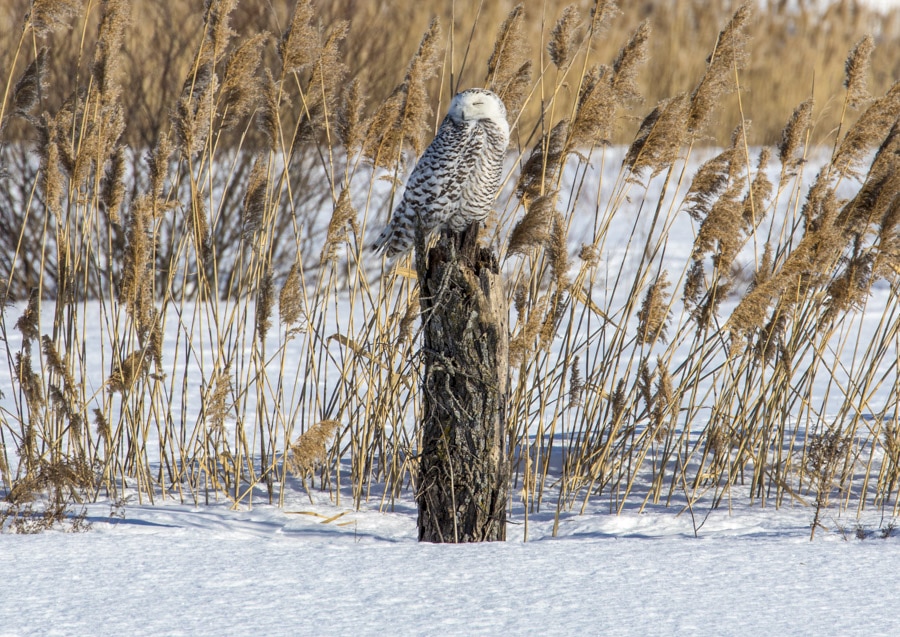
These large owls migrate down from the Artic during the winter months and can be found in areas with open fields–their preferred hunting grounds. They like to perch on the ground or on low fenceposts where they will patiently wait for their prey, usually a small rodent. Have you ever tried looking for something white, in a field of white? It can be a challenge!
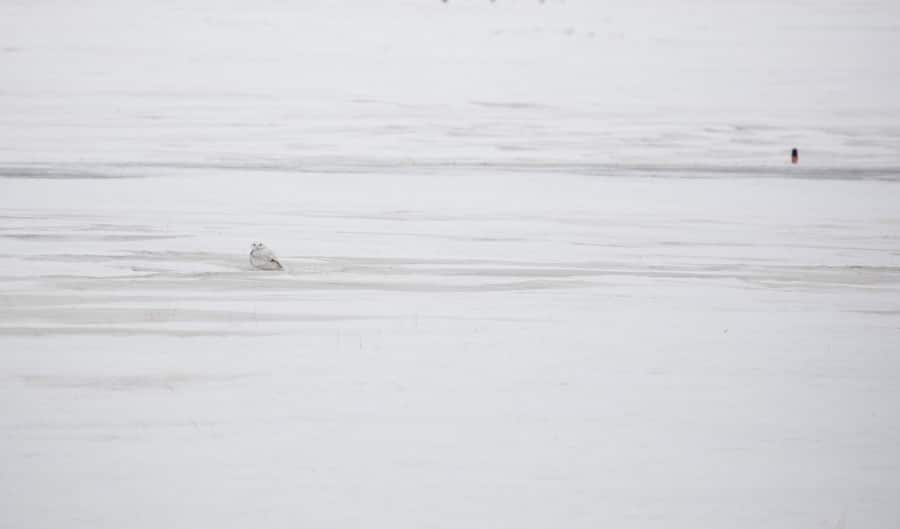
Snowy on a Snow Bank
Luckily, I was able to spot a couple of snowy owls for some closer encounters. However, the fellow I spent time with insisted on hunkering down between two very dirty snowbanks, making for a very unattractive photo shoot. Still, it was a thrill to see one of these birds up close.
On my return visit the sides were overcast and I found him in the same area, once again sitting up on a dirty pile of snow. I decided to try something a little different...
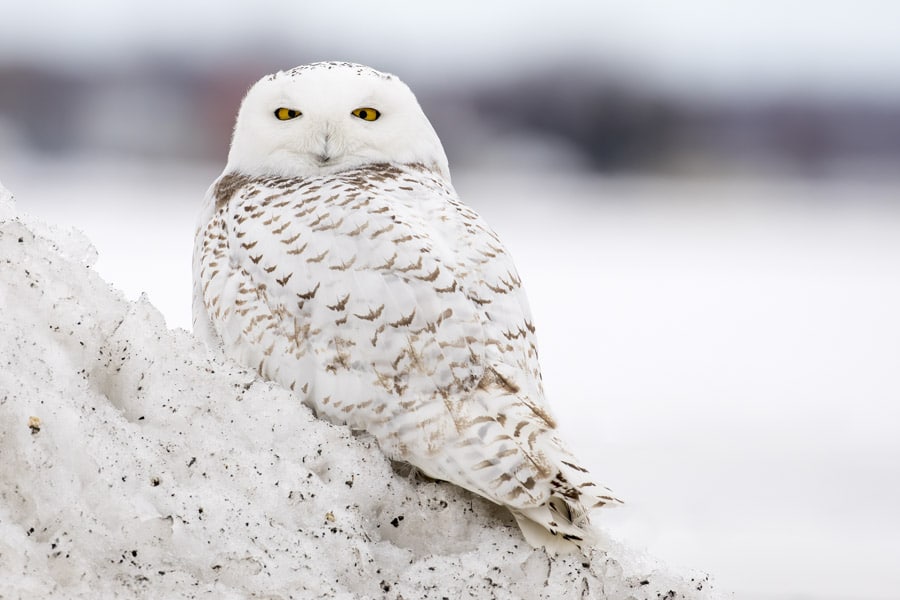
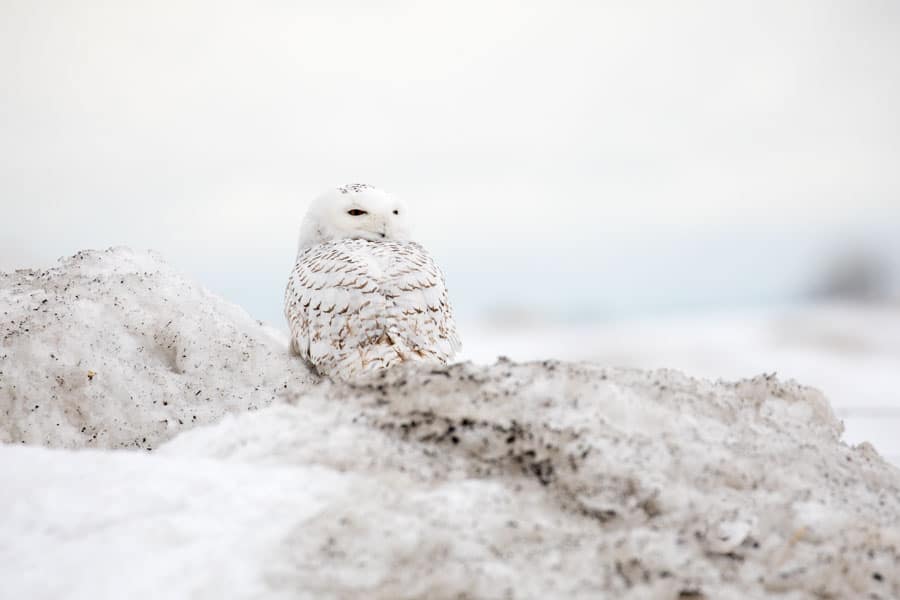
Ghostly Snowy Owl
I wanted to create an image that evoked more of an ethereal feel of this exceptional creature, having him appear almost ghost-like. I dug a trench in the snow and got down on my belly, burying my lens and pushing snow away from part of the lens opening. I really wish I had thought to tuck my shirt in before I did this–I can assure you that snow on the belly can motivate you to work quickly! The owl was very co-operative sitting in one place, surveying his kingdom although I am pretty sure I saw him roll his eyes at my antics.
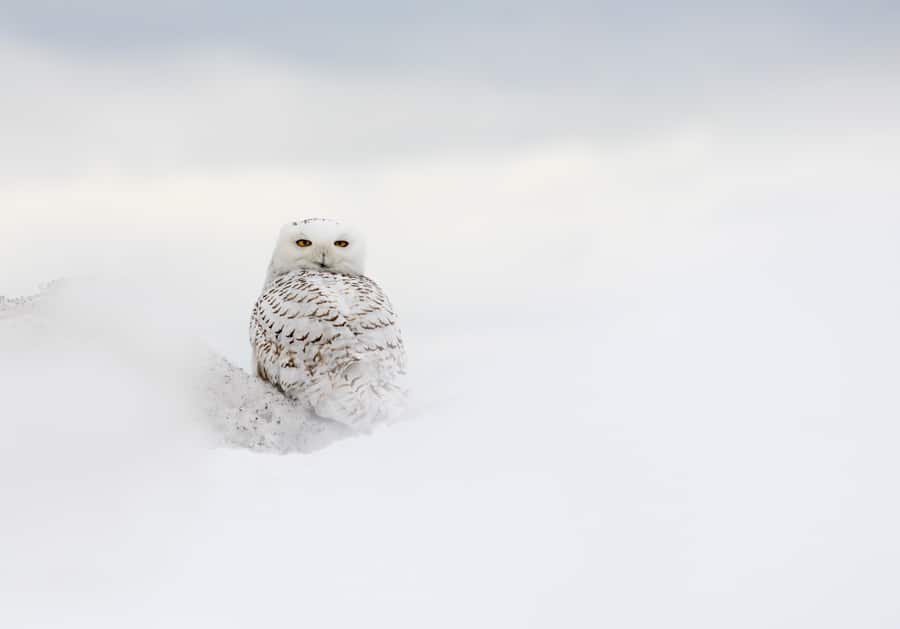
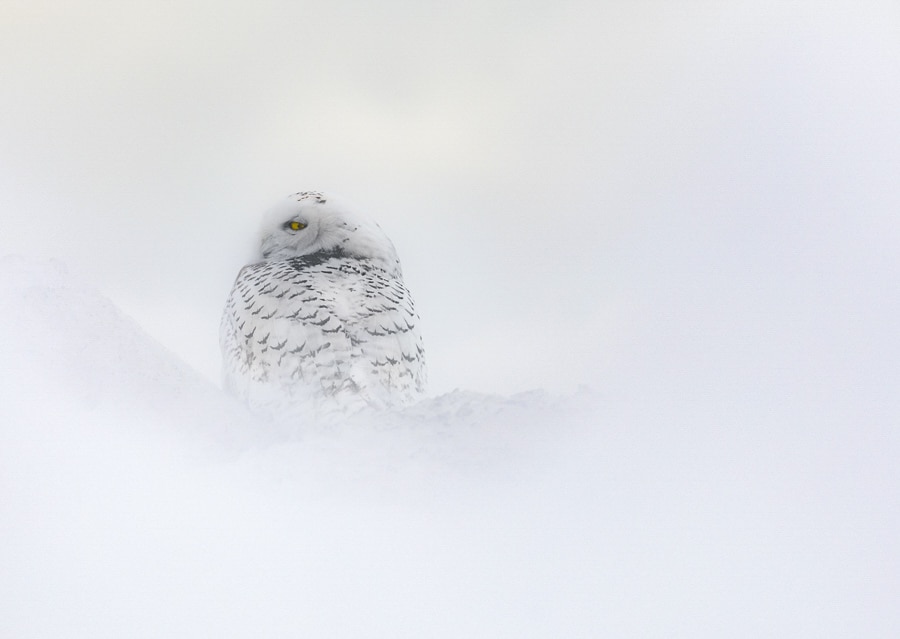
Hopefully I be lucky this winter and have another chance to photograph one of these magnificent owls that live here in our backyard in Québec.
One more thing...
Thank you very much for visiting my blog. I support myself as an artist with my photography and writing. If you enjoy my content and would like more, please consider supporting me on KO-FI.COM Becoming a member of the Armchair Wanderers or one of The Wild Bunch will give you access to exclusive member only content-including behind-the-scene safari updates from my travels. Thank you for your ongoing encouragement and promoting my passion.
Visit the Oh Canada! GalleryWorld Rhinoceros Day 2020
A mountainous marvel of animal engineering, the rhinoceros is like no other. Leathery and lined, massive and muscled, his noble horn a cautionary prelude to a quiet, determined stare. The rhino is at once, a prehistoric relic and a 21st century icon.
Rhinoceros Poaching Statistics
I cannot imagine a world without rhinoceros. In South Africa, where approximately 80% of the world rhino population lives, rhino poaching continues at a rate of almost two a day. While the numbers are finally on the decline, there are still far too many killings. (http://www.savetherhino.org)
Rhinoceros I Have Known
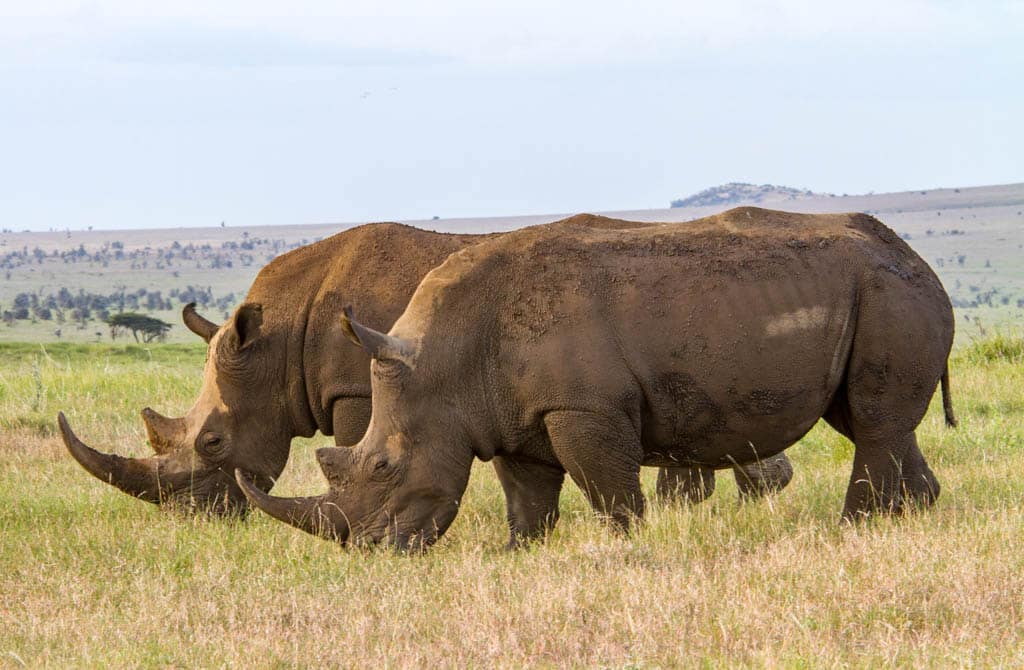 In the past 13 years I have encountered wild-living Rhinosceritidae more than 20 times in three countries. Each and every time I have wondered if it would be my last encounter. As a visual storyteller, my goal is to make connections with the sentient beings around us to invoke a passionate awakening in the soul. I push myself to make images that inspire imagination where, in a single moment, the heart might connect with the mind and lead one to think and act in new ways–ways that could end the senseless killing of the earth’s wildlife. The senseless killing of the rhinoceros
In the past 13 years I have encountered wild-living Rhinosceritidae more than 20 times in three countries. Each and every time I have wondered if it would be my last encounter. As a visual storyteller, my goal is to make connections with the sentient beings around us to invoke a passionate awakening in the soul. I push myself to make images that inspire imagination where, in a single moment, the heart might connect with the mind and lead one to think and act in new ways–ways that could end the senseless killing of the earth’s wildlife. The senseless killing of the rhinoceros
Until we truly understand and embrace that we are all connected, we will continue to lose species with no clear understanding of the consequences. So, on this World Rhino Day 2020, I fondly look back and speak to you through the very first rhinoceros I ever photographed. From these very first sightings, years before wildlife photography would become my calling, I was entranced by these massive animals with their magnificent facial ornaments and dinosaur-like bodies. I hope they might spark your imagination and stir your sense of wonder. These images capture but a moment of their glorious story, a centuries-old tale that seems destined for a tragic ending unless we stop the senseless slaughter.
You Never Forget Your First Rhinoceros
I was introduced to my very first black rhinos in the Phinda, South Africa in 2008. Being chased by storms and heading back towards camp, our ranger suddenly throttled the Land Rover over the ditch. He headed off-road, bouncing us straight towards the blackening skies and…two black rhinos! We followed at a safe distance as they grazed towards the hillside. For a brief moment the sun broke through the ominous clouds, spilling a brilliant rainbow behind them. This was truly an African pot of gold. They turned towards us, halting our progress, allowing me to quickly capture one of my very first rhino photos I call Pair of Blacks. (Or, for those of you with loftier imaginations, The Two-headed Rhino.)
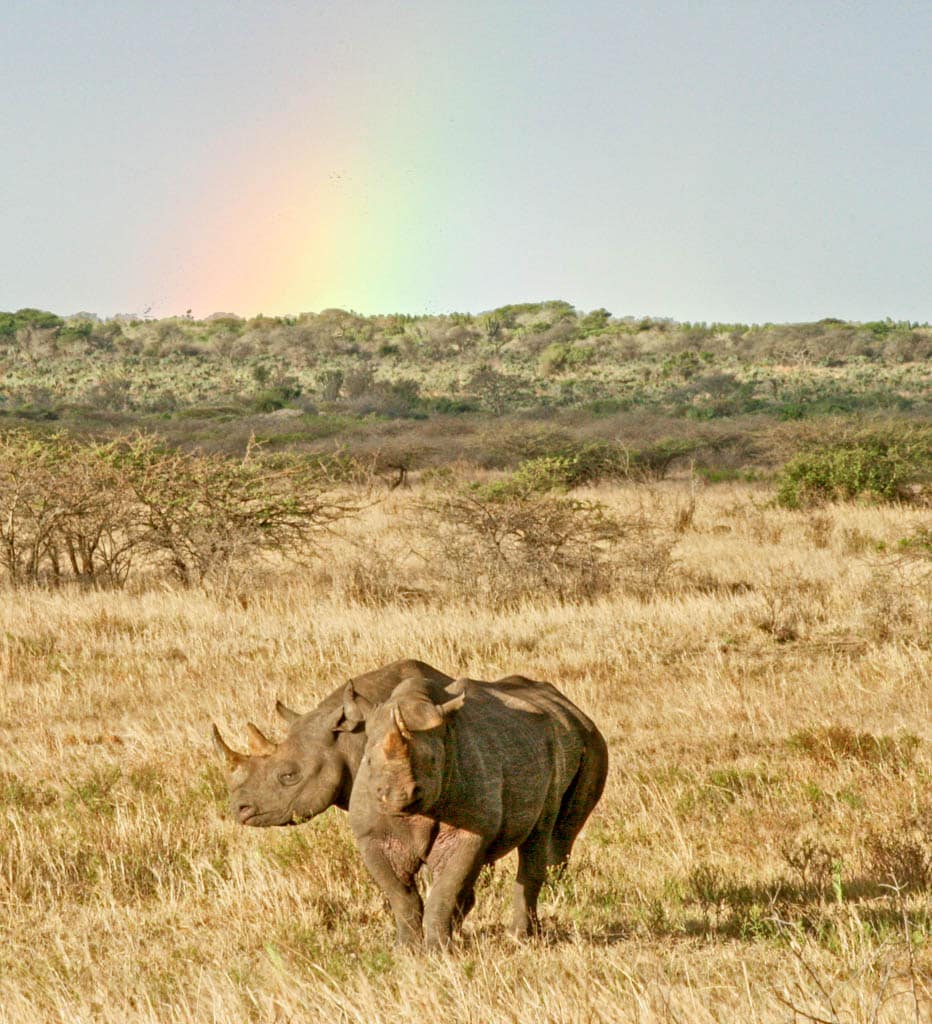
The black rhino has a hooked lip and is slightly smaller than this relative the white rhino. They are browsers and the hooked lip allows them to pull leaves off trees and bushes to supplement their diet of grass.
A Rhino Encounter of a Special Kind
The following day would bring a rhinoceros encounter of a very close kind! Coming up on four grazing white rhinos on the roadside, we pulled over to enjoy their company. They were relaxed and intent on grazing. Unlike the black rhino with its hooked lip, the white rhino has a squared-off lip and relies on grazing.
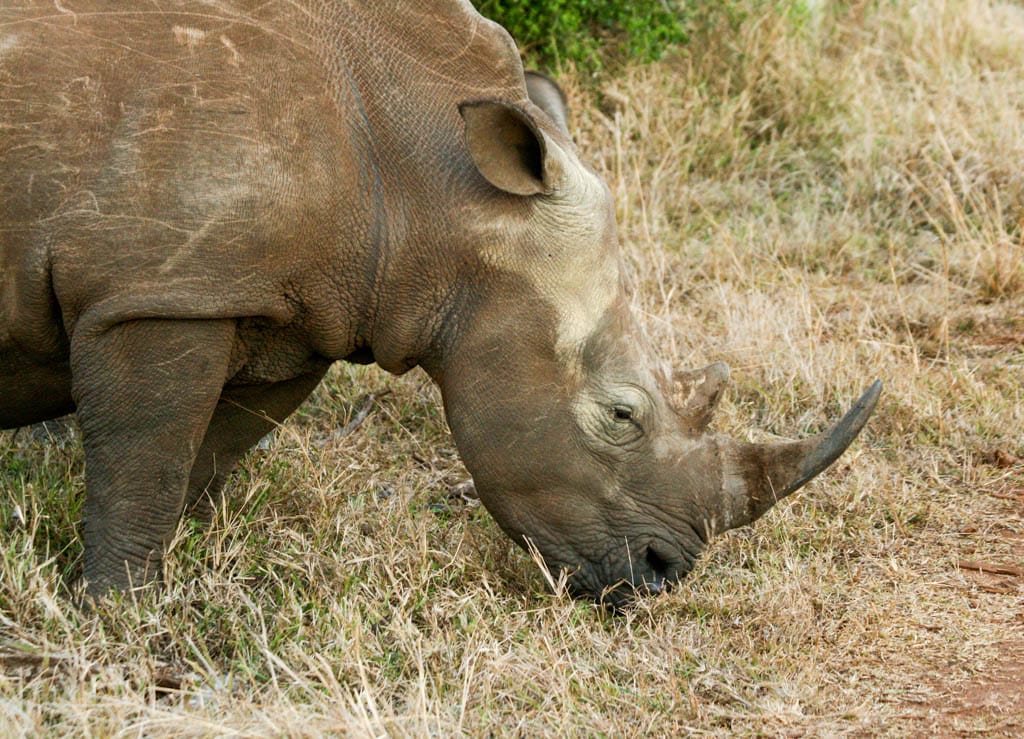
I was sitting up on the back bench the truck, my boot propped up on the open side, when a very calm and massive male began wandering towards me. Coming closer, eyes on mine, his impressive horn dipped well into the minimum focus distance of my 70-300 F4-5.6. He stood still, then sniffed my boot. Seemingly satisfied with my hygiene he slowly backed away and returned to the tall grass on the side of the ditch. It’s a wonder I had the presence of mind to hit the shutter. While the image is somewhat soft, it serves me well to bring back the vivid memory of this magical encounter.
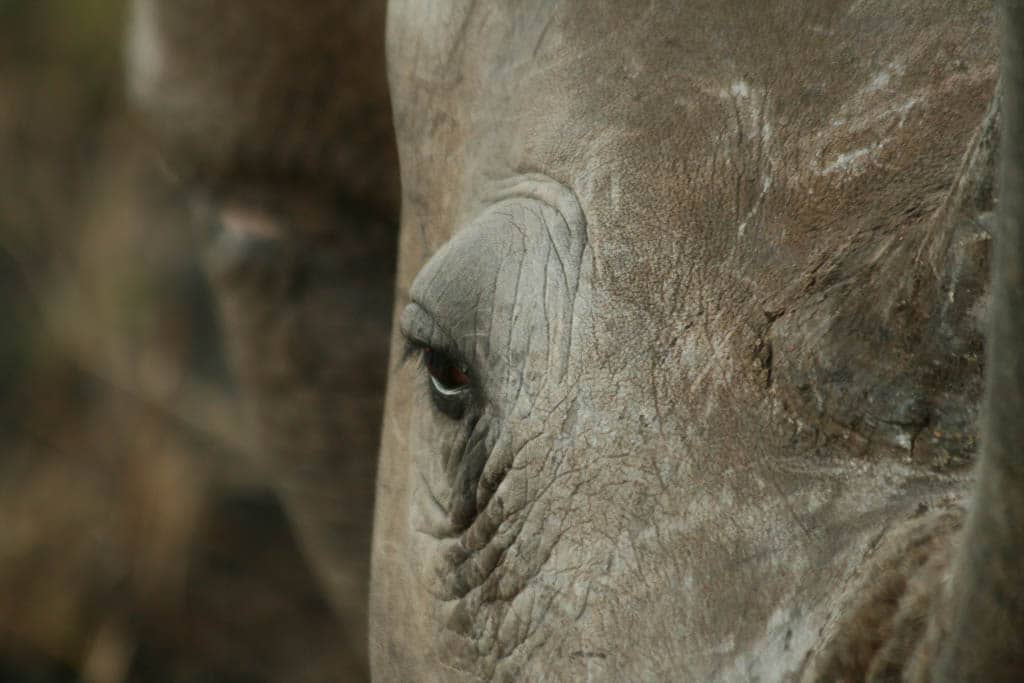
A Wildlife Icon
The rhinoceros is the second largest land mammal in the world–it is a symbol of our wild planet–and it is disappearing at an alarming rate. Of the 5 species of rhinos left on the planet, 3 are now critically endangered, while 2 are vulnerable to extinction. While habitat loss threatens so many of the planets species, the rhinos biggest threat is poaching. Rhino horn is in high demand in the thriving black market in the illegal trade in animal parts. Rhino horn is currently selling for upwards of $50,000 a kilo on the thriving black market in animal parts. We are decimating one of the worlds iconic species to use in mythical potions. Horn is not medicine and we must stop the senseless killing. Education and awareness is vital if we are to secure a future where these extraordinary animals continue to share our planet.
One more thing...
Thank you very much for visiting my blog. I support myself as an artist with my photography and writing. If you enjoy my content and would like more, please consider supporting me on KO-FI.COM Becoming a member of the Armchair Wanderers or one of The Wild Bunch will give you access to exclusive member only content-including behind-the-scene safari updates from my travels. Thank you for your ongoing encouragement and promoting my passion.
The Rhinoceros Gallery Visit the Rhino CemeteryDad-jay: Remembering my Father
My Dad would have turned 89 this week. He passed away two years ago, a few days after his 87th birthday. This is the story of Dad-jay, a blue jay who came to see me when my Dad passed, and who continues to keep me company today. Some of you may have read parts of this story before, some of you may be reading it for the first time, but either way, I hope you find some solace and joy in this true tale of how nature holds a place in our hearts.
My Dad’s name was John and he was a first generation Scottish Canadian. He had beautiful blue eyes, a great sense of humour and could cut a mean jitterbug! He passed away in September of 2018 after a struggle with Alzheimer’s. A couple of days after he died, I woke up with vivid thoughts of my Dad. I got up, made my coffee and looked out on the back deck. There was a gorgeous blue jay sitting looking back at me.
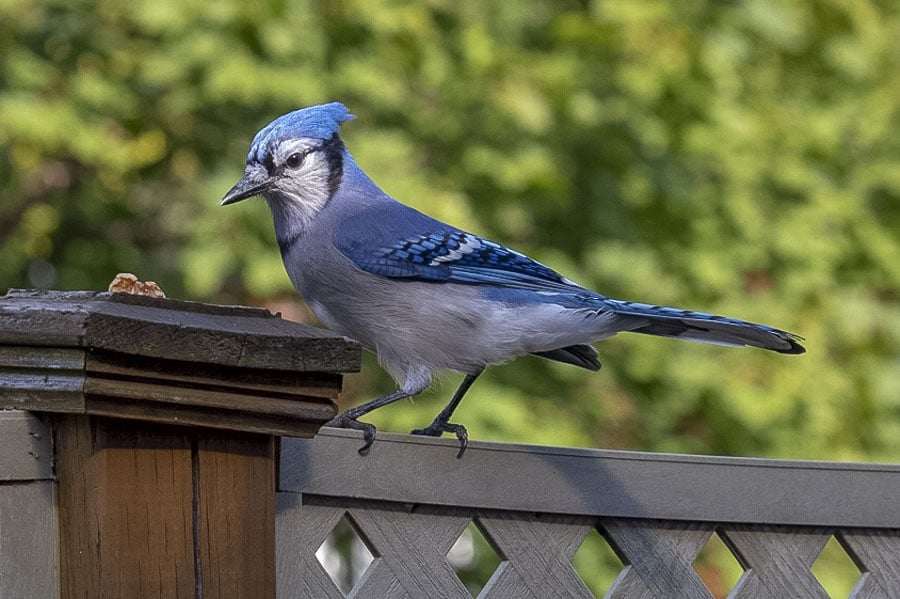
In 14 years blue jays have NEVER come near my deck. In fact, in all my years photographing birds, as soon as I would spot a jay on any of my hikes, they would disappear before I could raise my lens. But this guy was sitting right out on the deck, just feet from the back door. I grabbed some nuts from the pantry and opened the door, expecting him to fly off, but he stayed right where he was. I took a few steps towards him and left the nuts on the rail beside him. Before I could step back inside, he hopped over next to me and picked up a couple of snacks. It was utterly bizarre and beautiful!
My Dad had stopped eating towards the end of his life. The blue jay must have eaten and cached over 30 nuts that morning and all I could think of was that my Dad was ok. He was letting me know he was eating again.
My Companion in Sorrow
In the weeks that followed, Dad-jay continued to visit me every day or other day, while I mourned my Dad. I was in the middle of a kitchen renovation and the workmen could not believe it. Dad-jay look in the window for me, the workmen would call me and I would go out with some nuts. They would all stop and watch and take pictures! He was also fine with Pluto visiting, and she was quite curious about this special visitor getting snacks!
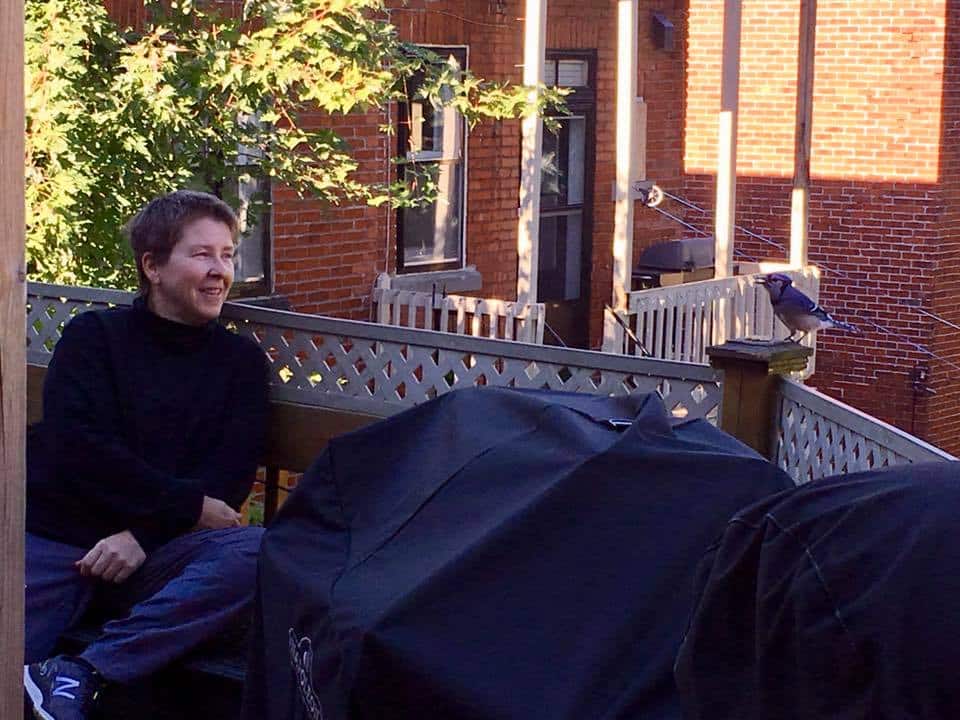
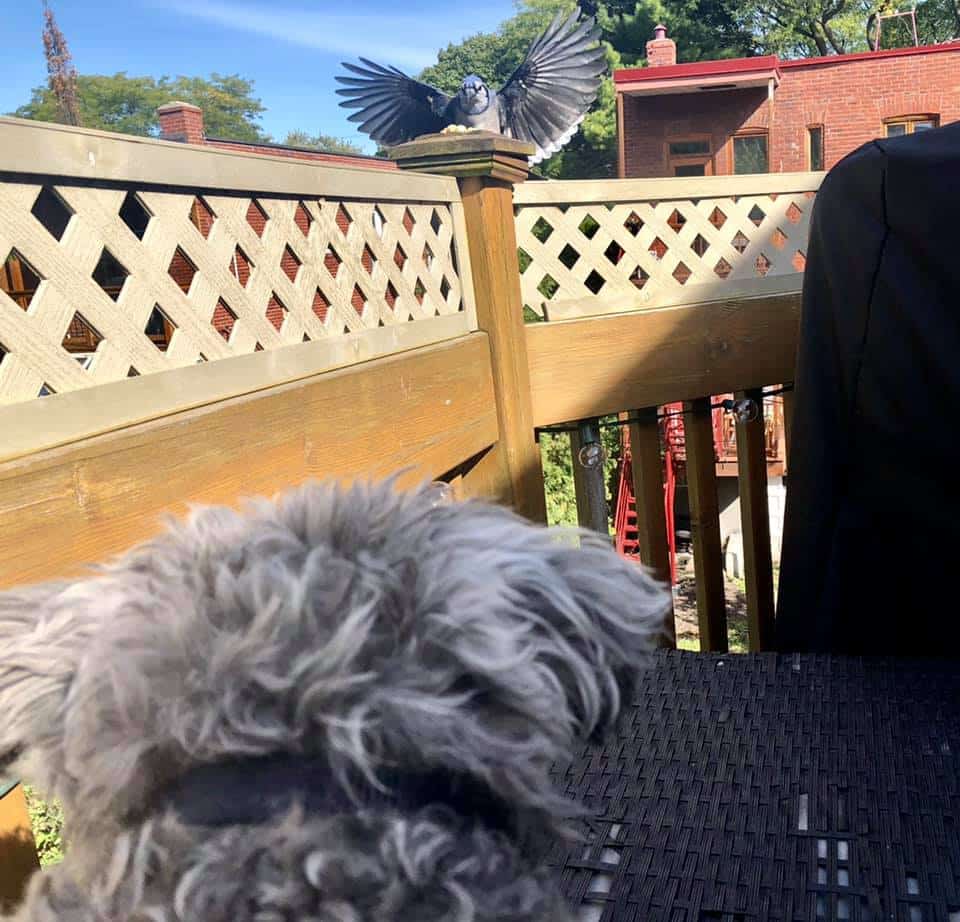
One day I was out on the front porch and he came to the wires above, called incessantly to get my attention. Once I looked up, he flew back and sat in the dining room window at the other end of the house. He sat there watching me as I came down the hall to get his nuts. He started bringing his lady-jay friend and although she was a little more timid, she enjoyed the nuts as well
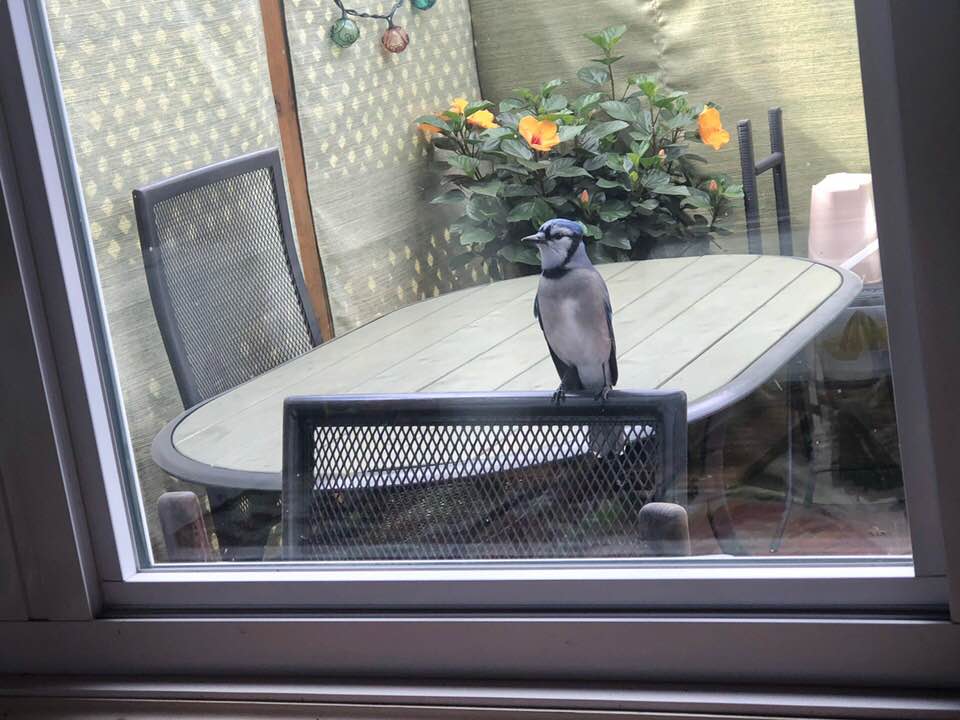
Dad-jay's Final Good-bye
A few weeks later, on the day we would lay my Dad to rest, he came to see me in the morning. I was making Rice Krispy squares–my Dad ate RK’s every morning of his adult life. We had a nice visit and I sat next to him and shared some peanuts. The following day at the reception, I dropped everyone at the door and went to park the car. When I got out of the car, a blue jay called from the trees. At the time, I thought it was his final goodbye, but I would be wrong.
Several months later, I had to undergo surgery. When I woke that morning, he was back! I loaded the rail with peanuts and he took them one by one, caching them around the hood. When a second death struck the family a couple of months later, Dad-jay arrived and stayed a couple of days, offering some mysterious reassurance that all was well in the afterlife.
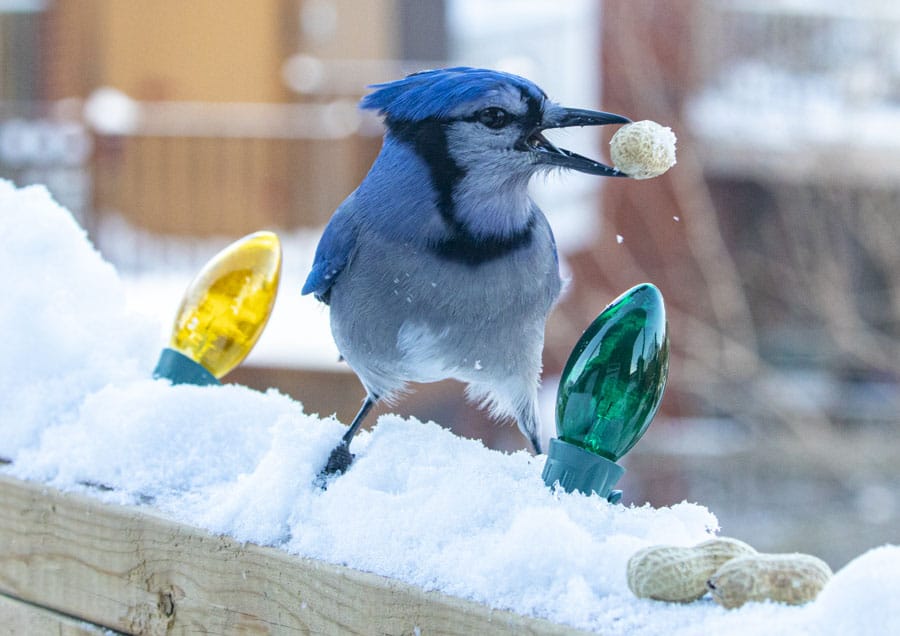
A year passed and on the anniversary of my Dad’s death, this remarkable bird was in the kitchen window waiting for me, helping me get through that particularly tough day. His girlfriend, now a little less nervous, and a smaller juvenile joined him.
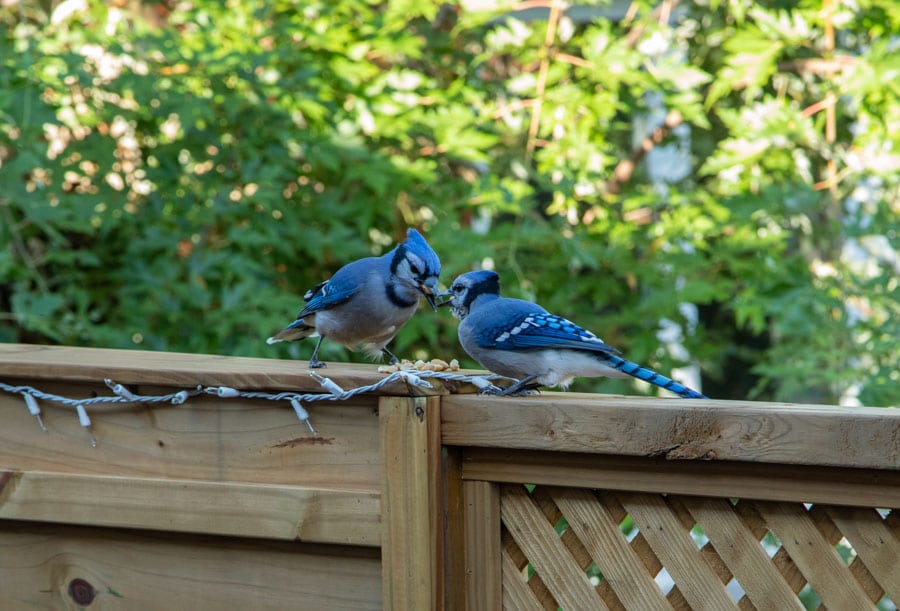
Another Anniversary and Dad-jay Returns
For two years Dad-jay has stopped by at just the right moments in time. I am often asked how I know it is the same blue jay? I just do. He comes to the same window, perches in the same spot and spends time next to me. For me, there is no doubt.
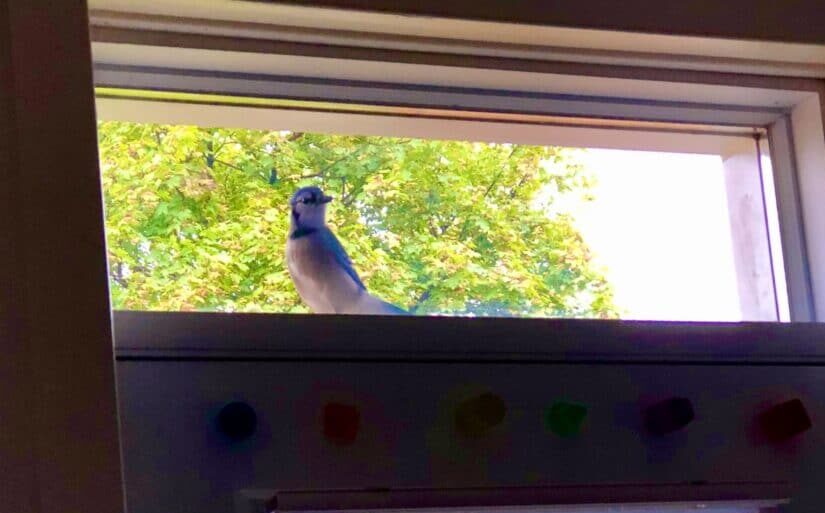
Last week, as the anniversary of my Dad’s death approached, he showed once again–in full moult! This time there was another pair with him and I feel strongly they are his family. They are timid, swooping in to pick up a nut and then quickly flying off. But not him. He still sits in the window or will hop over and stand right next to me as he chooses his peanut. He actually picks them up and shakes them, choosing to fly off with what I believe is the heaviest one!
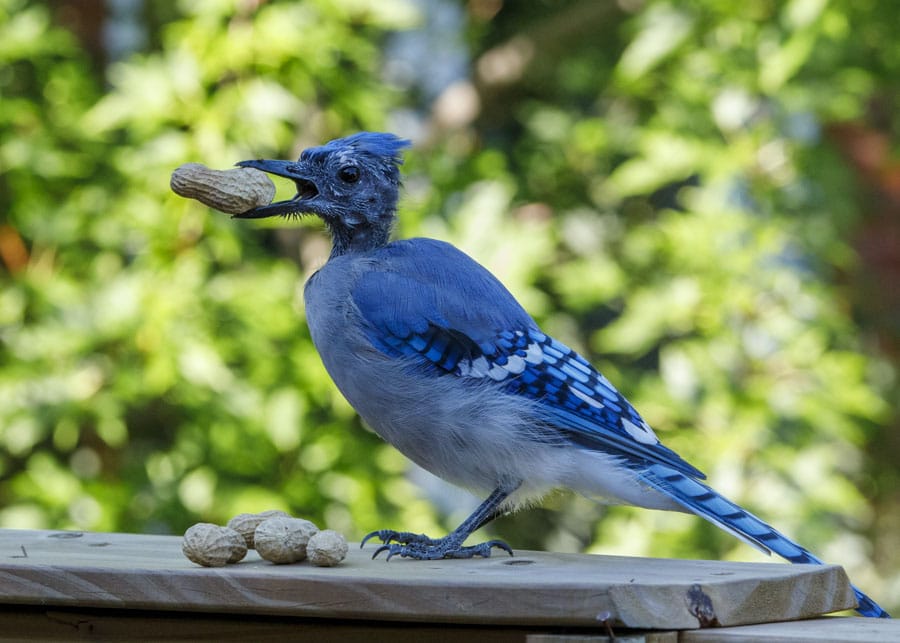
I am delighted and reassured he continues to visit. Knocking on the window or calling until I show up, he stays patient by the backdoor. I continue to thank him for his company. I no longer question the wonder of it all.
Miss you Dad.
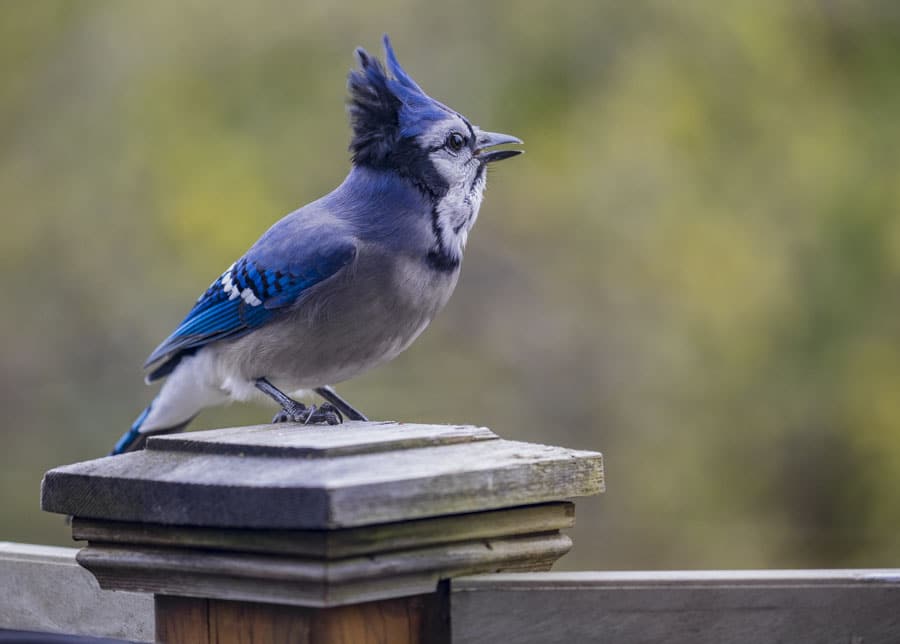
Thanks for supporting my work!
If you enjoy my content, please visit my ko-fi pages and consider becoming a member of the Armchair Wanderers or the Wild Bunch! Ko-fi members have access to exclusive images, videos and stories not posted anywhere else–including behind-the-scenes safari antics while I am on location shooting in Kenya! Membership has its privileges!
African Birds Gallery

